Organic Electroluminescent Materials And Devices
CHEN; Hsiao-Fan ; et al.
U.S. patent application number 16/423278 was filed with the patent office on 2019-12-26 for organic electroluminescent materials and devices. This patent application is currently assigned to UNIVERSAL DISPLAY CORPORATION. The applicant listed for this patent is UNIVERSAL DISPLAY CORPORATION. Invention is credited to Hsiao-Fan CHEN, George FITZGERALD, Sean Michael RYNO.
| Application Number | 20190389892 16/423278 |
| Document ID | / |
| Family ID | 68981319 |
| Filed Date | 2019-12-26 |
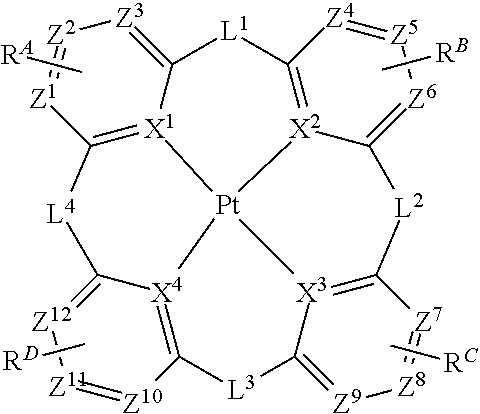
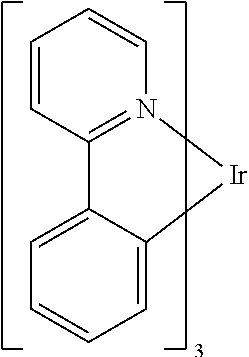
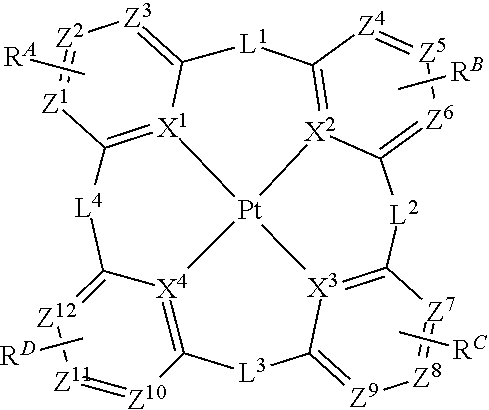


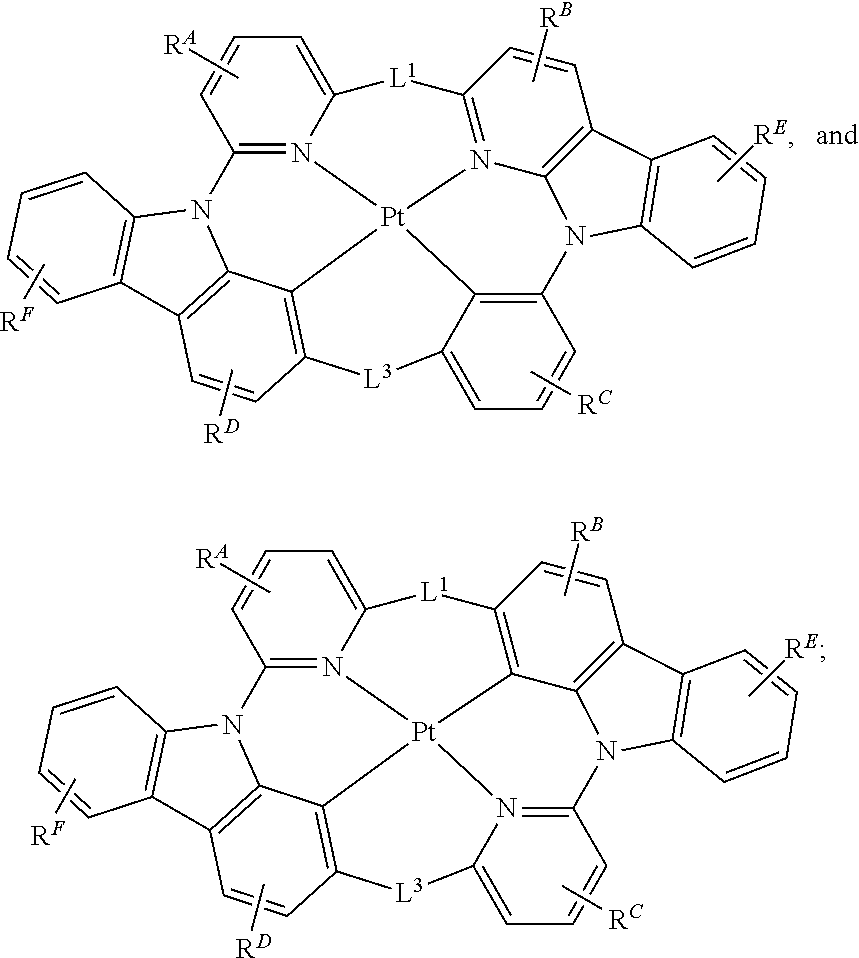
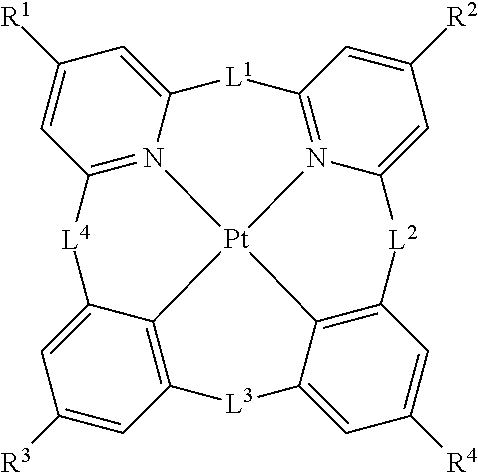
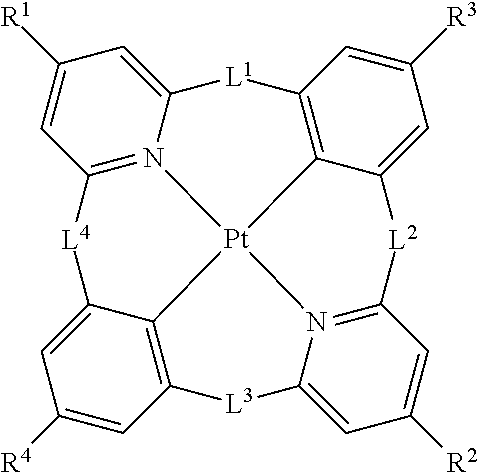
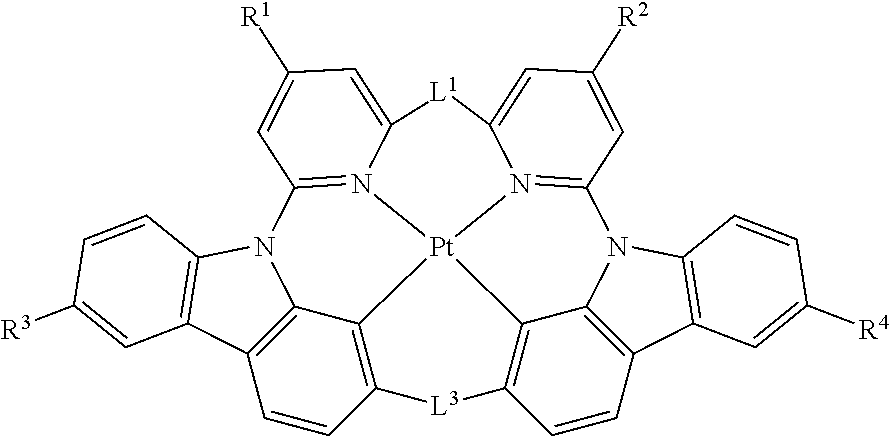
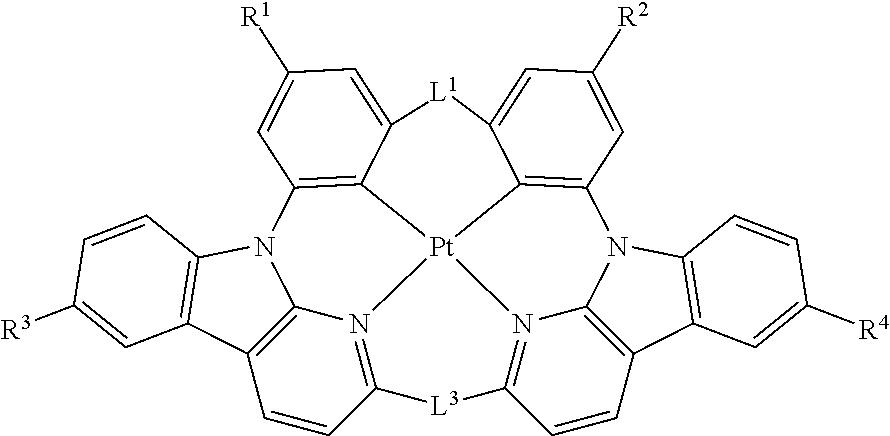
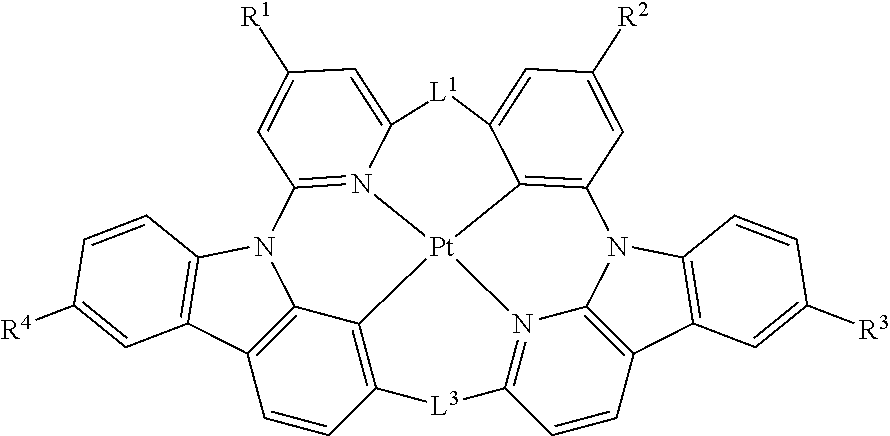

View All Diagrams
| United States Patent Application | 20190389892 |
| Kind Code | A1 |
| CHEN; Hsiao-Fan ; et al. | December 26, 2019 |
ORGANIC ELECTROLUMINESCENT MATERIALS AND DEVICES
Abstract
A compound of Formula I ##STR00001## useful as an emitter in OLED is disclosed.
| Inventors: | CHEN; Hsiao-Fan; (Taipei, TW) ; RYNO; Sean Michael; (Yardley, PA) ; FITZGERALD; George; (Lambertville, NJ) | ||||||||||
| Applicant: |
|
||||||||||
|---|---|---|---|---|---|---|---|---|---|---|---|
| Assignee: | UNIVERSAL DISPLAY
CORPORATION Ewing NJ |
||||||||||
| Family ID: | 68981319 | ||||||||||
| Appl. No.: | 16/423278 | ||||||||||
| Filed: | May 28, 2019 |
Related U.S. Patent Documents
| Application Number | Filing Date | Patent Number | ||
|---|---|---|---|---|
| 62689500 | Jun 25, 2018 | |||
| Current U.S. Class: | 1/1 |
| Current CPC Class: | H01L 51/0067 20130101; H01L 51/0074 20130101; H01L 51/0072 20130101; C07F 15/0086 20130101; H01L 51/5012 20130101; H01L 51/0087 20130101; H01L 51/5028 20130101; H01L 51/0054 20130101 |
| International Class: | C07F 15/00 20060101 C07F015/00; H01L 51/00 20060101 H01L051/00; H01L 51/50 20060101 H01L051/50 |
Claims
1. A compound of Formula I ##STR00128## wherein Z.sup.1 to Z.sup.12 are each independently C or N; wherein two N atoms within a ring are not bonded directly to one another; wherein X.sup.1, X.sup.2, X.sup.3, and X.sup.4 are each independently C or N; wherein two of X.sup.1, X.sup.2, X.sup.3, and X.sup.4 are N, and the remaining two are C; wherein L.sup.1, L.sup.2, L.sup.3, and L.sup.4 are each independently selected from the group consisting of CR.sup.1R.sup.2, SiR.sup.1R.sup.2, NR.sup.1, O, S, BR.sup.1, and PR.sup.1; wherein R.sup.A, R.sup.B, R.sup.C, and R.sup.D each independently represents mono to the maximum possible number of substitutions, or no substitution; wherein each of R.sup.1, R.sup.2, R.sup.A, R.sup.B, R.sup.C, and R.sup.D is independently hydrogen or a substituent selected from the group consisting of deuterium, halogen, alkyl, cycloalkyl, heteroalkyl, heterocycloalkyl, arylalkyl, alkoxy, aryloxy, amino, silyl, alkenyl, cycloalkenyl, heteroalkenyl, alkynyl, aryl, heteroaryl, acyl, carboxylic acid, ether, ester, nitrile, isonitrile, sulfanyl, sulfinyl, sulfonyl, phosphino, and combinations thereof; and wherein any two substituents can be joined or fused together to form a ring.
2. The compound of claim 1, wherein each of R.sup.A, R.sup.B, R.sup.C, R.sup.D is independently hydrogen or a substituent selected from the group consisting of deuterium, fluorine, alkyl, cycloalkyl, heteroalkyl, alkoxy, aryloxy, amino, silyl, alkenyl, cycloalkenyl, heteroalkenyl, aryl, heteroaryl, nitrile, isonitrile, sulfanyl, and combinations thereof; and wherein R.sup.1 and R.sup.2 is independently selected from the group consisting of hydrogen, deuterium, fluorine, alkyl, cycloalkyl, heteroalkyl, alkoxy, aryloxy, amino, silyl, alkenyl, cycloalkenyl, heteroalkenyl, aryl, heteroaryl, and combinations thereof.
3. The compound of claim 1, wherein each of L.sup.1, L.sup.2, L.sup.3, and L.sup.4 are all CR.sup.1R.sup.2, all O, or all NR.sup.1.
4. The compound of claim 1, wherein R.sup.1 or R.sup.2 is an alkyl or cycloalkyl group.
5. The compound of claim 1, wherein R.sup.1 or R.sup.2 is an aromatic group.
6. The compound of claim 1, wherein at least one R.sup.1 is an aromatic group and is joined with an adjacent one of R.sup.A, R.sup.B, R.sup.C, or R.sup.D to form into a ring.
7. The compound of claim 1, wherein X.sup.1 and X.sup.3 are N, and X.sup.2 and X.sup.4 are C.
8. The compound of claim 1, wherein X.sup.1 and X.sup.3 are C, and X.sup.2 and X.sup.4 are N.
9. The compound of claim 1, wherein each Z.sup.1 to Z.sup.12 is C.
10. The compound of claim 1, wherein each R.sup.A, R.sup.B, R.sup.C, and R.sup.D is independently selected from the group consisting of hydrogen, deuterium, aryl, heteroaryl, and combination thereof.
11. The compound of claim 9, wherein each R.sup.A, R.sup.B, R.sup.C, and R.sup.D is H.
12. The compound of claim 1, wherein at least one R.sup.A, R.sup.B, R.sup.C, and R.sup.D is joins with an R.sup.1 or R.sup.2 to form a ring.
13. The compound of claim 1, wherein the compound is selected from the group consisting of: ##STR00129## ##STR00130## and wherein R.sup.E and R.sup.F have the same definition as R.sup.A, R.sup.B, R.sup.C, and R.sup.D.
14. The compound of claim 1, wherein the compound is selected from the group consisting of Compound 1 to Compound 1,719,797,079 that are defined below: TABLE-US-00003 R.sup.1, R.sup.2, R.sup.3, R.sup.4, L.sup.1, L.sup.2, L.sup.3, Compound x Structure of Compound x L.sup.4, L.sup.5, L.sup.6, L.sup.7, L.sup.8 x Compound 1 to Compound 418, 893, 651 having the structure ##STR00131## wherein R.sup.1 = Ri, R.sup.2 = Rj, R.sup.3 = Rk, R.sup.4 = Rl, L.sup.1 = Lm, L.sup.2 = L.sup.4 = Ln and L.sup.3 = Lr, wherein i is an integer from 1 to 33, j is an integer from i to 33, k is an integer from 1 to 33, l is an integer from k to 33 and m, n, and r are each independently an integer from 1 to 11, and wherein x = i + j(j - 1)/2 + 561(k + (l(l - 1)/2) - 1) + 314, 721(m - 1) + 3, 461, 931(n - 1) + 38, 081, 241(r - 1) Compound 418, 893, 652 to Compound 422, 355, 582 have the structure ##STR00132## wherein R.sup.1 = Ri, R.sup.2 = Rj, R.sup.3 = Rk, R.sup.4 = Rl, and L.sup.1 = L.sup.2 = L.sup.3 = L.sup.4 = Lm, wherein i is an integer from 1 to 33, j is an integer from i to 33, k is an integer from 1 to 33, l is an integer from k to 33 and m is an integer from 1 to 12, and wherein x = i + j(j - 1)/2 + 561(k + (l(l - 1)/2) - 1) + 314, 721(m - 1) + 418, 893, 651 Compound 422, 355, 583 to Compound 460, 436, 823 have the structure ##STR00133## wherein R.sup.1 = Ri, R.sup.2 = Rj, R.sup.3 = Rk, R.sup.4 = Rl, L.sup.1 = Lm and L.sup.3 = Ln, wherein i is an integer from 1 to 33, j is an integer from i to 33, k is an integer from 1 to 33, l is an integer from k to 33, and m and n are each independently an integer from 1 to 11, and wherein x = i + j(j - 1)/2 + 561(k + (l(l - 1)/2) - 1) + 314, 721(m - 1) + 3, 461, 931(n - 1) + 422, 355, 582 Compound 460, 436, 824 to Compound 498, 518, 064 have the structure ##STR00134## wherein R.sup.1 = Ri, R.sup.2 = Rj, R.sup.3 = Rk, R.sup.4 = Rl, L.sup.1 = Lm and L.sup.3 = Ln, wherein i is an integer from 1 to 33, j is an integer from i to 33, k is an integer from 1 to 33, l is an integer from k to 33, and m and n are each independently an integer from 1 to 11, and wherein x = i + j(j - 1)/2 + 561(k + (l(l - 1)/2) - 1) + 314, 721(m - 1) + 3, 461, 931(n - 1) + 460, 436, 823 Compound 498, 518, 065 to Compound 642, 014, 505 have the structure ##STR00135## wherein R.sup.1 = Ri, R.sup.2 = Rj, R.sup.3 = Rk, R.sup.4 = Rl, L.sup.1 = Lm and L.sup.3 = Ln, wherein i, j, k, and l are each independently an integer from 1 to 33 and m and n are each independently an integer from 1 to 11, and wherein x = i + 33(j - 1) + 1, 089(k - 1) + 35, 937(l - 1) + 1, 185, 921(m - 1) + 130, 451, 310(n - 1) + 498, 518, 064 Compound 642, 014, 506 to Compound 785, 510, 946 have the structure ##STR00136## wherein R.sup.1 = Ri, R.sup.2 = Rj, R.sup.3 = Rk, R.sup.4 = Rl, L.sup.1 = Lm and L.sup.3 = Ln, wherein i, j, k, and l are each independently an integer from 1 to 33 and m and n are each independently an integer from 1 to 11, and wherein x = i + 33(j - 1) + 1, 089(k - 1) + 35, 937(l - 1) + 1, 185, 921(m - 1) + 13, 045, 1310(n - 1) + 642, 014, 505 Compound 785, 510, 947 to Compound 823, 592, 187 have the structure ##STR00137## wherein R.sup.1 = Ri, R.sup.2 = Rj, R.sup.3 = Rk, R.sup.4 = Rl, L.sup.1 = Lm and L.sup.3 = Ln, wherein i is an integer from 1 to 33, j is an integer from i to 33, k is an integer from 1 to 33, l is an integer from k to 33, and m and n are each independently an integer from 1 to 11, and wherein x = i + j(j - 1)/2 + 561(k + (l(l - 1)/2) - 1) + 314, 721(m - 1) + 3, 461, 931(n - 1) + 785, 510, 946 Compound 823, 592, 188 to Compound 872, 873, 793 have the structure ##STR00138## wherein R.sup.1 = Ri, R.sup.2 = Rj, L.sup.1 = Lk, L.sup.2 = L.sup.4 = Ll, L.sup.3 = Lm, L.sup.5 = Ln and L.sup.6 = Lr, wherein i is an integer from 1 to 33, j is an integer from i to 33, k, l, m, and n are each independently an integer from 1 to 11 and r is an integer from n to 11, and wherein x = i + j(j - 1)/2 + 561(k - 1) + 6, 171(l - 1) + 6, 7881(m - 1) + 746, 691(n + (r(r - 1)/2) - 1) + 823, 592, 187 Compound 872, 873, 794 to Compound 922, 155, 399 have the structure ##STR00139## wherein R.sup.1 = Ri, R.sup.2 = Rj, L.sup.1 = Lk, L.sup.2 = L.sup.4 = Ll, L.sup.3 = Lm, L.sup.5 = Ln and L.sup.6 = Lr, wherein i is an integer from 1 to 33, j is an integer from i to 33, k, l, m, and n are each independently an integer from 1 to 11 and r is an integer from n to 11, and wherein x = i + j(j - 1)/2 + 561(k - 1) + 6, 171(l - 1) + 67, 881(m - 1) + 746, 691(n + (r(r - 1)/2) - 1) + 872, 873, 793 Compound 922, 155, 400 to Compound 971, 437, 005 have the structure ##STR00140## wherein R.sup.1 = Ri, R.sup.2 = Rj, L.sup.1 = Lk, L.sup.2 = L.sup.4 = Ll, L.sup.3 = Lm, L.sup.5 = Ln and L.sup.6 = Lr, wherein i is an integer from 1 to 33, j is an integer from i to 33, k, l, m, and n are each independently an integer from 1 to 11 and r is an integer from n to 11, and wherein x = i + j(j - 1)/2 + 561(k - 1) + 6, 171(l - 1) + 67, 881(m - 1) + 746, 691(n + (r(r - 1)/2) - 1) + 922, 155, 399 Compound 971, 437, 006 to Compound 1, 242, 485, 838 have the structure ##STR00141## wherein R.sup.1 = Ri, R.sup.2 = Rj, R.sup.3 = Rk, L.sup.1 = Ll, L.sup.2 = L.sup.4 = Lm, L.sup.3 = Ln, and L.sup.6 = Lr, wherein i is an integer from 1 to 33, j is an integer from i to 33, k is an integer from 1 to 33, l, m, n and r are each independently an integer from 1 to 11, and wherein x = i + j(j - 1)/2 + 561(k - 1) + 18, 513(l - 1) + 203, 643(m - 1) + 2, 240, 073(n - 1) + 24, 640, 803(r - 1) + 971, 437, 005 Compound 1, 242, 485, 839 to Compound 1, 513, 534, 671 have the structure ##STR00142## wherein R.sup.1 = Ri, R.sup.2 = Rj, R.sup.3 = Rk, L.sup.1 = Ll, L.sup.2 = L.sup.4 = Lm, L.sup.3 = Ln, and L.sup.6 = Lr, wherein i is an integer from 1 to 33, j is an integer from i to 33, k is an integer from 1 to 33, l, m, n and r are each independently an integer from 1 to 11, and wherein x = i + j(j - 1)/2 + 561(k - 1) + 18, 513(l - 1) + 203, 643(m - 1) + 2, 240, 073(n - 1) + 24, 640, 803(r - 1) + 1, 242, 485, 838 Compound 1, 513, 534, 672 to Compound 1, 514, 281, 362 have the structure ##STR00143## wherein R.sup.1 = Ri, R.sup.2 = Rj, L.sup.1 = L.sup.2 = L.sup.3 = L.sup.4 = Lk, L.sup.5 = Ll, and L.sup.7 = Lm, wherein i is an integer from 1 to 33, j is an integer from i to 33, k is an integer from 1 to 11, l is an integer from 1 to 11, and m is an integer from l to 11, and wherein x = i + j(j - 1)/2 + 561(k - 1) + 6, 171(l - 1) + 67, 881(m - 1) + 1, 513, 534, 671 Compound 1, 514, 281, 363 to Compound 1, 515, 028, 053 have the structure ##STR00144## wherein R.sup.1 = Ri, R.sup.2 = Rj, L.sup.1 = L.sup.2 = L.sup.3 = L.sup.4 = Lk, L.sup.5 = Ll, and L.sup.7 = Lm, wherein i is an integer from 1 to 33, j is an integer from i to 33, k is an integer from 1 to 11, l is an integer from 1 to 11, and m is an integer from l to 11, and wherein x = i + j(j - 1)/2 + 561(k - 1) + , 6171(l - 1) + 67, 881(m - 1) + 1, 514, 281, 362 Compound 1, 515, 028, 054 to Compound 1, 519, 508, 199 have the structure ##STR00145## wherein R.sup.1 = Ri, R.sup.2 = Rj, L.sup.1 = Lk, L.sup.3 = Ll, L.sup.8 = Lm, and L.sup.7 = Ln, wherein i is an integer from 1 to 33, j is an integer from i to 33, k, l, and m are each independently an integer from 1 to 11, and n is an integer from m to 11, and wherein x = i + j(j - 1)/2 + 561(k - 1) + 6, 171(l - 1) + 67, 881(m + (n(n - 1)/2) - 1) + 1, 515, 028, 053 Compound 1, 519, 508, 200 to Compound 1, 523, 988, 345 have the structure ##STR00146## wherein R.sup.1 = Ri, R.sup.2 = Rj, L.sup.1 = Lk, L.sup.3 = Ll, L.sup.8 = Lm, and L.sup.7 = Ln, wherein i is an integer from 1 to 33, j is an integer from i to 33, k, l, and m are each independently an integer from 1 to 11, and n is an integer from m to 11, and wherein x = i + j(j - 1)/2 + 561(k - 1) + 6, 171(l - 1) + 67, 881(m + (n(n - 1)/2) - 1) + 1, 519, 508, 199 Compound 1, 523, 988, 346 to Compound 1, 528, 468, 491 have the structure ##STR00147## wherein R.sup.1 = Ri, R.sup.2 = Rj, L.sup.1 = Lk, L.sup.3 = Ll, L.sup.8 = Lm, and L.sup.7 = Ln, wherein i is an integer from 1 to 33, j is an integer from i to 33, k, l, and m are each independently an integer from 1 to 11, and n is an integer from m to 11, and wherein x = i + j(j - 1)/2 + 561(k - 1) + 6, 171(l - 1) + 67, 881(m + (n(n - 1)/2) - 1) + 1, 523, 988, 345 Compound 1, 528, 468, 492 to Compound 1, 576, 300, 638 have the structure ##STR00148## wherein R.sup.1 = Ri, R.sup.2 = Rj, R.sup.3 = Rk, L.sup.1 = Ll, L.sup.3 = Lm, and L.sup.7 = Ln, wherein i, j, and k are each independently an integer from 1 to 33 and l, m and n are each independently an integer from 1 to 11, and wherein x = i + 33(j - 1) + 1, 089(k - 1) + 35, 937(l - 1) + 395, 307(m - 1) + 4, 348, 377(n - 1) + 1, 528, 468, 491 Compound 1, 576, 300, 639 to Compound 1, 624, 132, 785 have the structure ##STR00149## wherein R.sup.1 = Ri, R.sup.2 = Rj, R.sup.3 = Rk, L.sup.1 = Ll, L.sup.3 = Lm, and L.sup.7 = Ln, wherein i, j, and k are each independently an integer from 1 to 33 and l, m and n are each independently an integer from 1 to 11, and wherein x = i + 33(j - 1) + 1, 089(k - 1) + 35, 937(l - 1) + 395, 307(m - 1) + 4, 348, 377(n - 1) + 1, 576, 300, 638 Compound 1, 624, 132, 786 to Compound 1, 671, 964, 932 have the structure ##STR00150## wherein R.sup.1 = Ri, R.sup.2 = Rj, R.sup.3 = Rk, L.sup.1 = Ll, L.sup.3 = Lm, and L.sup.6 = Ln, wherein i, j, and k are each independently an integer from 1 to 33 and l, m and n are each independently an integer from 1 to 11, and wherein x = i + 33(j - 1) + 1, 089(k - 1) + 35, 937(l - 1) + 395, 307(m - 1) + 4, 348, 377(n - 1) + 1, 624, 132, 785 Compound 1, 671, 964, 933 to Compound 1, 719, 797, 079 have the structure ##STR00151## wherein R.sup.1 = Ri, R.sup.2 = Rj, R.sup.3 = Rk, L.sup.1 = Ll, L.sup.3 = Lm, and L.sup.6 = Ln, wherein i, j, and k are each independently an integer from 1 to 33 and l, m and n are each independently an integer from 1 to 11, and wherein x = i + 33(j - 1) + 1, 089(k - 1) + 35, 937(l - 1) + 395, 307(m - 1) + 4, 348, 377(n - 1) + 1, 671, 964, 932
wherein R1 to R33 have the following structures: ##STR00152## ##STR00153## ##STR00154## ##STR00155## ##STR00156## and wherein L1 to L11 have the following structures. ##STR00157## ##STR00158##
15. An organic light emitting device (OLED) comprising: an anode; a cathode; and an organic layer, disposed between the anode and the cathode, comprising a compound of Formula I ##STR00159## wherein Z.sup.1 to Z.sup.12 are each independently C or N; wherein two N atoms within a ring are not bonded directly to one another; wherein X.sup.1, X.sup.2, X.sup.3, and X.sup.4 are each independently C or N; wherein two of X.sup.1, X.sup.2, X.sup.3, and X.sup.4 are N, and the remaining two are C; wherein L.sup.1, L.sup.2, L.sup.3, and L.sup.4 are each independently selected from the group consisting of CR.sup.1R.sup.2, SiR.sup.1R.sup.2, NR.sup.1, O, S, BR.sup.1, and PR.sup.1; wherein R.sup.A, R.sup.B, R.sup.C, and R.sup.D each independently represents mono to the maximum possible number of substitutions, or no substitution; wherein each of R.sup.1, R.sup.2, R.sup.A, R.sup.B, R.sup.C, and R.sup.D is independently hydrogen or a substituent selected from the group consisting of deuterium, halogen, alkyl, cycloalkyl, heteroalkyl, heterocycloalkyl, arylalkyl, alkoxy, aryloxy, amino, silyl, alkenyl, cycloalkenyl, heteroalkenyl, alkynyl, aryl, heteroaryl, acyl, carboxylic acid, ether, ester, nitrile, isonitrile, sulfanyl, sulfinyl, sulfonyl, phosphino, and combinations thereof; and wherein any two substituents can be joined or fused together to form a ring.
16. The OLED of claim 15, wherein the compound is a sensitizer and the device further comprises an acceptor; wherein the acceptor is selected from the group consisting of fluorescent emitter, delayed fluorescence emitter, and combination thereof.
17. The OLED of claim 15, wherein the organic layer further comprises a host; wherein the host comprises at least one chemical group selected from the group consisting of triphenylene, carbazole, dibenzothiophene, dibenzofuran, dibenzoselenophene, azatriphenylene, azacarbazole, aza-dibenzothiophene, aza-dibenzofuran, and aza-dibenzoselenophene.
18. The OLED of claim 17, wherein the host material is selected from the group consisting of: ##STR00160## ##STR00161## ##STR00162## ##STR00163## ##STR00164## and combinations thereof.
19. A consumer product comprising an organic light-emitting device (OLED) comprising: an anode; a cathode; and an organic layer, disposed between the anode and the cathode, comprising a compound of Formula I ##STR00165## wherein Z.sup.1 to Z.sup.12 are each independently C or N; wherein two N atoms within a ring are not bonded directly to one another; wherein X.sup.1, X.sup.2, X.sup.3, and X.sup.4 are each independently C or N; wherein two of X.sup.1, X.sup.2, X.sup.3, and X.sup.4 are N, and the remaining two are C; wherein L.sup.1, L.sup.2, L.sup.3, and L.sup.4 are each independently selected from the group consisting of CR.sup.1R.sup.2, SiR.sup.1R.sup.2, NR.sup.1, O, S, BR.sup.1, and PR.sup.1; wherein R.sup.A, R.sup.B, R.sup.C, and R.sup.D each independently represents mono to the maximum possible number of substitutions, or no substitution; wherein each of R.sup.1, R.sup.2, R.sup.A, R.sup.B, R.sup.C, and R.sup.D is independently hydrogen or a substituent selected from the group consisting of deuterium, halogen, alkyl, cycloalkyl, heteroalkyl, heterocycloalkyl, arylalkyl, alkoxy, aryloxy, amino, silyl, alkenyl, cycloalkenyl, heteroalkenyl, alkynyl, aryl, heteroaryl, acyl, carboxylic acid, ether, ester, nitrile, isonitrile, sulfanyl, sulfinyl, sulfonyl, phosphino, and combinations thereof; and wherein any two substituents can be joined or fused together to form a ring.
20. A formulation comprising a compound of claim 1.
Description
CROSS-REFERENCE TO RELATED APPLICATIONS
[0001] This application claims priority under 35 U.S.C. .sctn. 119(e) to U.S. Provisional Application No. 62/689,500, filed Jun. 25, 2018, the entire contents of which are incorporated herein by reference.
FIELD
[0002] The present invention relates to compounds for use as emitters, and devices, such as organic light emitting diodes, including the same.
BACKGROUND
[0003] Opto-electronic devices that make use of organic materials are becoming increasingly desirable for a number of reasons. Many of the materials used to make such devices are relatively inexpensive, so organic opto-electronic devices have the potential for cost advantages over inorganic devices. In addition, the inherent properties of organic materials, such as their flexibility, may make them well suited for particular applications such as fabrication on a flexible substrate. Examples of organic opto-electronic devices include organic light emitting diodes/devices (OLEDs), organic phototransistors, organic photovoltaic cells, and organic photodetectors. For OLEDs, the organic materials may have performance advantages over conventional materials. For example, the wavelength at which an organic emissive layer emits light may generally be readily tuned with appropriate dopants.
[0004] OLEDs make use of thin organic films that emit light when voltage is applied across the device. OLEDs are becoming an increasingly interesting technology for use in applications such as flat panel displays, illumination, and backlighting. Several OLED materials and configurations are described in U.S. Pat. Nos. 5,844,363, 6,303,238, and 5,707,745, which are incorporated herein by reference in their entirety.
[0005] One application for phosphorescent emissive molecules is a full color display. Industry standards for such a display call for pixels adapted to emit particular colors, referred to as "saturated" colors. In particular, these standards call for saturated red, green, and blue pixels. Alternatively the OLED can be designed to emit white light. In conventional liquid crystal displays emission from a white backlight is filtered using absorption filters to produce red, green and blue emission. The same technique can also be used with OLEDs. The white OLED can be either a single EML device or a stack structure. Color may be measured using CIE coordinates, which are well known to the art.
[0006] One example of a green emissive molecule is tris(2-phenylpyridine) iridium, denoted Ir(ppy).sub.3, which has the following structure:
##STR00002##
[0007] In this, and later figures herein, we depict the dative bond from nitrogen to metal (here, Ir) as a straight line.
[0008] As used herein, the term "organic" includes polymeric materials as well as small molecule organic materials that may be used to fabricate organic opto-electronic devices. "Small molecule" refers to any organic material that is not a polymer, and "small molecules" may actually be quite large Small molecules may include repeat units in some circumstances. For example, using a long chain alkyl group as a substituent does not remove a molecule from the "small molecule" class. Small molecules may also be incorporated into polymers, for example as a pendent group on a polymer backbone or as a part of the backbone Small molecules may also serve as the core moiety of a dendrimer, which consists of a series of chemical shells built on the core moiety. The core moiety of a dendrimer may be a fluorescent or phosphorescent small molecule emitter. A dendrimer may be a "small molecule," and it is believed that all dendrimers currently used in the field of OLEDs are small molecules.
[0009] As used herein, "top" means furthest away from the substrate, while "bottom" means closest to the substrate. Where a first layer is described as "disposed over" a second layer, the first layer is disposed further away from substrate. There may be other layers between the first and second layer, unless it is specified that the first layer is "in contact with" the second layer. For example, a cathode may be described as "disposed over" an anode, even though there are various organic layers in between.
[0010] As used herein, "solution processible" means capable of being dissolved, dispersed, or transported in and/or deposited from a liquid medium, either in solution or suspension form.
[0011] A ligand may be referred to as "photoactive" when it is believed that the ligand directly contributes to the photoactive properties of an emissive material. A ligand may be referred to as "ancillary" when it is believed that the ligand does not contribute to the photoactive properties of an emissive material, although an ancillary ligand may alter the properties of a photoactive ligand.
[0012] As used herein, and as would be generally understood by one skilled in the art, a first "Highest Occupied Molecular Orbital" (HOMO) or "Lowest Unoccupied Molecular Orbital" (LUMO) energy level is "greater than" or "higher than" a second HOMO or LUMO energy level if the first energy level is closer to the vacuum energy level. Since ionization potentials (IP) are measured as a negative energy relative to a vacuum level, a higher HOMO energy level corresponds to an IP having a smaller absolute value (an IP that is less negative) Similarly, a higher LUMO energy level corresponds to an electron affinity (EA) having a smaller absolute value (an EA that is less negative). On a conventional energy level diagram, with the vacuum level at the top, the LUMO energy level of a material is higher than the HOMO energy level of the same material. A "higher" HOMO or LUMO energy level appears closer to the top of such a diagram than a "lower" HOMO or LUMO energy level.
[0013] As used herein, and as would be generally understood by one skilled in the art, a first work function is "greater than" or "higher than" a second work function if the first work function has a higher absolute value. Because work functions are generally measured as negative numbers relative to vacuum level, this means that a "higher" work function is more negative. On a conventional energy level diagram, with the vacuum level at the top, a "higher" work function is illustrated as further away from the vacuum level in the downward direction. Thus, the definitions of HOMO and LUMO energy levels follow a different convention than work functions.
[0014] More details on OLEDs, and the definitions described above, can be found in U.S. Pat. No. 7,279,704, which is incorporated herein by reference in its entirety.
SUMMARY
[0015] Tetradentate platinum complexes with macrocyclic ligand can produce a wide range of emission color in blue region depending on substituents. This tunable emission is desirable for meeting specific color requirement for different applications. According to calculations, there is no apparent weak bond in this type of emitters, suggesting their potential of achieving stable blue PhOLED devices.
[0016] A compound of Formula I
##STR00003##
is disclosed. In Formula I, Z.sup.1 to Z.sup.12 are each independently C or N; two N atoms within a ring are not bonded directly to one another; X.sup.1, X.sup.2, X.sup.3, and X.sup.4 are each independently C or N; two of X.sup.1, X.sup.2, X.sup.3, and X.sup.4 are N, and the remaining two are C; L.sup.1, L.sup.2, L.sup.3, and L.sup.4 are each independently selected from the group consisting of CR.sup.1R.sup.2, SiR.sup.1R.sup.2, NR.sup.1, O, S, BR.sup.1, and PR.sup.1; R.sup.A, R.sup.B, R.sup.C, and R.sup.D each independently represents mono to the maximum possible number of substitutions, or no substitution; each of R.sup.1, R.sup.2, R.sup.A, R.sup.B, R.sup.C, and R.sup.D is independently hydrogen or a substituent selected from the group consisting of the general substituents defined above; and any two substituents can be joined or fused together to form a ring.
[0017] An OLED comprising the compound of the present disclosure in an organic layer therein is also disclosed.
[0018] A consumer product comprising the OLED is also disclosed.
BRIEF DESCRIPTION OF THE DRAWINGS
[0019] FIG. 1 shows an organic light emitting device.
[0020] FIG. 2 shows an inverted organic light emitting device that does not have a separate electron transport layer.
[0021] FIG. 3 is a plot of the photoluminescence spectra of inventive Compound 334,863,561.
[0022] FIG. 4 shows the inventive Compound 2,400,976 with certain bonds identified.
DETAILED DESCRIPTION
[0023] Generally, an OLED comprises at least one organic layer disposed between and electrically connected to an anode and a cathode. When a current is applied, the anode injects holes and the cathode injects electrons into the organic layer(s). The injected holes and electrons each migrate toward the oppositely charged electrode. When an electron and hole localize on the same molecule, an "exciton," which is a localized electron-hole pair having an excited energy state, is formed. Light is emitted when the exciton relaxes via a photoemissive mechanism. In some cases, the exciton may be localized on an excimer or an exciplex. Non-radiative mechanisms, such as thermal relaxation, may also occur, but are generally considered undesirable.
[0024] The initial OLEDs used emissive molecules that emitted light from their singlet states ("fluorescence") as disclosed, for example, in U.S. Pat. No. 4,769,292, which is incorporated by reference in its entirety. Fluorescent emission generally occurs in a time frame of less than 10 nanoseconds.
[0025] More recently, OLEDs having emissive materials that emit light from triplet states ("phosphorescence") have been demonstrated. Baldo et al., "Highly Efficient Phosphorescent Emission from Organic Electroluminescent Devices," Nature, vol. 395, 151-154, 1998; ("Baldo-I") and Baldo et al., "Very high-efficiency green organic light-emitting devices based on electrophosphorescence," Appl. Phys. Lett., vol. 75, No. 3, 4-6 (1999) ("Baldo-II"), are incorporated by reference in their entireties. Phosphorescence is described in more detail in U.S. Pat. No. 7,279,704 at cols. 5-6, which are incorporated by reference.
[0026] FIG. 1 shows an organic light emitting device 100. The figures are not necessarily drawn to scale. Device 100 may include a substrate 110, an anode 115, a hole injection layer 120, a hole transport layer 125, an electron blocking layer 130, an emissive layer 135, a hole blocking layer 140, an electron transport layer 145, an electron injection layer 150, a protective layer 155, a cathode 160, and a barrier layer 170. Cathode 160 is a compound cathode having a first conductive layer 162 and a second conductive layer 164. Device 100 may be fabricated by depositing the layers described, in order. The properties and functions of these various layers, as well as example materials, are described in more detail in U.S. Pat. No. 7,279,704 at cols. 6-10, which are incorporated by reference.
[0027] More examples for each of these layers are available. For example, a flexible and transparent substrate-anode combination is disclosed in U.S. Pat. No. 5,844,363, which is incorporated by reference in its entirety. An example of a p-doped hole transport layer is m-MTDATA doped with F.sub.4-TCNQ at a molar ratio of 50:1, as disclosed in U.S. Patent Application Publication No. 2003/0230980, which is incorporated by reference in its entirety. Examples of emissive and host materials are disclosed in U.S. Pat. No. 6,303,238 to Thompson et al., which is incorporated by reference in its entirety. An example of an n-doped electron transport layer is BPhen doped with Li at a molar ratio of 1:1, as disclosed in U.S. Patent Application Publication No. 2003/0230980, which is incorporated by reference in its entirety. U.S. Pat. Nos. 5,703,436 and 5,707,745, which are incorporated by reference in their entireties, disclose examples of cathodes including compound cathodes having a thin layer of metal such as Mg:Ag with an overlying transparent, electrically-conductive, sputter-deposited ITO layer. The theory and use of blocking layers is described in more detail in U.S. Pat. No. 6,097,147 and U.S. Patent Application Publication No. 2003/0230980, which are incorporated by reference in their entireties. Examples of injection layers are provided in U.S. Patent Application Publication No. 2004/0174116, which is incorporated by reference in its entirety. A description of protective layers may be found in U.S. Patent Application Publication No. 2004/0174116, which is incorporated by reference in its entirety.
[0028] FIG. 2 shows an inverted OLED 200. The device includes a substrate 210, a cathode 215, an emissive layer 220, a hole transport layer 225, and an anode 230. Device 200 may be fabricated by depositing the layers described, in order. Because the most common OLED configuration has a cathode disposed over the anode, and device 200 has cathode 215 disposed under anode 230, device 200 may be referred to as an "inverted" OLED. Materials similar to those described with respect to device 100 may be used in the corresponding layers of device 200. FIG. 2 provides one example of how some layers may be omitted from the structure of device 100.
[0029] The simple layered structure illustrated in FIGS. 1 and 2 is provided by way of non-limiting example, and it is understood that embodiments of the invention may be used in connection with a wide variety of other structures. The specific materials and structures described are exemplary in nature, and other materials and structures may be used. Functional OLEDs may be achieved by combining the various layers described in different ways, or layers may be omitted entirely, based on design, performance, and cost factors. Other layers not specifically described may also be included. Materials other than those specifically described may be used. Although many of the examples provided herein describe various layers as comprising a single material, it is understood that combinations of materials, such as a mixture of host and dopant, or more generally a mixture, may be used. Also, the layers may have various sublayers. The names given to the various layers herein are not intended to be strictly limiting. For example, in device 200, hole transport layer 225 transports holes and injects holes into emissive layer 220, and may be described as a hole transport layer or a hole injection layer. In one embodiment, an OLED may be described as having an "organic layer" disposed between a cathode and an anode. This organic layer may comprise a single layer, or may further comprise multiple layers of different organic materials as described, for example, with respect to FIGS. 1 and 2.
[0030] Structures and materials not specifically described may also be used, such as OLEDs comprised of polymeric materials (PLEDs) such as disclosed in U.S. Pat. No. 5,247,190 to Friend et al., which is incorporated by reference in its entirety. By way of further example, OLEDs having a single organic layer may be used. OLEDs may be stacked, for example as described in U.S. Pat. No. 5,707,745 to Forrest et al, which is incorporated by reference in its entirety. The OLED structure may deviate from the simple layered structure illustrated in FIGS. 1 and 2. For example, the substrate may include an angled reflective surface to improve out-coupling, such as a mesa structure as described in U.S. Pat. No. 6,091,195 to Forrest et al., and/or a pit structure as described in U.S. Pat. No. 5,834,893 to Bulovic et al., which are incorporated by reference in their entireties.
[0031] Unless otherwise specified, any of the layers of the various embodiments may be deposited by any suitable method. For the organic layers, preferred methods include thermal evaporation, ink-jet, such as described in U.S. Pat. Nos. 6,013,982 and 6,087,196, which are incorporated by reference in their entireties, organic vapor phase deposition (OVPD), such as described in U.S. Pat. No. 6,337,102 to Forrest et al., which is incorporated by reference in its entirety, and deposition by organic vapor jet printing (OVJP), such as described in U.S. Pat. No. 7,431,968, which is incorporated by reference in its entirety. Other suitable deposition methods include spin coating and other solution based processes. Solution based processes are preferably carried out in nitrogen or an inert atmosphere. For the other layers, preferred methods include thermal evaporation. Preferred patterning methods include deposition through a mask, cold welding such as described in U.S. Pat. Nos. 6,294,398 and 6,468,819, which are incorporated by reference in their entireties, and patterning associated with some of the deposition methods such as ink jet and organic vapor jet printing (OVJP). Other methods may also be used. The materials to be deposited may be modified to make them compatible with a particular deposition method. For example, substituents such as alkyl and aryl groups, branched or unbranched, and preferably containing at least 3 carbons, may be used in small molecules to enhance their ability to undergo solution processing. Substituents having 20 carbons or more may be used, and 3-20 carbons is a preferred range. Materials with asymmetric structures may have better solution processibility than those having symmetric structures, because asymmetric materials may have a lower tendency to recrystallize. Dendrimer substituents may be used to enhance the ability of small molecules to undergo solution processing.
[0032] Devices fabricated in accordance with embodiments of the present invention may further optionally comprise a barrier layer. One purpose of the barrier layer is to protect the electrodes and organic layers from damaging exposure to harmful species in the environment including moisture, vapor and/or gases, etc. The barrier layer may be deposited over, under or next to a substrate, an electrode, or over any other parts of a device including an edge. The barrier layer may comprise a single layer, or multiple layers. The barrier layer may be formed by various known chemical vapor deposition techniques and may include compositions having a single phase as well as compositions having multiple phases. Any suitable material or combination of materials may be used for the barrier layer. The barrier layer may incorporate an inorganic or an organic compound or both. The preferred barrier layer comprises a mixture of a polymeric material and a non-polymeric material as described in U.S. Pat. No. 7,968,146, PCT Pat. Application Nos. PCT/US2007/023098 and PCT/US2009/042829, which are herein incorporated by reference in their entireties. To be considered a "mixture", the aforesaid polymeric and non-polymeric materials comprising the barrier layer should be deposited under the same reaction conditions and/or at the same time. The weight ratio of polymeric to non-polymeric material may be in the range of 95:5 to 5:95. The polymeric material and the non-polymeric material may be created from the same precursor material. In one example, the mixture of a polymeric material and a non-polymeric material consists essentially of polymeric silicon and inorganic silicon.
[0033] Devices fabricated in accordance with embodiments of the invention can be incorporated into a wide variety of electronic component modules (or units) that can be incorporated into a variety of electronic products or intermediate components. Examples of such electronic products or intermediate components include display screens, lighting devices such as discrete light source devices or lighting panels, etc. that can be utilized by the end-user product manufacturers. Such electronic component modules can optionally include the driving electronics and/or power source(s). Devices fabricated in accordance with embodiments of the invention can be incorporated into a wide variety of consumer products that have one or more of the electronic component modules (or units) incorporated therein. A consumer product comprising an OLED that includes the compound of the present disclosure in the organic layer in the OLED is disclosed. Such consumer products would include any kind of products that include one or more light source(s) and/or one or more of some type of visual displays. Some examples of such consumer products include flat panel displays, curved displays, computer monitors, medical monitors, televisions, billboards, lights for interior or exterior illumination and/or signaling, heads-up displays, fully or partially transparent displays, flexible displays, rollable displays, foldable displays, stretchable displays, laser printers, telephones, mobile phones, tablets, phablets, personal digital assistants (PDAs), wearable devices, laptop computers, digital cameras, camcorders, viewfinders, micro-displays (displays that are less than 2 inches diagonal), 3-D displays, virtual reality or augmented reality displays, vehicles, video walls comprising multiple displays tiled together, theater or stadium screen, a light therapy device, and a sign. Various control mechanisms may be used to control devices fabricated in accordance with the present invention, including passive matrix and active matrix. Many of the devices are intended for use in a temperature range comfortable to humans, such as 18 degrees C. to 30 degrees C., and more preferably at room temperature (20-25 degrees C.), but could be used outside this temperature range, for example, from -40 degree C. to +80 degree C.
[0034] The materials and structures described herein may have applications in devices other than OLEDs. For example, other optoelectronic devices such as organic solar cells and organic photodetectors may employ the materials and structures. More generally, organic devices, such as organic transistors, may employ the materials and structures.
[0035] The terms "halo," "halogen," and "halide" are used interchangeably and refer to fluorine, chlorine, bromine, and iodine.
[0036] The term "acyl" refers to a substituted carbonyl radical (C(O)--R.sub.s).
[0037] The term "ester" refers to a substituted oxycarbonyl (--O--C(O)--R.sub.s or --C(O)--O--R.sub.s) radical.
[0038] The term "ether" refers to an --OR.sub.s radical.
[0039] The terms "sulfanyl" or "thio-ether" are used interchangeably and refer to a --SR.sub.s radical.
[0040] The term "sulfinyl" refers to a --S(O)--R.sub.s radical.
[0041] The term "sulfonyl" refers to a --SO.sub.2--R.sub.s radical.
[0042] The term "phosphino" refers to a --P(R.sub.s).sub.3 radical, wherein each R.sub.s can be same or different.
[0043] The term "silyl" refers to a --Si(R.sub.s).sub.3 radical, wherein each R.sub.s can be same or different.
[0044] In each of the above, R.sub.s can be hydrogen or a substituent selected from the group consisting of deuterium, halogen, alkyl, cycloalkyl, heteroalkyl, heterocycloalkyl, arylalkyl, alkoxy, aryloxy, amino, silyl, alkenyl, cycloalkenyl, heteroalkenyl, alkynyl, aryl, heteroaryl, and combination thereof. Preferred R.sub.s is selected from the group consisting of alkyl, cycloalkyl, aryl, heteroaryl, and combination thereof.
[0045] The term "alkyl" refers to and includes both straight and branched chain alkyl radicals. Preferred alkyl groups are those containing from one to fifteen carbon atoms and includes methyl, ethyl, propyl, 1-methylethyl, butyl, 1-methylpropyl, 2-methylpropyl, pentyl, 1-methylbutyl, 2-methylbutyl, 3-methylbutyl, 1,1-dimethylpropyl, 1,2-dimethylpropyl, 2,2-dimethylpropyl, and the like. Additionally, the alkyl group is optionally substituted.
[0046] The term "cycloalkyl" refers to and includes monocyclic, polycyclic, and spiro alkyl radicals. Preferred cycloalkyl groups are those containing 3 to 12 ring carbon atoms and includes cyclopropyl, cyclopentyl, cyclohexyl, bicyclo[3.1.1]heptyl, spiro[4.5]decyl, spiro[5.5]undecyl, adamantyl, and the like. Additionally, the cycloalkyl group is optionally substituted.
[0047] The terms "heteroalkyl" or "heterocycloalkyl" refer to an alkyl or a cycloalkyl radical, respectively, having at least one carbon atom replaced by a heteroatom. Optionally the at least one heteroatom is selected from O, S, N, P, B, Si and Se, preferably, O, S or N. Additionally, the heteroalkyl or heterocycloalkyl group is optionally substituted.
[0048] The term "alkenyl" refers to and includes both straight and branched chain alkene radicals. Alkenyl groups are essentially alkyl groups that include at least one carbon-carbon double bond in the alkyl chain. Cycloalkenyl groups are essentially cycloalkyl groups that include at least one carbon-carbon double bond in the cycloalkyl ring. The term "heteroalkenyl" as used herein refers to an alkenyl radical having at least one carbon atom replaced by a heteroatom. Optionally the at least one heteroatom is selected from O, S, N, P, B, Si, and Se, preferably, O, S, or N. Preferred alkenyl, cycloalkenyl, or heteroalkenyl groups are those containing two to fifteen carbon atoms. Additionally, the alkenyl, cycloalkenyl, or heteroalkenyl group is optionally substituted.
[0049] The term "alkynyl" refers to and includes both straight and branched chain alkyne radicals. Preferred alkynyl groups are those containing two to fifteen carbon atoms. Additionally, the alkynyl group is optionally substituted.
[0050] The terms "aralkyl" or "arylalkyl" are used interchangeably and refer to an alkyl group that is substituted with an aryl group. Additionally, the aralkyl group is optionally substituted.
[0051] The term "heterocyclic group" refers to and includes aromatic and non-aromatic cyclic radicals containing at least one heteroatom. Optionally the at least one heteroatom is selected from O, S, N, P, B, Si, and Se, preferably, O, S, or N. Hetero-aromatic cyclic radicals may be used interchangeably with heteroaryl. Preferred hetero-non-aromatic cyclic groups are those containing 3 to 7 ring atoms which includes at least one hetero atom, and includes cyclic amines such as morpholino, piperidino, pyrrolidino, and the like, and cyclic ethers/thio-ethers, such as tetrahydrofuran, tetrahydropyran, tetrahydrothiophene, and the like. Additionally, the heterocyclic group may be optionally substituted.
[0052] The term "aryl" refers to and includes both single-ring aromatic hydrocarbyl groups and polycyclic aromatic ring systems. The polycyclic rings may have two or more rings in which two carbons are common to two adjoining rings (the rings are "fused") wherein at least one of the rings is an aromatic hydrocarbyl group, e.g., the other rings can be cycloalkyls, cycloalkenyls, aryl, heterocycles, and/or heteroaryls. Preferred aryl groups are those containing six to thirty carbon atoms, preferably six to twenty carbon atoms, more preferably six to twelve carbon atoms. Especially preferred is an aryl group having six carbons, ten carbons or twelve carbons. Suitable aryl groups include phenyl, biphenyl, triphenyl, triphenylene, tetraphenylene, naphthalene, anthracene, phenalene, phenanthrene, fluorene, pyrene, chrysene, perylene, and azulene, preferably phenyl, biphenyl, triphenyl, triphenylene, fluorene, and naphthalene. Additionally, the aryl group is optionally substituted.
[0053] The term "heteroaryl" refers to and includes both single-ring aromatic groups and polycyclic aromatic ring systems that include at least one heteroatom. The heteroatoms include, but are not limited to O, S, N, P, B, Si, and Se. In many instances, O, S, or N are the preferred heteroatoms. Hetero-single ring aromatic systems are preferably single rings with 5 or 6 ring atoms, and the ring can have from one to six heteroatoms. The hetero-polycyclic ring systems can have two or more rings in which two atoms are common to two adjoining rings (the rings are "fused") wherein at least one of the rings is a heteroaryl, e.g., the other rings can be cycloalkyls, cycloalkenyls, aryl, heterocycles, and/or heteroaryls. The hetero-polycyclic aromatic ring systems can have from one to six heteroatoms per ring of the polycyclic aromatic ring system. Preferred heteroaryl groups are those containing three to thirty carbon atoms, preferably three to twenty carbon atoms, more preferably three to twelve carbon atoms. Suitable heteroaryl groups include dibenzothiophene, dibenzofuran, dibenzoselenophene, furan, thiophene, benzofuran, benzothiophene, benzoselenophene, carbazole, indolocarbazole, pyridylindole, pyrrolodipyridine, pyrazole, imidazole, triazole, oxazole, thiazole, oxadiazole, oxatriazole, dioxazole, thiadiazole, pyridine, pyridazine, pyrimidine, pyrazine, triazine, oxazine, oxathiazine, oxadiazine, indole, benzimidazole, indazole, indoxazine, benzoxazole, benzisoxazole, benzothiazole, quinoline, isoquinoline, cinnoline, quinazoline, quinoxaline, naphthyridine, phthalazine, pteridine, xanthene, acridine, phenazine, phenothiazine, phenoxazine, benzofuropyridine, furodipyridine, benzothienopyridine, thienodipyridine, benzoselenophenopyridine, and selenophenodipyridine, preferably dibenzothiophene, dibenzofuran, dibenzoselenophene, carbazole, indolocarbazole, imidazole, pyridine, triazine, benzimidazole, 1,2-azaborine, 1,3-azaborine, 1,4-azaborine, borazine, and aza-analogs thereof. Additionally, the heteroaryl group is optionally substituted.
[0054] Of the aryl and heteroaryl groups listed above, the groups of triphenylene, naphthalene, anthracene, dibenzothiophene, dibenzofuran, dibenzoselenophene, carbazole, indolocarbazole, imidazole, pyridine, pyrazine, pyrimidine, triazine, and benzimidazole, and the respective aza-analogs of each thereof are of particular interest.
[0055] The terms alkyl, cycloalkyl, heteroalkyl, heterocycloalkyl, alkenyl, cycloalkenyl, heteroalkenyl, alkynyl, aralkyl, heterocyclic group, aryl, and heteroaryl, as used herein, are independently unsubstituted, or independently substituted, with one or more general substituents.
[0056] In many instances, the general substituents are selected from the group consisting of deuterium, halogen, alkyl, cycloalkyl, heteroalkyl, heterocycloalkyl, arylalkyl, alkoxy, aryloxy, amino, silyl, alkenyl, cycloalkenyl, heteroalkenyl, alkynyl, aryl, heteroaryl, acyl, carboxylic acid, ether, ester, nitrile, isonitrile, sulfanyl, sulfinyl, sulfonyl, phosphino, and combinations thereof
[0057] In some instances, the preferred general substituents are selected from the group consisting of deuterium, fluorine, alkyl, cycloalkyl, heteroalkyl, alkoxy, aryloxy, amino, silyl, alkenyl, cycloalkenyl, heteroalkenyl, aryl, heteroaryl, nitrile, isonitrile, sulfanyl, and combinations thereof.
[0058] In some instances, the preferred general substituents are selected from the group consisting of deuterium, fluorine, alkyl, cycloalkyl, alkoxy, aryloxy, amino, silyl, aryl, heteroaryl, sulfanyl, and combinations thereof.
[0059] In yet other instances, the more preferred general substituents are selected from the group consisting of deuterium, fluorine, alkyl, cycloalkyl, aryl, heteroaryl, and combinations thereof.
[0060] The terms "substituted" and "substitution" refer to a substituent other than H that is bonded to the relevant position, e.g., a carbon or nitrogen. For example, when R.sup.1 represents mono-substitution, then one R.sup.1 must be other than H (i.e., a substitution) Similarly, when R.sup.1 represents di-substitution, then two of R.sup.1 must be other than H. Similarly, when R.sup.1 represents no substitution, R.sup.1, for example, can be a hydrogen for available valencies of ring atoms, as in carbon atoms for benzene and the nitrogen atom in pyrrole, or simply represents nothing for ring atoms with fully filled valencies, e.g., the nitrogen atom in pyridine. The maximum number of substitutions possible in a ring structure will depend on the total number of available valencies in the ring atoms.
[0061] As used herein, "combinations thereof" indicates that one or more members of the applicable list are combined to form a known or chemically stable arrangement that one of ordinary skill in the art can envision from the applicable list. For example, an alkyl and deuterium can be combined to form a partial or fully deuterated alkyl group; a halogen and alkyl can be combined to form a halogenated alkyl substituent; and a halogen, alkyl, and aryl can be combined to form a halogenated arylalkyl. In one instance, the term substitution includes a combination of two to four of the listed groups. In another instance, the term substitution includes a combination of two to three groups. In yet another instance, the term substitution includes a combination of two groups. Preferred combinations of substituent groups are those that contain up to fifty atoms that are not hydrogen or deuterium, or those which include up to forty atoms that are not hydrogen or deuterium, or those that include up to thirty atoms that are not hydrogen or deuterium. In many instances, a preferred combination of substituent groups will include up to twenty atoms that are not hydrogen or deuterium.
[0062] The "aza" designation in the fragments described herein, i.e. aza-dibenzofuran, aza-dibenzothiophene, etc. means that one or more of the C--H groups in the respective aromatic ring can be replaced by a nitrogen atom, for example, and without any limitation, azatriphenylene encompasses both dibenzo[f,h]quinoxaline and dibenzo[f,h]quinoline. One of ordinary skill in the art can readily envision other nitrogen analogs of the aza-derivatives described above, and all such analogs are intended to be encompassed by the terms as set forth herein.
[0063] As used herein, "deuterium" refers to an isotope of hydrogen. Deuterated compounds can be readily prepared using methods known in the art. For example, U.S. Pat. No. 8,557,400, Patent Pub. No. WO 2006/095951, and U.S. Pat. Application Pub. No. US 2011/0037057, which are hereby incorporated by reference in their entireties, describe the making of deuterium-substituted organometallic complexes. Further reference is made to Ming Yan, et al., Tetrahedron 2015, 71, 1425-30 and Atzrodt et al., Angew. Chem. Int. Ed. (Reviews) 2007, 46, 7744-65, which are incorporated by reference in their entireties, describe the deuteration of the methylene hydrogens in benzyl amines and efficient pathways to replace aromatic ring hydrogens with deuterium, respectively.
[0064] It is to be understood that when a molecular fragment is described as being a substituent or otherwise attached to another moiety, its name may be written as if it were a fragment (e.g. phenyl, phenylene, naphthyl, dibenzofuryl) or as if it were the whole molecule (e.g. benzene, naphthalene, dibenzofuran). As used herein, these different ways of designating a substituent or attached fragment are considered to be equivalent.
[0065] In some instance, a pair of adjacent substituents can be optionally joined or fused into a ring. The preferred ring is a five, six, or seven-membered carbocyclic or heterocyclic ring, includes both instances where the portion of the ring formed by the pair of substituents is saturated and where the portion of the ring formed by the pair of substituents is unsaturated. As used herein, "adjacent" means that the two substituents involved can be on the same ring next to each other, or on two neighboring rings having the two closest available substitutable positions, such as 2, 2' positions in a biphenyl, or 1, 8 position in a naphthalene, as long as they can form a stable fused ring system.
[0066] Tetradentate platinum complexes with macrocyclic ligand that can produce a wide range of emission color in blue region is represented by Formula I
##STR00004##
In Formula I, Z.sup.1 to Z.sup.12 are each independently C or N; two N atoms within a ring are not bonded directly to one another; X.sup.1, X.sup.2, X.sup.3, and X.sup.4 are each independently C or N; two of X.sup.1, X.sup.2, X.sup.3, and X.sup.4 are N, and the remaining two are C; L.sup.1, L.sup.2, L.sup.3, and L.sup.4 are each independently selected from the group consisting of CR.sup.1R.sup.2, SiR.sup.1R.sup.2, NR.sup.1, O, S, BR.sup.1, and PR.sup.1; R.sup.A, R.sup.B, R.sup.C, and R.sup.D each independently represents mono to the maximum possible number of substitutions, or no substitution; each of R.sup.1, R.sup.2, R.sup.A, R.sup.B, R.sup.C, and R.sup.D is independently hydrogen or a substituent selected from the group consisting of the general substituents defined above; and any two substituents can be joined or fused together to form a ring.
[0067] In some embodiments, each of R.sup.A, R.sup.B, R.sup.C, and R.sup.D is independently hydrogen or a substituent selected from the group consisting of the preferred general substituents defined above; and R.sup.1 and R.sup.2 is independently selected from the group consisting of hydrogen, deuterium, fluorine, alkyl, cycloalkyl, heteroalkyl, alkoxy, aryloxy, amino, silyl, alkenyl, cycloalkenyl, heteroalkenyl, aryl, heteroaryl, and combinations thereof.
[0068] In some embodiments, each of L.sup.1, L.sup.2, L.sup.3, and L.sup.4 are all CR.sup.1R.sup.2. In some embodiments, each of L.sup.1, L.sup.2, L.sup.3, and L.sup.4 are all O. In some embodiments, each of L.sup.1, L.sup.2, L.sup.3, and L.sup.4 are all NR.sup.1. In some embodiments, at least one of L.sup.1, L.sup.2, L.sup.3, and L.sup.4 is CR.sup.1R.sup.2. In some embodiments, at least one of L.sup.1, L.sup.2, L.sup.3, and L.sup.4 is 0. In some embodiments, at least one of L.sup.1, L.sup.2, L.sup.3, and L.sup.4 is NR.sup.1
[0069] In some embodiments, R.sup.1 or R.sup.2 is an alkyl or cycloalkyl group. In some embodiments, R.sup.1 or R.sup.2 is an aromatic group. In some embodiments, at least one R.sup.1 is an aromatic group and is joined with an adjacent one of R.sup.A, R.sup.B, R.sup.C, or R.sup.D to form into a ring.
[0070] In some embodiments, X.sup.1 and X.sup.3 are N, and X.sup.2 and X.sup.4 are C. In some embodiments, X.sup.1 and X.sup.3 are C, and X.sup.2 and X.sup.4 are N.
[0071] In some embodiments, each R.sup.A, R.sup.B, R.sup.C, and R.sup.D is independently selected from the group consisting of hydrogen, deuterium, aryl, heteroaryl, and combination thereof.
[0072] In some embodiments, each Z.sup.1 to Z.sup.12 is C. In some embodiments, when each Z.sup.1 to Z.sup.12 is C, each R.sup.A, R.sup.B, R.sup.C, and R.sup.D is H.
[0073] In some embodiments, at least one R.sup.A, R.sup.B, R.sup.C, and R.sup.D is joins with an R.sup.1 or R.sup.2 to form a ring.
[0074] In some embodiments, four of Z.sup.1 to Z.sup.12 are N, and eight of Z.sup.1 to Z.sup.12 are C. In some embodiments, eight of Z.sup.1 to Z.sup.12 are N, and four of Z.sup.1 to Z.sup.12 are C.
[0075] In some embodiments, the compound is selected from the group consisting of:
##STR00005## ##STR00006##
and R.sup.E and R.sup.F have the same definition as R.sup.A, R.sup.B, R.sup.C,
[0076] In some embodiments, the compound is selected from the group consisting of Compound 1 to Compound 1,719,797,079 that are defined below:
TABLE-US-00001 R.sup.1, R.sup.2, R.sup.3, R.sup.4, L.sup.1, L.sup.2, L.sup.3, Compound x Structure of Compound x L.sup.4, L.sup.5, L.sup.6, L.sup.7, L.sup.8 x Compound 1 to Compound 418, 893, 651 having the structure ##STR00007## wherein R.sup.1 = Ri, R.sup.2 = Rj, R.sup.3 = Rk, R.sup.4 = Rl, L.sup.1 = Lm, L.sup.2 = L.sup.4 = Ln and L.sup.3 = Lr, wherein i is an integer from 1 to 33, j is an integer from i to 33, k is an integer from 1 to 33, l is an integer from k to 33 and m, n, and r are each independently an integer from 1 to 11, and wherein x = i + j(j - 1)/2 + 561(k + (l(l - 1)/2) - 1) + 314, 721(m - 1) + 3, 461, 931(n - 1) + 38, 081, 241(r - 1) Compound 418, 893, 652 to Compound 422, 355, 582 have the structure ##STR00008## wherein R.sup.1 = Ri, R.sup.2 = Rj, R.sup.3 = Rk, R.sup.4 = Rl, and L.sup.1 = L.sup.2 = L.sup.3 = L.sup.4 = Lm, wherein i is an integer from 1 to 33, j is an integer from i to 33, k is an integer from 1 to 33, l is an integer from k to 33 and m is an integer from 1 to 12, and wherein x = i + j(j - 1)/2 + 561(k + (l(l - 1)/2) - 1) + 314, 721(m - 1) + 418, 893, 651 Compound 422, 355, 583 to Compound 460, 436, 823 have the structure ##STR00009## wherein R.sup.1 = Ri, R.sup.2 = Rj, R.sup.3 = Rk, R.sup.4 = Rl, L.sup.1 = Lm and L.sup.3 = Ln, wherein i is an integer from 1 to 33, j is an integer from i to 33, k is an integer from 1 to 33, l is an integer from k to 33, and m and n are each independently an integer from 1 to 11, and wherein x = i + j(j - 1)/2 + 561(k + (l(l - 1)/2) - 1) + 314, 721(m - 1) + 3, 461, 931(n - 1) + 422, 355, 582 Compound 460, 436, 824 to Compound 498, 518, 064 have the structure ##STR00010## wherein R.sup.1 = Ri, R.sup.2 = Rj, R.sup.3 = Rk, R.sup.4 = Rl, L.sup.1 = Lm and L.sup.3 = Ln, wherein i is an integer from 1 to 33, j is an integer from i to 33, k is an integer from 1 to 33, l is an integer from k to 33, and m and n are each independently an integer from 1 to 11, and wherein x = i + j(j - 1)/2 + 561(k + (l(l - 1)/2) - 1) + 314, 721(m - 1) + 3, 461, 931(n - 1) + 460, 436, 823 Compound 498, 518, 065 to Compound 642, 014, 505 have the structure ##STR00011## wherein R.sup.1 = Ri, R.sup.2 = Rj, R.sup.3 = Rk, R.sup.4 = Rl, L.sup.1 = Lm and L.sup.3 = Ln, wherein i, j, k, and l are each independently an integer from 1 to 33 and m and n are each independently an integer from 1 to 11, and wherein x = i + 33(j - 1) + 1, 089(k - 1) + 35, 937(l - 1) + 1, 185, 921(m - 1) + 130, 451, 310(n - 1) + 498, 518, 064 Compound 642, 014, 506 to Compound 785, 510, 946 have the structure ##STR00012## wherein R.sup.1 = Ri, R.sup.2 = Rj, R.sup.3 = Rk, R.sup.4 = Rl, L.sup.1 = Lm and L.sup.3 = Ln, wherein i, j, k, and l are each independently an integer from 1 to 33 and m and n are each independently an integer from 1 to 11, and wherein x = i + 33(j - 1) + 1, 089(k - 1) + 35, 937(l - 1) + 1, 185, 921(m - 1) + 13, 045, 1310(n - 1) + 642, 014, 505 Compound 785, 510, 947 to Compound 823, 592, 187 have the structure ##STR00013## wherein R.sup.1 = Ri, R.sup.2 = Rj, R.sup.3 = Rk, R.sup.4 = Rl, L.sup.1 = Lm and L.sup.3 = Ln, wherein i is an integer from 1 to 33, j is an integer from i to 33, k is an integer from 1 to 33, l is an integer from k to 33, and m and n are each independently an integer from 1 to 11, and wherein x = i + j(j - 1)/2 + 561(k + (l(l - 1)/2) - 1) + 314, 721(m - 1) + 3, 461, 931(n - 1) + 785, 510, 946 Compound 823, 592, 188 to Compound 872, 873, 793 have the structure ##STR00014## wherein R.sup.1 = Ri, R.sup.2 = Rj, L.sup.1 = Lk, L.sup.2 = L.sup.4 = Ll, L.sup.3 = Lm, L.sup.5 = Ln and L.sup.6 = Lr, wherein i is an integer from 1 to 33, j is an integer from i to 33, k, l, m, and n are each independently an integer from 1 to 11 and r is an integer from n to 11, and wherein x = i + j(j - 1)/2 + 561(k - 1) + 6, 171(l - 1) + 6, 7881(m - 1) + 746, 691(n + (r(r - 1)/2) - 1) + 823, 592, 187 Compound 872, 873, 794 to Compound 922, 155, 399 have the structure ##STR00015## wherein R.sup.1 = Ri, R.sup.2 = Rj, L.sup.1 = Lk, L.sup.2 = L.sup.4 = Ll, L.sup.3 = Lm, L.sup.5 = Ln and L.sup.6 = Lr, wherein i is an integer from 1 to 33, j is an integer from i to 33, k, l, m, and n are each independently an integer from 1 to 11 and r is an integer from n to 11, and wherein x = i + j(j - 1)/2 + 561(k - 1) + 6, 171(l - 1) + 67, 881(m - 1) + 746, 691(n + (r(r - 1)/2) - 1) + 872, 873, 793 Compound 922, 155, 400 to Compound 971, 437, 005 have the structure ##STR00016## wherein R.sup.1 = Ri, R.sup.2 = Rj, L.sup.1 = Lk, L.sup.2 = L.sup.4 = Ll, L.sup.3 = Lm, L.sup.5 = Ln and L.sup.6 = Lr, wherein i is an integer from 1 to 33, j is an integer from i to 33, k, l, m, and n are each independently an integer from 1 to 11 and r is an integer from n to 11, and wherein x = i + j(j - 1)/2 + 561(k - 1) + 6, 171(l - 1) + 67, 881(m - 1) + 746, 691(n + (r(r - 1)/2) - 1) + 922, 155, 399 Compound 971, 437, 006 to Compound 1, 242, 485, 838 have the structure ##STR00017## wherein R.sup.1 = Ri, R.sup.2 = Rj, R.sup.3 = Rk, L.sup.1 = Ll, L.sup.2 = L.sup.4 = Lm, L.sup.3 = Ln, and L.sup.6 = Lr, wherein i is an integer from 1 to 33, j is an integer from i to 33, k is an integer from 1 to 33, l, m, n and r are each independently an integer from 1 to 11, and wherein x = i + j(j - 1)/2 + 561(k - 1) + 18, 513(l - 1) + 203, 643(m - 1) + 2, 240, 073(n - 1) + 24, 640, 803(r - 1) + 971, 437, 005 Compound 1, 242, 485, 839 to Compound 1, 513, 534, 671 have the structure ##STR00018## wherein R.sup.1 = Ri, R.sup.2 = Rj, R.sup.3 = Rk, L.sup.1 = Ll, L.sup.2 = L.sup.4 = Lm, L.sup.3 = Ln, and L.sup.6 = Lr, wherein i is an integer from 1 to 33, j is an integer from i to 33, k is an integer from 1 to 33, l, m, n and r are each independently an integer from 1 to 11, and wherein x = i + j(j - 1)/2 + 561(k - 1) + 18, 513(l - 1) + 203, 643(m - 1) + 2, 240, 073(n - 1) + 24, 640, 803(r - 1) + 1, 242, 485, 838 Compound 1, 513, 534, 672 to Compound 1, 514, 281, 362 have the structure ##STR00019## wherein R.sup.1 = Ri, R.sup.2 = Rj, L.sup.1 = L.sup.2 = L.sup.3 = L.sup.4 = Lk, L.sup.5 = Ll, and L.sup.7 = Lm, wherein i is an integer from 1 to 33, j is an integer from i to 33, k is an integer from 1 to 11, l is an integer from 1 to 11, and m is an integer from l to 11, and wherein x = i + j(j - 1)/2 + 561(k - 1) + 6, 171(l - 1) + 67, 881(m - 1) + 1, 513, 534, 671 Compound 1, 514, 281, 363 to Compound 1, 515, 028, 053 have the structure ##STR00020## wherein R.sup.1 = Ri, R.sup.2 = Rj, L.sup.1 = L.sup.2 = L.sup.3 = L.sup.4 = Lk, L.sup.5 = Ll, and L.sup.7 = Lm, wherein i is an integer from 1 to 33, j is an integer from i to 33, k is an integer from 1 to 11, l is an integer from 1 to 11, and m is an integer from l to 11, and wherein x = i + j(j - 1)/2 + 561(k - 1) + , 6171(l - 1) + 67, 881(m - 1) + 1, 514, 281, 362 Compound 1, 515, 028, 054 to Compound 1, 519, 508, 199 have the structure ##STR00021## wherein R.sup.1 = Ri, R.sup.2 = Rj, L.sup.1 = Lk, L.sup.3 = Ll, L.sup.8 = Lm, and L.sup.7 = Ln, wherein i is an integer from 1 to 33, j is an integer from i to 33, k, l, and m are each independently an integer from 1 to 11, and n is an integer from m to 11, and wherein x = i + j(j - 1)/2 + 561(k - 1) + 6, 171(l - 1) + 67, 881(m + (n(n - 1)/2) - 1) + 1, 515, 028, 053 Compound 1, 519, 508, 200 to Compound 1, 523, 988, 345 have the structure ##STR00022## wherein R.sup.1 = Ri, R.sup.2 = Rj, L.sup.1 = Lk, L.sup.3 = Ll, L.sup.8 = Lm, and L.sup.7 = Ln, wherein i is an integer from 1 to 33, j is an integer from i to 33, k, l, and m are each independently an integer from 1 to 11, and n is an integer from m to 11, and wherein x = i + j(j - 1)/2 + 561(k - 1) + 6, 171(l - 1) + 67, 881(m + (n(n - 1)/2) - 1) + 1, 519, 508, 199 Compound 1, 523, 988, 346 to Compound 1, 528, 468, 491 have the structure ##STR00023## wherein R.sup.1 = Ri, R.sup.2 = Rj, L.sup.1 = Lk, L.sup.3 = Ll, L.sup.8 = Lm, and L.sup.7 = Ln, wherein i is an integer from 1 to 33, j is an integer from i to 33, k, l, and m are each independently an integer from 1 to 11, and n is an integer from m to 11, and wherein x = i + j(j - 1)/2 + 561(k - 1) + 6, 171(l - 1) + 67, 881(m + (n(n - 1)/2) - 1) + 1, 523, 988, 345 Compound 1, 528, 468, 492 to Compound 1, 576, 300, 638 have the structure ##STR00024## wherein R.sup.1 = Ri, R.sup.2 = Rj, R.sup.3 = Rk, L.sup.1 = Ll, L.sup.3 = Lm, and L.sup.7 = Ln, wherein i, j, and k are each independently an integer from 1 to 33 and l, m and n are each independently an integer from 1 to 11, and wherein x = i + 33(j - 1) + 1, 089(k - 1) + 35, 937(l - 1) + 395, 307(m - 1) + 4, 348, 377(n - 1) + 1, 528, 468, 491 Compound 1, 576, 300, 639 to Compound 1, 624, 132, 785 have the structure ##STR00025## wherein R.sup.1 = Ri, R.sup.2 = Rj, R.sup.3 = Rk, L.sup.1 = Ll, L.sup.3 = Lm, and L.sup.7 = Ln, wherein i, j, and k are each independently an integer from 1 to 33 and l, m and n are each independently an integer from 1 to 11, and wherein x = i + 33(j - 1) + 1, 089(k - 1) + 35, 937(l - 1) + 395, 307(m - 1) + 4, 348, 377(n - 1) + 1, 576, 300, 638 Compound 1, 624, 132, 786 to Compound 1, 671, 964, 932 have the structure ##STR00026## wherein R.sup.1 = Ri, R.sup.2 = Rj, R.sup.3 = Rk, L.sup.1 = Ll, L.sup.3 = Lm, and L.sup.6 = Ln, wherein i, j, and k are each independently an integer from 1 to 33 and l, m and n are each independently an integer from 1 to 11, and wherein x = i + 33(j - 1) + 1, 089(k - 1) + 35, 937(l - 1) + 395, 307(m - 1) + 4, 348, 377(n - 1) + 1, 624, 132, 785 Compound 1, 671, 964, 933 to Compound 1, 719, 797, 079 have the structure ##STR00027## wherein R.sup.1 = Ri, R.sup.2 = Rj, R.sup.3 = Rk, L.sup.1 = Ll, L.sup.3 = Lm, and L.sup.6 = Ln, wherein i, j, and k are each independently an integer from 1 to 33 and l, m and n are each independently an integer from 1 to 11, and wherein x = i + 33(j - 1) + 1, 089(k - 1) + 35, 937(l - 1) + 395, 307(m - 1) + 4, 348, 377(n - 1) + 1, 671, 964, 932
where R1 to R33 have the following structures:
##STR00028## ##STR00029## ##STR00030## ##STR00031##
and where L1 to L11 have the following structures:
##STR00032## ##STR00033##
[0077] The emission color of tetradentate platinum complexes based on macrocyclic ligand can be tuned by changing substituents on the ligand. Additionally, the calculated T1 energy level for exemplary compounds Compound 1, Compound 2,400,976, Compound 24,098,161, and Compound 24,107,926 range from 389 to 475 nm as listed in Table 1 below.
TABLE-US-00002 TABLE 1 Chemical Structure Calculated T.sub.1 (nm) Compound 1 having the structure of Formula I, where R.sup.1 = R.sup.2 = R.sup.3 = R.sup.4 = R1, and L.sup.1 = L.sup.2 = L.sup.3 = L1. ##STR00034## 411 Compound 41, 857, 894 having the structure of Formula I, where R.sup.1 = R.sup.2 = R.sup.3 = R.sup.4 = R1, and L.sup.1 = L.sup.2 = L.sup.3 = L2. ##STR00035## 443 Compound 334, 863, 561 having the structure of Formula I, where R.sup.1 = R.sup.2 = R.sup.3 = R.sup.4 = R1, and L.sup.1 = L.sup.2 = L.sup.3 = L9. ##STR00036## 431 Compound 41, 975, 704 having the structure of Formula I, where R.sup.1 = R.sup.2 = R1; R.sup.3 = R.sup.4 = R20, and L.sup.1 = L.sup.2 = L.sup.3 = L2. ##STR00037## 475 Compound 41, 987, 485 having the structure of Formula I, where R.sup.1 = R.sup.2 = R1; R.sup.3 = R.sup.4 = R21, and L.sup.1 = L.sup.2 = L.sup.3 = L2. ##STR00038## 389
[0078] Geometry optimization calculations were performed within the Gaussian 09 software package using the B3LYP hybrid functional and CEP-31G basis set which includes effective core potentials. Excited state energies were computed with time-dependent density function theory (TDDFT) at the optimized ground state geometries. Excitation calculations include a simulated tetrahydrofuran solvent using a self-consistent reaction field. Additionally, bond dissociation energy (BDE) calculation for Compound 2,400,976 suggests no apparent weak bond in this complex. All Pt--N and Pt--C bonds reform upon breaking. The strong BDEs for the macrocylic tetradentate platinum complexes of the present disclosure are beneficial for building stable PhOLED devices. The BDE for various bonds, Bond 1 through Bond 4, in Compound 2,400,976 structure are listed below. FIG. 4 shows the locations of the Bond 1 through Bond 4 in the compound.
[0079] Bond 1: 27.4 kcal/mol
[0080] Bond 2: 31.2 kcal/mol
[0081] Bond 3: 26.3 kcal/mol
[0082] Bond 4: 27.7 kcal/mol
[0083] The calculations obtained with the above-identified density function theory (DFT) functional set and basis set are theoretical. Computational composite protocols, such as the Gaussian09 with B3LYP and CEP-31G protocol used herein, rely on the assumption that electronic effects are additive and, therefore, larger basis sets can be used to extrapolate to the complete basis set (CBS) limit. However, when the goal of a study is to understand variations in HOMO, LUMO, S1, T1, bond dissociation energies, etc. over a series of structurally-related compounds, the additive effects are expected to be similar. Accordingly, while absolute errors from using the B3LYP may be significant compared to other computational methods, the relative differences between the HOMO, LUMO, S1, T1, and bond dissociation energy values calculated with B3LYP protocol are expected to reproduce experiment quite well. See, e.g., Hong et al., Chem. Mater. 2016, 28, 5791-98, 5792-93 and Supplemental Information (discussing the reliability of DFT calculations in the context of OLED materials). Moreover, with respect to iridium or platinum complexes that are useful in the OLED art, the data obtained from DFT calculations correlates very well to actual experimental data. See Tavasli et al., J. Mater. Chem. 2012, 22, 6419-29, 6422 (Table 3) (showing DFT calculations closely correlating with actual data for a variety of emissive complexes); Morello, G. R., J. Mol. Model. 2017, 23:174 (studying of a variety of DFT functional sets and basis sets and concluding the combination of B3LYP and CEP-31G is particularly accurate for emissive complexes).
[0084] According to another aspect of the present disclosure, an OLED is disclosed. The OLED comprises; an anode; a cathode; and an organic layer, disposed between the anode and the cathode. The organic layer comprises a compound of Formula I
##STR00039##
where Z.sup.1 to Z.sup.12 are each independently C or N;
[0085] where two N atoms within a ring are not bonded directly to one another; where X.sup.1, X.sup.2, X.sup.3, and X.sup.4 are each independently C or N; where two of X.sup.1, X.sup.2, X.sup.3, and X.sup.4 are N, and the remaining two are C; where L.sup.1, L.sup.2, L.sup.3, and L.sup.4 are each independently selected from the group consisting of CR.sup.1R.sup.2, SiR.sup.1R.sup.2, NR.sup.1, O, S, BR.sup.1, and PR.sup.1; where each of R.sup.1 and R.sup.2 is independently selected from the group consisting of hydrogen, deuterium, halogen, alkyl, cycloalkyl, heteroalkyl, heterocycloalkyl, arylalkyl, alkoxy, aryloxy, amino, silyl, alkenyl, cycloalkenyl, heteroalkenyl, alkynyl, aryl, heteroaryl, acyl, carboxylic acid, ether, ester, nitrile, isonitrile, sulfanyl, sulfinyl, sulfonyl, phosphino, and combinations thereof; where R.sup.A, R.sup.B, R.sup.C, and R.sup.D each independently represents mono to the maximum possible number of substitutions, or no substitution; where each of R.sup.A, R.sup.B, R.sup.C, and R.sup.D is independently hydrogen or a substituent selected from the group consisting of the general substituents defined herein; and where any two substituents can be joined or fused together to form a ring.
[0086] A consumer product comprising the OLED defined above is also disclosed.
[0087] In some embodiments, the OLED has one or more characteristics selected from the group consisting of being flexible, being rollable, being foldable, being stretchable, and being curved. In some embodiments, the OLED is transparent or semi-transparent. In some embodiments, the OLED further comprises a layer comprising carbon nanotubes.
[0088] In some embodiments, the OLED further comprises a layer comprising a delayed fluorescent emitter. In some embodiments, the OLED comprises a RGB pixel arrangement or white plus color filter pixel arrangement. In some embodiments, the OLED is a mobile device, a hand held device, or a wearable device. In some embodiments, the OLED is a display panel having less than 10 inch diagonal or 50 square inch area. In some embodiments, the OLED is a display panel having at least 10 inch diagonal or 50 square inch area. In some embodiments, the OLED is a lighting panel.
[0089] An emissive region in an OLED is also disclosed. The emissive region comprises a compound of Formula I
##STR00040##
where Z.sup.1 to Z.sup.12 are each independently C or N; where two N atoms within a ring are not bonded directly to one another; where X.sup.1, X.sup.2, X.sup.3, and X.sup.4 are each independently C or N; where two of X.sup.1, X.sup.2, X.sup.3, and X.sup.4 are N, and the remaining two are C; where L.sup.1, L.sup.2, L.sup.3, and L.sup.4 are each independently selected from the group consisting of CR.sup.1R.sup.2, SiR.sup.1R.sup.2, NR.sup.1, O, S, BR.sup.1, and PR.sup.1; where R.sup.A, R.sup.B, R.sup.C, and R.sup.D each independently represents mono to the maximum possible number of substitutions, or no substitution; where each of R.sup.1, R.sup.2, R.sup.A, R.sup.B, R.sup.C, and R.sup.D is independently hydrogen or a substituent selected from the group consisting of the general substituents defined herein; and where any two substituents can be joined or fused together to form a ring.
[0090] In some embodiments of the emissive region, the compound is an emissive dopant or a non-emissive dopant.
[0091] In some embodiments, the emissive region further comprises a host, wherein the host contains at least one group selected from the group consisting of metal complex, triphenylene, carbazole, dibenzothiophene, dibenzofuran, dibenzoselenophene, aza-triphenylene, aza-carbazole, aza-dibenzothiophene, aza-dibenzofuran, and aza-dibenzoselenophene.
[0092] In some embodiments, the emissive region further comprises a host, wherein the host is selected from the group consisting of:
##STR00041## ##STR00042## ##STR00043## ##STR00044## ##STR00045##
and combinations thereof.
[0093] In some embodiments, the compound can be an emissive dopant. In some embodiments, the compound can produce emissions via phosphorescence, fluorescence, thermally activated delayed fluorescence, i.e., TADF (also referred to as E-type delayed fluorescence; see, e.g., U.S. application Ser. No. 15/700,352, which is hereby incorporated by reference in its entirety), triplet-triplet annihilation, or combinations of these processes. In some embodiments, the emissive dopant can be a racemic mixture, or can be enriched in one enantiomer. In some embodiments, the compound can be homoleptic (each ligand is the same). In some embodiments, the compound can be heteroleptic (at least one ligand is different from others).
[0094] When there are more than one ligand coordinated to a metal, the ligands can all be the same in some embodiments. In some other embodiments, at least one ligand is different from the other ligand(s). In som embodiments, every ligand can be different from each other. This is also true in embodiments where a ligand being coordinated to a metal can be linked with other ligands being coordinated to that metal to form a tridentate, tetradentate, pentadentate, or hexadentate ligands. Thus, where the coordinating ligands are being linked together, all of the ligands can be the same in some embodiments, and at least one of the ligands being linked can be different from the other ligand(s) in some other embodiments.
[0095] In some embodiments, the compound can be used as a phosphorescent sensitizer in an OLED where one or multiple layers in the OLED contains an acceptor in the form of one or more fluorescent and/or delayed fluorescence emitters. In some embodiments, the compound can be used as one component of an exciplex to be used as a sensitizer. As a phosphorescent sensitizer, the compound must be capable of energy transfer to the acceptor and the acceptor will emit the energy or further transfer energy to a final emitter. The acceptor concentrations can range from 0.001% to 100%. The acceptor could be in either the same layer as the phosphorescent sensitizer or in one or more different layers. In some embodiments, the acceptor is a TADF emitter. In some embodiments, the acceptor is a fluorescent emitter. In some embodiments, the emission can arise from any or all of the sensitizer, acceptor, and final emitter.
[0096] According to another aspect, a formulation comprising the compound described herein is also disclosed.
[0097] The OLED disclosed herein can be incorporated into one or more of a consumer product, an electronic component module, and a lighting panel. The organic layer can be an emissive layer and the compound can be an emissive dopant in some embodiments, while the compound can be a non-emissive dopant in other embodiments.
[0098] The organic layer can also include a host. In some embodiments, two or more hosts are preferred. In some embodiments, the hosts used maybe a) bipolar, b) electron transporting, c) hole transporting or d) wide band gap materials that play little role in charge transport. In some embodiments, the host can include a metal complex. The host can be a triphenylene containing benzo-fused thiophene or benzo-fused furan. Any substituent in the host can be an unfused substituent independently selected from the group consisting of C.sub.nH.sub.2n+1, OC.sub.nH.sub.2n+1, OAr.sub.1, N(C.sub.nH.sub.2n+1).sub.2, N(Ar.sub.1)(Ar.sub.2), CH.dbd.CH--C.sub.nH.sub.2n+1, C.ident.C--C.sub.nH.sub.2n+1, Ar.sub.1, Ar.sub.1--Ar.sub.2, and C.sub.nH.sub.2n--Ar.sub.1, or the host has no substitutions. In the preceding substituents n can range from 1 to 10; and Ar.sub.1 and Ar.sub.2 can be independently selected from the group consisting of benzene, biphenyl, naphthalene, triphenylene, carbazole, and heteroaromatic analogs thereof. The host can be an inorganic compound. For example a Zn containing inorganic material e.g. ZnS.
[0099] The host can be a compound comprising at least one chemical group selected from the group consisting of triphenylene, carbazole, dibenzothiophene, dibenzofuran, dibenzoselenophene, azatriphenylene, azacarbazole, aza-dibenzothiophene, aza-dibenzofuran, and aza-dibenzoselenophene. The host can include a metal complex. The host can be, but is not limited to, a specific compound selected from the group consisting of:
##STR00046## ##STR00047## ##STR00048## ##STR00049## ##STR00050##
and combinations thereof. Additional information on possible hosts is provided below.
[0100] In yet another aspect of the present disclosure, a formulation that comprises the novel compound disclosed herein is described. The formulation can include one or more components selected from the group consisting of a solvent, a host, a hole injection material, hole transport material, electron blocking material, hole blocking material, and an electron transport material, disclosed herein.
[0101] The present disclosure encompasses any chemical structure comprising the novel compound of the present disclosure. In other words, the inventive compound can be a part of a larger chemical structure. Such chemical structure can be selected from the group consisting of a monomer, a polymer, a macromolecule, and a supramolecule (also known as supermolecule).
Combination with Other Materials
[0102] The materials described herein as useful for a particular layer in an organic light emitting device may be used in combination with a wide variety of other materials present in the device. For example, emissive dopants disclosed herein may be used in conjunction with a wide variety of hosts, transport layers, blocking layers, injection layers, electrodes and other layers that may be present. The materials described or referred to below are non-limiting examples of materials that may be useful in combination with the compounds disclosed herein, and one of skill in the art can readily consult the literature to identify other materials that may be useful in combination.
Conductivity Dopants:
[0103] A charge transport layer can be doped with conductivity dopants to substantially alter its density of charge carriers, which will in turn alter its conductivity. The conductivity is increased by generating charge carriers in the matrix material, and depending on the type of dopant, a change in the Fermi level of the semiconductor may also be achieved. Hole-transporting layer can be doped by p-type conductivity dopants and n-type conductivity dopants are used in the electron-transporting layer.
[0104] Non-limiting examples of the conductivity dopants that may be used in an OLED in combination with materials disclosed herein are exemplified below together with references that disclose those materials: EP01617493, EP01968131, EP2020694, EP2684932, US20050139810, US20070160905, US20090167167, US2010288362, WO06081780, WO2009003455, WO2009008277, WO2009011327, WO2014009310, US2007252140, US2015060804, US20150123047, and US2012146012.
##STR00051## ##STR00052## ##STR00053##
HIL/HTL:
[0105] A hole injecting/transporting material to be used in the present invention is not particularly limited, and any compound may be used as long as the compound is typically used as a hole injecting/transporting material. Examples of the material include, but are not limited to: a phthalocyanine or porphyrin derivative; an aromatic amine derivative; an indolocarbazole derivative; a polymer containing fluorohydrocarbon; a polymer with conductivity dopants; a conducting polymer, such as PEDOT/PSS; a self-assembly monomer derived from compounds such as phosphonic acid and silane derivatives; a metal oxide derivative, such as MoOx; a p-type semiconducting organic compound, such as 1,4,5,8,9,12-Hexaazatriphenylenehexacarbonitrile; a metal complex, and a cross-linkable compounds.
[0106] Examples of aromatic amine derivatives used in HIL or HTL include, but not limit to the following general structures:
##STR00054##
[0107] Each of Ar.sup.1 to Ar.sup.9 is selected from the group consisting of aromatic hydrocarbon cyclic compounds such as benzene, biphenyl, triphenyl, triphenylene, naphthalene, anthracene, phenalene, phenanthrene, fluorene, pyrene, chrysene, perylene, and azulene; the group consisting of aromatic heterocyclic compounds such as dibenzothiophene, dibenzofuran, dibenzoselenophene, furan, thiophene, benzofuran, benzothiophene, benzoselenophene, carbazole, indolocarbazole, pyridylindole, pyrrolodipyridine, pyrazole, imidazole, triazole, oxazole, thiazole, oxadiazole, oxatriazole, dioxazole, thiadiazole, pyridine, pyridazine, pyrimidine, pyrazine, triazine, oxazine, oxathiazine, oxadiazine, indole, benzimidazole, indazole, indoxazine, benzoxazole, benzisoxazole, benzothiazole, quinoline, isoquinoline, cinnoline, quinazoline, quinoxaline, naphthyridine, phthalazine, pteridine, xanthene, acridine, phenazine, phenothiazine, phenoxazine, benzofuropyridine, furodipyridine, benzothienopyridine, thienodipyridine, benzoselenophenopyridine, and selenophenodipyridine; and the group consisting of 2 to 10 cyclic structural units which are groups of the same type or different types selected from the aromatic hydrocarbon cyclic group and the aromatic heterocyclic group and are bonded to each other directly or via at least one of oxygen atom, nitrogen atom, sulfur atom, silicon atom, phosphorus atom, boron atom, chain structural unit and the aliphatic cyclic group. Each Ar may be unsubstituted or may be substituted by a substituent selected from the group consisting of deuterium, halogen, alkyl, cycloalkyl, heteroalkyl, heterocycloalkyl, arylalkyl, alkoxy, aryloxy, amino, silyl, alkenyl, cycloalkenyl, heteroalkenyl, alkynyl, aryl, heteroaryl, acyl, carboxylic acids, ether, ester, nitrile, isonitrile, sulfanyl, sulfinyl, sulfonyl, phosphino, and combinations thereof.
[0108] In one aspect, Ar.sup.1 to Ar.sup.9 is independently selected from the group consisting of:
##STR00055##
wherein k is an integer from 1 to 20; X.sup.101 to X.sup.108 is C (including CH) or N; Z.sup.101 is NAr.sup.1, O, or S; Ar.sup.1 has the same group defined above.
[0109] Examples of metal complexes used in HIL or HTL include, but are not limited to the following general formula:
##STR00056##
wherein Met is a metal, which can have an atomic weight greater than 40; (Y.sup.101-Y.sup.102) is a bidentate ligand, Y.sup.101 and Y.sup.102 are independently selected from C, N, O, P, and S; L.sup.101 is an ancillary ligand; k' is an integer value from 1 to the maximum number of ligands that may be attached to the metal; and k'+k'' is the maximum number of ligands that may be attached to the metal.
[0110] In one aspect, (Y.sup.101-Y.sup.102) is a 2-phenylpyridine derivative. In another aspect, (Y.sup.101-Y.sup.102) is a carbene ligand. In another aspect, Met is selected from Ir, Pt, Os, and Zn. In a further aspect, the metal complex has a smallest oxidation potential in solution vs. Fc.sup.+/Fc couple less than about 0.6 V.
[0111] Non-limiting examples of the HIL and HTL materials that may be used in an OLED in combination with materials disclosed herein are exemplified below together with references that disclose those materials: CN102702075, DE102012005215, EP01624500, EP01698613, EP01806334, EP01930964, EP01972613, EP01997799, EP02011790, EP02055700, EP02055701, EP1725079, EP2085382, EP2660300, EP650955, JP07-073529, JP2005112765, JP2007091719, JP2008021687, JP2014-009196, KR20110088898, KR20130077473, TW201139402, U.S. Ser. No. 06/517,957, US20020158242, US20030162053, US20050123751, US20060182993, US20060240279, US20070145888, US20070181874, US20070278938, US20080014464, US20080091025, US20080106190, US20080124572, US20080145707, US20080220265, US20080233434, US20080303417, US2008107919, US20090115320, US20090167161, US2009066235, US2011007385, US20110163302, US2011240968, US2011278551, US2012205642, US2013241401, US20140117329, US2014183517, U.S. Pat. Nos. 5,061,569, 5,639,914, WO05075451, WO07125714, WO08023550, WO08023759, WO2009145016, WO2010061824, WO2011075644, WO2012177006, WO2013018530, WO2013039073, WO2013087142, WO2013118812, WO2013120577, WO2013157367, WO2013175747, WO2014002873, WO2014015935, WO2014015937, WO2014030872, WO2014030921, WO2014034791, WO2014104514, WO2014157018.
##STR00057## ##STR00058## ##STR00059## ##STR00060## ##STR00061## ##STR00062## ##STR00063## ##STR00064## ##STR00065## ##STR00066## ##STR00067## ##STR00068## ##STR00069## ##STR00070## ##STR00071##
EBL:
[0112] An electron blocking layer (EBL) may be used to reduce the number of electrons and/or excitons that leave the emissive layer. The presence of such a blocking layer in a device may result in substantially higher efficiencies, and/or longer lifetime, as compared to a similar device lacking a blocking layer. Also, a blocking layer may be used to confine emission to a desired region of an OLED. In some embodiments, the EBL material has a higher LUMO (closer to the vacuum level) and/or higher triplet energy than the emitter closest to the EBL interface. In some embodiments, the EBL material has a higher LUMO (closer to the vacuum level) and/or higher triplet energy than one or more of the hosts closest to the EBL interface. In one aspect, the compound used in EBL contains the same molecule or the same functional groups used as one of the hosts described below.
Host:
[0113] The light emitting layer of the organic EL device of the present invention preferably contains at least a metal complex as light emitting material, and may contain a host material using the metal complex as a dopant material. Examples of the host material are not particularly limited, and any metal complexes or organic compounds may be used as long as the triplet energy of the host is larger than that of the dopant. Any host material may be used with any dopant so long as the triplet criteria is satisfied.
[0114] Examples of metal complexes used as host are preferred to have the following general formula:
##STR00072##
wherein Met is a metal; (Y.sup.103-Y.sup.104) is a bidentate ligand, Y.sup.103 and Y.sup.104 are independently selected from C, N, O, P, and S; L.sup.101 is an another ligand; k' is an integer value from 1 to the maximum number of ligands that may be attached to the metal; and k'+k'' is the maximum number of ligands that may be attached to the metal.
[0115] In one aspect, the metal complexes are:
##STR00073##
wherein (O--N) is a bidentate ligand, having metal coordinated to atoms O and N.
[0116] In another aspect, Met is selected from Ir and Pt. In a further aspect, (Y.sup.103-Y.sup.104) is a carbene ligand.
[0117] In one aspect, the host compound contains at least one of the following groups selected from the group consisting of aromatic hydrocarbon cyclic compounds such as benzene, biphenyl, triphenyl, triphenylene, tetraphenylene, naphthalene, anthracene, phenalene, phenanthrene, fluorene, pyrene, chrysene, perylene, and azulene; the group consisting of aromatic heterocyclic compounds such as dibenzothiophene, dibenzofuran, dibenzoselenophene, furan, thiophene, benzofuran, benzothiophene, benzoselenophene, carbazole, indolocarbazole, pyridylindole, pyrrolodipyridine, pyrazole, imidazole, triazole, oxazole, thiazole, oxadiazole, oxatriazole, dioxazole, thiadiazole, pyridine, pyridazine, pyrimidine, pyrazine, triazine, oxazine, oxathiazine, oxadiazine, indole, benzimidazole, indazole, indoxazine, benzoxazole, benzisoxazole, benzothiazole, quinoline, isoquinoline, cinnoline, quinazoline, quinoxaline, naphthyridine, phthalazine, pteridine, xanthene, acridine, phenazine, phenothiazine, phenoxazine, benzofuropyridine, furodipyridine, benzothienopyridine, thienodipyridine, benzoselenophenopyridine, and selenophenodipyridine; and the group consisting of 2 to 10 cyclic structural units which are groups of the same type or different types selected from the aromatic hydrocarbon cyclic group and the aromatic heterocyclic group and are bonded to each other directly or via at least one of oxygen atom, nitrogen atom, sulfur atom, silicon atom, phosphorus atom, boron atom, chain structural unit and the aliphatic cyclic group. Each option within each group may be unsubstituted or may be substituted by a substituent selected from the group consisting of deuterium, halogen, alkyl, cycloalkyl, heteroalkyl, heterocycloalkyl, arylalkyl, alkoxy, aryloxy, amino, silyl, alkenyl, cycloalkenyl, heteroalkenyl, alkynyl, aryl, heteroaryl, acyl, carboxylic acids, ether, ester, nitrile, isonitrile, sulfanyl, sulfinyl, sulfonyl, phosphino, and combinations thereof.
[0118] In one aspect, the host compound contains at least one of the following groups in the molecule:
##STR00074## ##STR00075##
wherein R.sup.101 is selected from the group consisting of hydrogen, deuterium, halogen, alkyl, cycloalkyl, heteroalkyl, heterocycloalkyl, arylalkyl, alkoxy, aryloxy, amino, silyl, alkenyl, cycloalkenyl, heteroalkenyl, alkynyl, aryl, heteroaryl, acyl, carboxylic acids, ether, ester, nitrile, isonitrile, sulfanyl, sulfinyl, sulfonyl, phosphino, and combinations thereof, and when it is aryl or heteroaryl, it has the similar definition as Ar's mentioned above. k is an integer from 0 to 20 or 1 to 20. X.sup.101 to X.sup.108 are independently selected from C (including CH) or N. Z.sup.101 and Z.sup.102 are independently selected from NR.sup.101, O, or S.
[0119] Non-limiting examples of the host materials that may be used in an OLED in combination with materials disclosed herein are exemplified below together with references that disclose those materials: EP2034538, EP2034538A, EP2757608, JP2007254297, KR20100079458, KR20120088644, KR20120129733, KR20130115564, TW201329200, US20030175553, US20050238919, US20060280965, US20090017330, US20090030202, US20090167162, US20090302743, US20090309488, US20100012931, US20100084966, US20100187984, US2010187984, US2012075273, US2012126221, US2013009543, US2013105787, US2013175519, US2014001446, US20140183503, US20140225088, US2014034914, U.S. Pat. No. 7,154,114, WO2001039234, WO2004093207, WO2005014551, WO2005089025, WO2006072002, WO2006114966, WO2007063754, WO2008056746, WO2009003898, WO2009021126, WO2009063833, WO2009066778, WO2009066779, WO2009086028, WO2010056066, WO2010107244, WO2011081423, WO2011081431, WO2011086863, WO2012128298, WO2012133644, WO2012133649, WO2013024872, WO2013035275, WO2013081315, WO2013191404, WO2014142472, US20170263869, US20160163995, U.S. Pat. No. 9,466,803,
##STR00076## ##STR00077## ##STR00078## ##STR00079## ##STR00080## ##STR00081## ##STR00082## ##STR00083## ##STR00084## ##STR00085## ##STR00086## ##STR00087##
Additional Emitters:
[0120] One or more additional emitter dopants may be used in conjunction with the compound of the present disclosure. Examples of the additional emitter dopants are not particularly limited, and any compounds may be used as long as the compounds are typically used as emitter materials. Examples of suitable emitter materials include, but are not limited to, compounds which can produce emissions via phosphorescence, fluorescence, thermally activated delayed fluorescence, i.e., TADF (also referred to as E-type delayed fluorescence), triplet-triplet annihilation, or combinations of these processes.
[0121] Non-limiting examples of the emitter materials that may be used in an OLED in combination with materials disclosed herein are exemplified below together with references that disclose those materials: CN103694277, CN1696137, EB01238981, EP01239526, EP01961743, EP1239526, EP1244155, EP1642951, EP1647554, EP1841834, EP1841834B, EP2062907, EP2730583, JP2012074444, JP2013110263, JP4478555, KR1020090133652, KR20120032054, KR20130043460, TW201332980, U.S. Pat. Nos. 6,699,599, 6,916,554, US20010019782, US20020034656, US20030068526, US20030072964, US20030138657, US20050123788, US20050244673, US2005123791, US2005260449, US20060008670, US20060065890, US20060127696, US20060134459, US20060134462, US20060202194, US20060251923, US20070034863, US20070087321, US20070103060, US20070111026, US20070190359, US20070231600, US2007034863, US2007104979, US2007104980, US2007138437, US2007224450, US2007278936, US20080020237, US20080233410, US20080261076, US20080297033, US200805851, US2008161567, US2008210930, US20090039776, US20090108737, US20090115322, US20090179555, US2009085476, US2009104472, US20100090591, US20100148663, US20100244004, US20100295032, US2010102716, US2010105902, US2010244004, US2010270916, US20110057559, US20110108822, US20110204333, US2011215710, US2011227049, US2011285275, US2012292601, US20130146848, US2013033172, US2013165653, US2013181190, US2013334521, US20140246656, US2014103305, U.S. Pat. Nos. 6,303,238, 6,413,656, 6,653,654, 6,670,645, 6,687,266, 6,835,469, 6,921,915, 7,279,704, 7,332,232, 7,378,162, 7,534,505, 7,675,228, 7,728,137, 7,740,957, 7,759,489, 7,951,947, 8,067,099, 8,592,586, 8,871,361, WO06081973, WO06121811, WO07018067, WO07108362, WO07115970, WO07115981, WO08035571, WO2002015645, WO2003040257, WO2005019373, WO2006056418, WO2008054584, WO2008078800, WO2008096609, WO2008101842, WO2009000673, WO2009050281, WO2009100991, WO2010028151, WO2010054731, WO2010086089, WO2010118029, WO2011044988, WO2011051404, WO2011107491, WO2012020327, WO2012163471, WO2013094620, WO2013107487, WO2013174471, WO2014007565, WO2014008982, WO2014023377, WO2014024131, WO2014031977, WO2014038456, WO2014112450.
##STR00088## ##STR00089## ##STR00090## ##STR00091## ##STR00092## ##STR00093## ##STR00094## ##STR00095## ##STR00096## ##STR00097## ##STR00098## ##STR00099## ##STR00100## ##STR00101## ##STR00102## ##STR00103## ##STR00104## ##STR00105## ##STR00106## ##STR00107## ##STR00108## ##STR00109##
HBL:
[0122] A hole blocking layer (HBL) may be used to reduce the number of holes and/or excitons that leave the emissive layer. The presence of such a blocking layer in a device may result in substantially higher efficiencies and/or longer lifetime as compared to a similar device lacking a blocking layer. Also, a blocking layer may be used to confine emission to a desired region of an OLED. In some embodiments, the HBL material has a lower HOMO (further from the vacuum level) and/or higher triplet energy than the emitter closest to the HBL interface. In some embodiments, the HBL material has a lower HOMO (further from the vacuum level) and/or higher triplet energy than one or more of the hosts closest to the HBL interface.
[0123] In one aspect, compound used in HBL contains the same molecule or the same functional groups used as host described above.
[0124] In another aspect, compound used in HBL contains at least one of the following groups in the molecule:
##STR00110##
wherein k is an integer from 1 to 20; L.sup.101 is an another ligand, k' is an integer from 1 to 3.
ETL:
[0125] Electron transport layer (ETL) may include a material capable of transporting electrons. Electron transport layer may be intrinsic (undoped), or doped. Doping may be used to enhance conductivity. Examples of the ETL material are not particularly limited, and any metal complexes or organic compounds may be used as long as they are typically used to transport electrons.
[0126] In one aspect, compound used in ETL contains at least one of the following groups in the molecule:
##STR00111##
wherein R.sup.101 is selected from the group consisting of hydrogen, deuterium, halogen, alkyl, cycloalkyl, heteroalkyl, heterocycloalkyl, arylalkyl, alkoxy, aryloxy, amino, silyl, alkenyl, cycloalkenyl, heteroalkenyl, alkynyl, aryl, heteroaryl, acyl, carboxylic acids, ether, ester, nitrile, isonitrile, sulfanyl, sulfinyl, sulfonyl, phosphino, and combinations thereof, when it is aryl or heteroaryl, it has the similar definition as Ar's mentioned above. Ar.sup.1 to Ar.sup.3 has the similar definition as Ar's mentioned above. k is an integer from 1 to 20. X.sup.101 to X.sup.108 is selected from C (including CH) or N.
[0127] In another aspect, the metal complexes used in ETL contains, but not limit to the following general formula:
##STR00112##
wherein (O--N) or (N--N) is a bidentate ligand, having metal coordinated to atoms O, N or N, N; L.sup.101 is another ligand; k' is an integer value from 1 to the maximum number of ligands that may be attached to the metal.
[0128] Non-limiting examples of the ETL materials that may be used in an OLED in combination with materials disclosed herein are exemplified below together with references that disclose those materials: CN103508940, EP01602648, EP01734038, EP01956007, JP2004-022334, JP2005149918, JP2005-268199, KR0117693, KR20130108183, US20040036077, US20070104977, US2007018155, US20090101870, US20090115316, US20090140637, US20090179554, US2009218940, US2010108990, US2011156017, US2011210320, US2012193612, US2012214993, US2014014925, US2014014927, US20140284580, U.S. Pat. Nos. 6,656,612, 8,415,031, WO2003060956, WO2007111263, WO2009148269, WO2010067894, WO2010072300, WO2011074770, WO2011105373, WO2013079217, WO2013145667, WO2013180376, WO2014104499, WO2014104535,
##STR00113## ##STR00114## ##STR00115## ##STR00116## ##STR00117## ##STR00118## ##STR00119## ##STR00120## ##STR00121##
Charge Generation Layer (CGL)
[0129] In tandem or stacked OLEDs, the CGL plays an essential role in the performance, which is composed of an n-doped layer and a p-doped layer for injection of electrons and holes, respectively. Electrons and holes are supplied from the CGL and electrodes. The consumed electrons and holes in the CGL are refilled by the electrons and holes injected from the cathode and anode, respectively; then, the bipolar currents reach a steady state gradually. Typical CGL materials include n and p conductivity dopants used in the transport layers.
[0130] In any above-mentioned compounds used in each layer of the OLED device, the hydrogen atoms can be partially or fully deuterated. Thus, any specifically listed substituent, such as, without limitation, methyl, phenyl, pyridyl, etc. may be undeuterated, partially deuterated, and fully deuterated versions thereof. Similarly, classes of substituents such as, without limitation, alkyl, aryl, cycloalkyl, heteroaryl, etc. also may be undeuterated, partially deuterated, and fully deuterated versions thereof.
EXPERIMENTAL
Synthesis of 3-bromo-N-(3-bromophenyl)-N-methylaniline
##STR00122##
[0131] A 250 mL round bottom flask was flushed with argon, and sequentially charged with Pd.sub.2(dba).sub.3 (1.47 g, 1.60 mmol), dppf (0.89 g, 1.60 mmol) and NaOt-Bu (5.77 g, 60.0 mmol). Toluene (100 mL) was then added, followed by sequential addition of 1,3-dibromobenzene (12.1 mL, 100 mmol) and methanamine (10 mL, 20 mmol, 2M in THF). The flask was sealed and heated at 60.degree. C. for 16 hrs. The reaction mixture was cooled to rt and concentrated in vacuo. The residue was loaded on SiO.sub.2 and chromatographed on SiO.sub.2 column eluting with 0-5% MTBE/Hexanes to give 3-bromo-N-(3-bromophenyl)-N-methylaniline as a colourless oil (4.30 g, 63% yield).
Synthesis of 6-bromo-N-methylpyridin-2-amine
##STR00123##
[0132] A mixture of 2,6-dibromopyridine (10.0 g, 42.2 mmol) and methanamine (15.8 mL, 126.6 mmol, 33 wt. % in absolute ethanol) was heated in a sealed tube at 175.degree. C. for 12 hrs. The reaction mixture was cooled to rt and concentrated in vacuo. The residue was loaded on SiO.sub.2 and chromatographed on a SiO.sub.2 column eluting with 0-50% EtOAc/Hexanes to give 6-bromo-N-methylpyridin-2-amine as a white solid (7.2 g, 91% yield).
Synthesis of 6-bromo-N-(6-bromopyridin-2-yl)-N-methylpyridin-2-amine (T18-238-D)
##STR00124##
[0133] A 1 L round bottom flask was flushed with argon, and sequentially charged with 6-bromo-N-methylpyridin-2-amine (20 g, 107.0 mmol) and THF (400 mL), followed by addition of NaH (12.83 g, 321.0 mmol). The reaction mixture was heated at 70.degree. C. for 3 hrs. The reaction mixture was cooled to rt, and 2,6-dibromopyridine (26.6 g, 112 mmol) was added. The reaction mixture was heated at 70.degree. C. for 6 hrs. The reaction mixture was cooled to rt, then carefully quenched by slow addition of water (10 mL). The solid was removed by filtration and the filter cake was washed with DCM (200 mL.times.3 times). The filtrate was concentrated in vacuo. The residue was loaded on SiO.sub.2, divided into two equal parts, and chromatographed on SiO.sub.2 column eluting with 0-30% EtOAc/Hexanes. The product from column chromatography purification was further purified by trituration with hexanes to give 6-bromo-N-(6-bromopyridin-2-yl)-N-methylpyridin-2-amine as a white solid (27.2 g, 74% yield).
Synthesis of N.sup.2,N.sup.6-dimethyl-N2-(6-(methylamino)pyridin-2-yl)pyridine-2,6-dia- mine
##STR00125##
[0134] A 259 mL round bottom flask was flushed with argon, and sequentially charged with 6-bromo-N-(6-bromopyridin-2-yl)-N-methylpyridin-2-amine (7.2 g, 21.0 mmol), CuI (0.40 g, 2.10 mmol), L-proline (0.48 g, 4.20 mmol), K.sub.2CO.sub.3 (8.70 g, 63.0 mmol) and DMSO (64 mL). Methanamine (15.8 mL, 126.6 mmol, 40 wt. % in water) was then added. The flask was then sealed, and the reaction mixture was heated 100.degree. C. for 5 hrs. The reaction mixture was diluted with EtOAc (200 mL), followed by addition of water (50 mL) and brine (50 mL). The layers were separated, and the organic layer was washed with brine (100 mL.times.2 times), dried over Na.sub.2SO.sub.4, filtered, concentrated and dried in vacuo. The crude product was loaded on SiO.sub.2 and chromatographed on SiO.sub.2 column eluting with 0-5% MeOH/DCM. The product from column chromatography purification was further purified by trituration with MeCN to give N2,N6-dimethyl-N2-(6-(methylamino)pyridin-2-yl)pyridine-2,6-diamine as a white solid (4.18 g, 82% yield).
Synthesis of 2,4,6,8-tetramethyl-2,4,6,8-tetraaza-1,3(2,6)-dipyridina-5,7(1,3)-dibenze- nacyclooctaphane
##STR00126##
[0135] A mixture of N.sup.2,N.sup.6-dimethyl-N2-(6-(methylamino)pyridin-2-yl)pyridine-2,6-dia- mine (3.2 g, 13.2 mmol), 3-bromo-N-(3-bromophenyl)-N-methylaniline (5 g, 14.7 mmol), dppp (1.63 g, 3.95 mmol) an NaOt-Bu (3.79 g, 39.5 mmol) in toluene (1.75 L) was bubbled with argon for 20 min, followed by addition of Pd.sub.2(dba).sub.3 (1.81 g, 1.97 mmol). The reaction mixture was then heated at reflux for 16 hrs. The reaction mixture was cooled to rt and concentrated in vacuo. The residue was loaded on SiO.sub.2, and chromatographed on SiO.sub.2 column eluting with 0-30% EtOAc/(DCM:Hexanes=1:2) to give 2,4,6,8-tetramethyl-2,4,6,8-tetraaza-1,3(2,6)-dipyridina-5,7(1,3)-dibenze- nacyclooctaphane as a yellow solid (1.33 g, 24% yield, >95% purity). The product was further purified by trituration with MeOH, decolorization with active charcoal and normal phase chromatography eluting with 0-30% EtOAc/(DCM:Hexanes=1:2) to afford the pure product (>99.9% purity) as an off-white solid.
Synthesis of Compound 334863561
##STR00127##
[0136] A mixture of 2,4,6,8-tetramethyl-2,4,6,8-tetraaza-1,3(2,6)-dipyridina-5,7(1,3)-dibenze- nacyclooctaphane (202 mg, 0.478 mmol) and K.sub.2PtCl.sub.4 (198 mg, 0.478 mmol) in a Schlenk tube was vacuumed and back-filled with nitrogen. Acetic Acid (6 ml) was added and refluxed (120.degree. C. oil temp) overnight (18 hrs). The reaction mixture was cooled down, water was added and basified with Na.sub.2CO3(sat) and extracted with DCM. Coated on celite and chromatographed on silica (EA/Hep=4/1) (20% yield).
[0137] FIG. 3 shows the photoluminescence (PL) spectra of the inventive Compound 334,863,561. Compound 334,863,561 has a triplet energy 454 nm as indicated by the 77K spectrum. The emission becomes broad and featureless at room temperature, indicating a different emitting pathway, i.e. charge transfer state(s), is dominant at room temperature.
[0138] It is understood that the various embodiments described herein are by way of example only, and are not intended to limit the scope of the invention. For example, many of the materials and structures described herein may be substituted with other materials and structures without deviating from the spirit of the invention. The present invention as claimed may therefore include variations from the particular examples and preferred embodiments described herein, as will be apparent to one of skill in the art. It is understood that various theories as to why the invention works are not intended to be limiting.
* * * * *












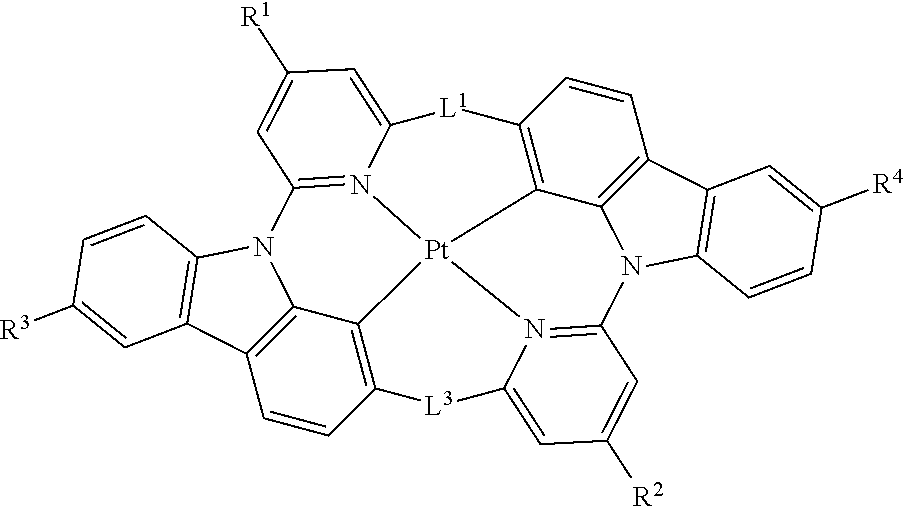
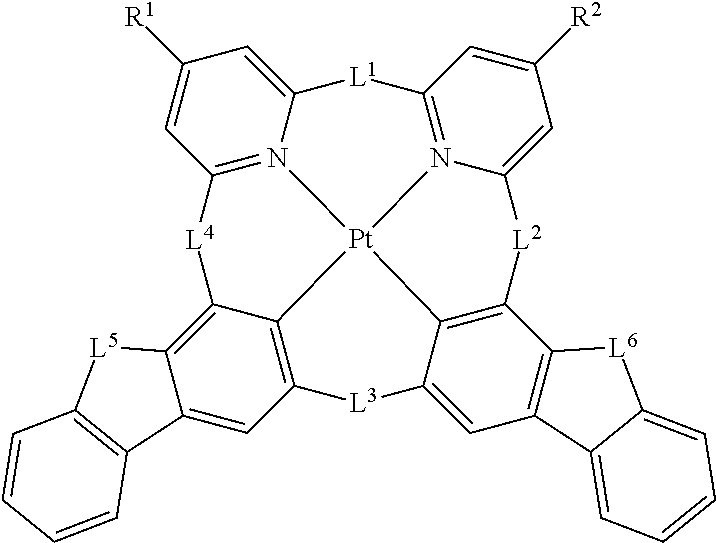
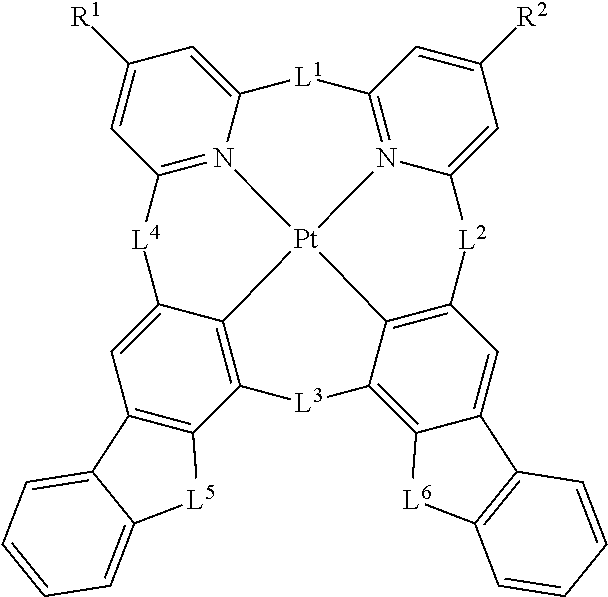
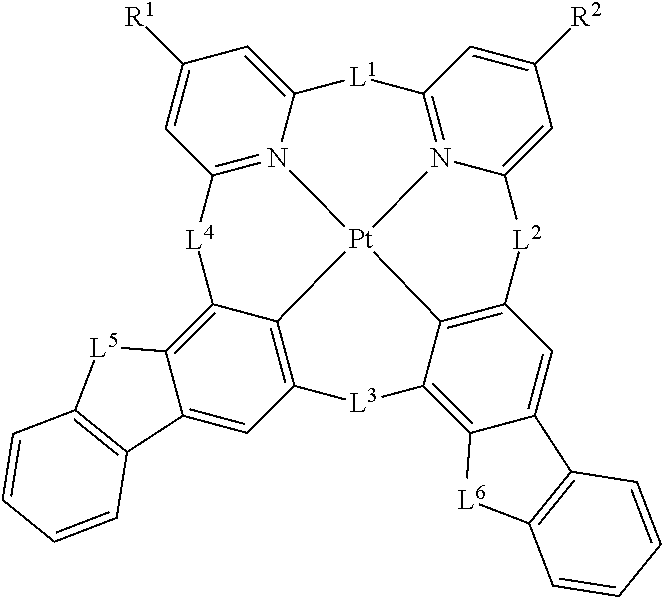
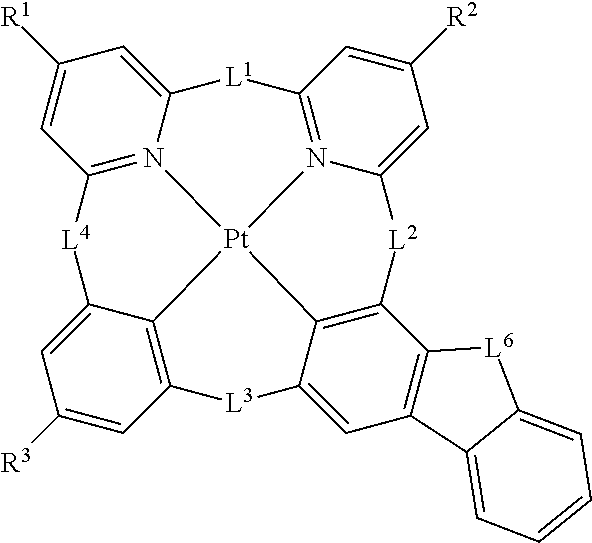
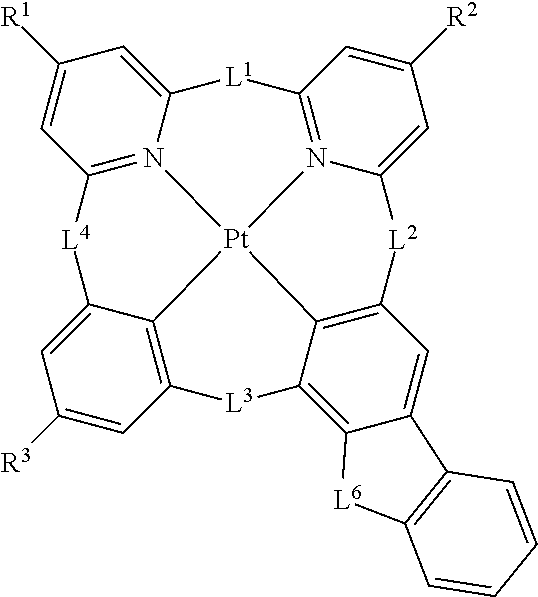

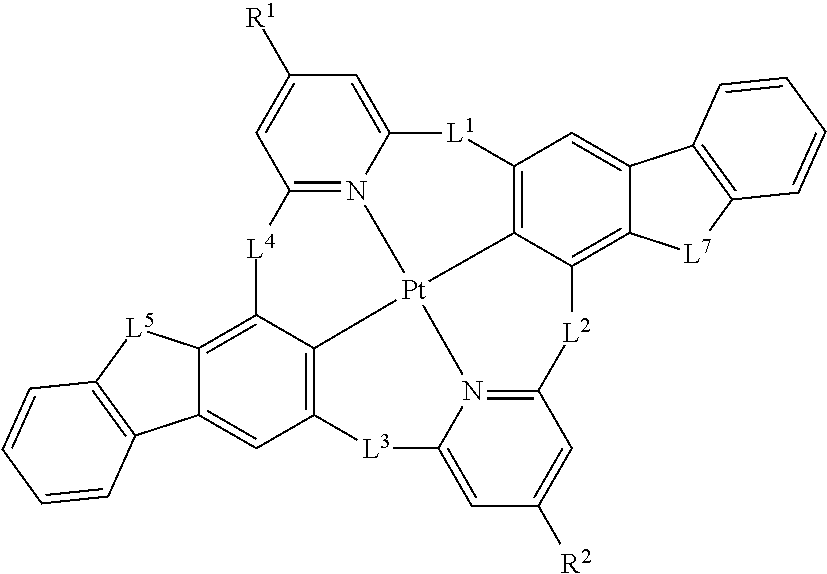
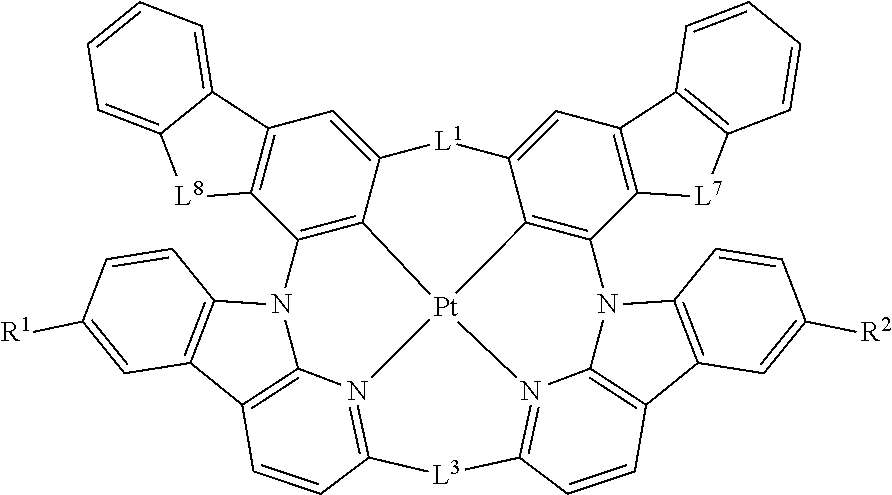
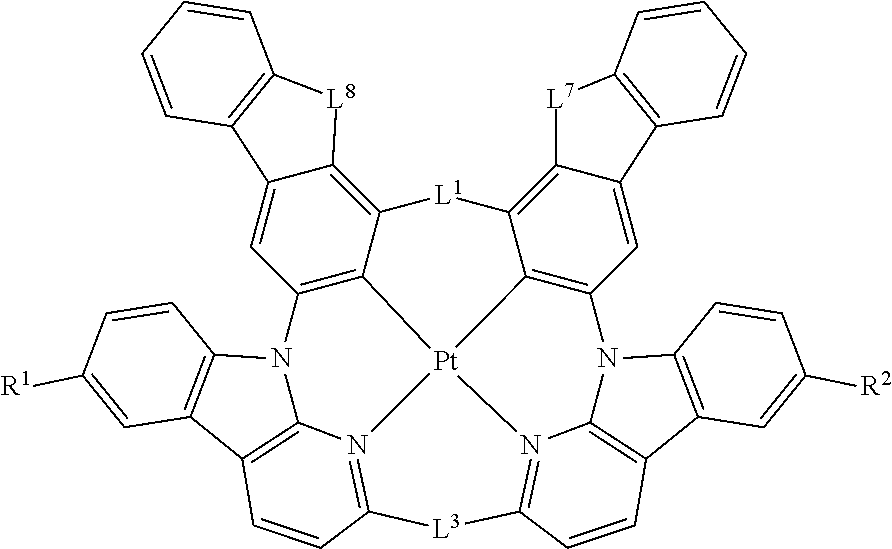
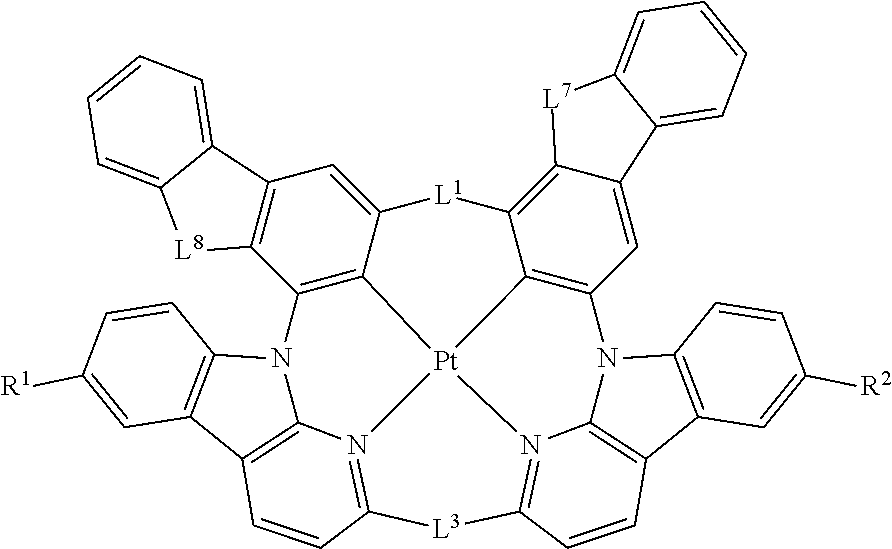
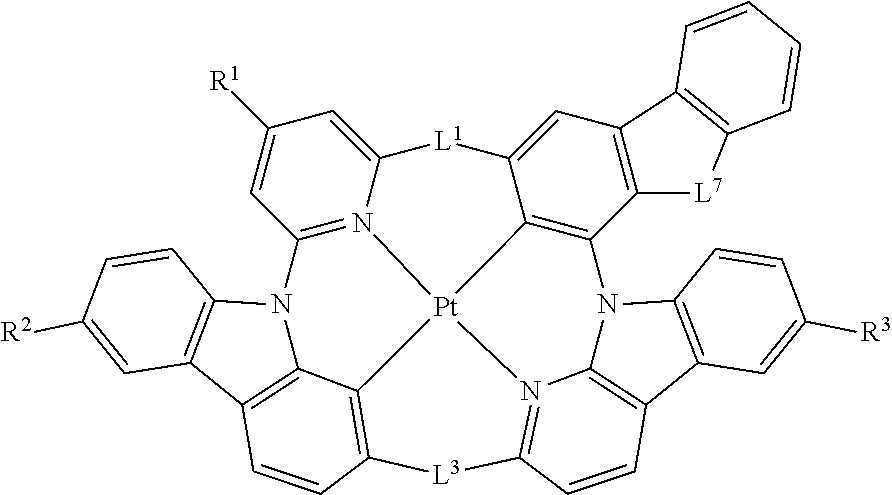
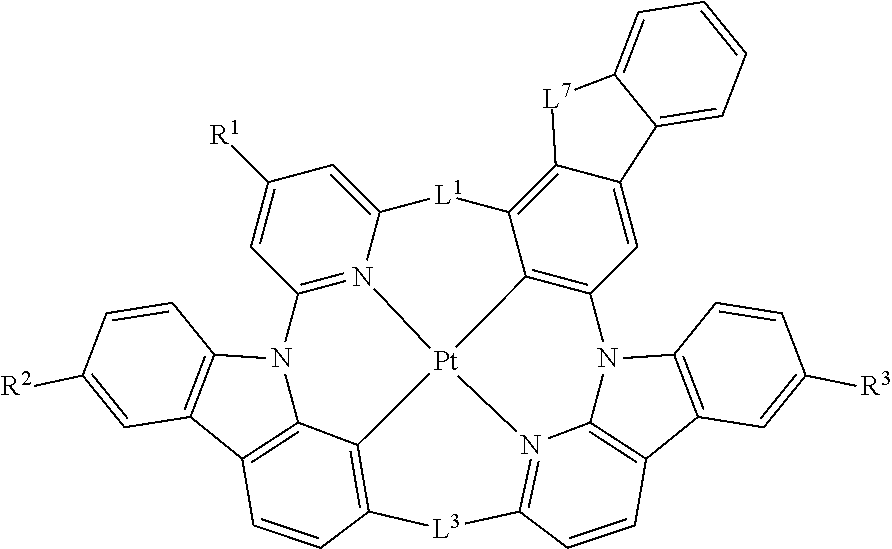
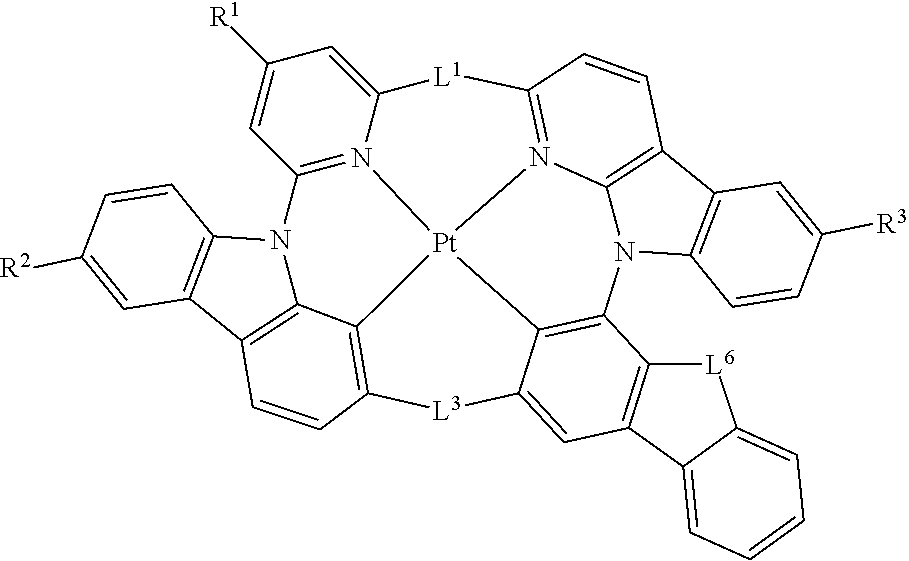
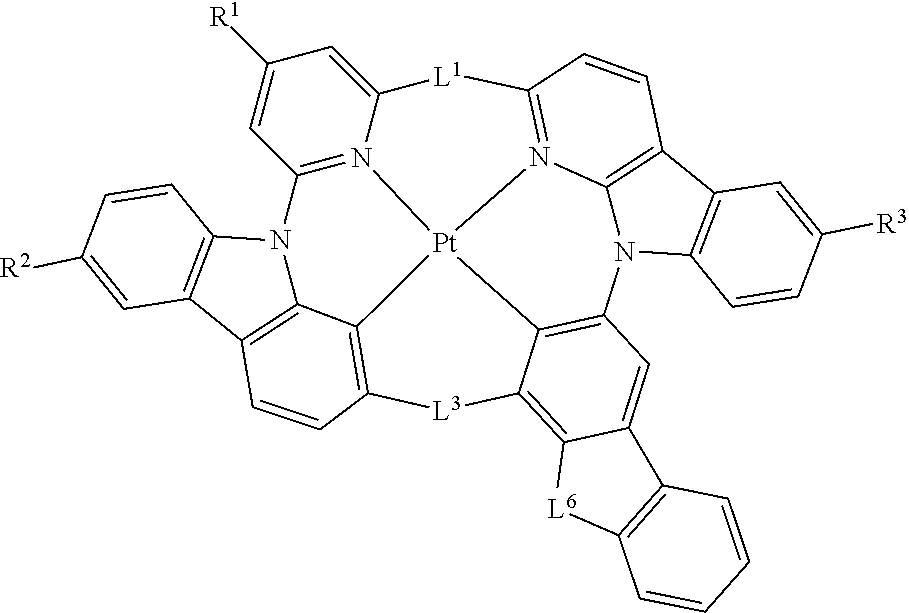





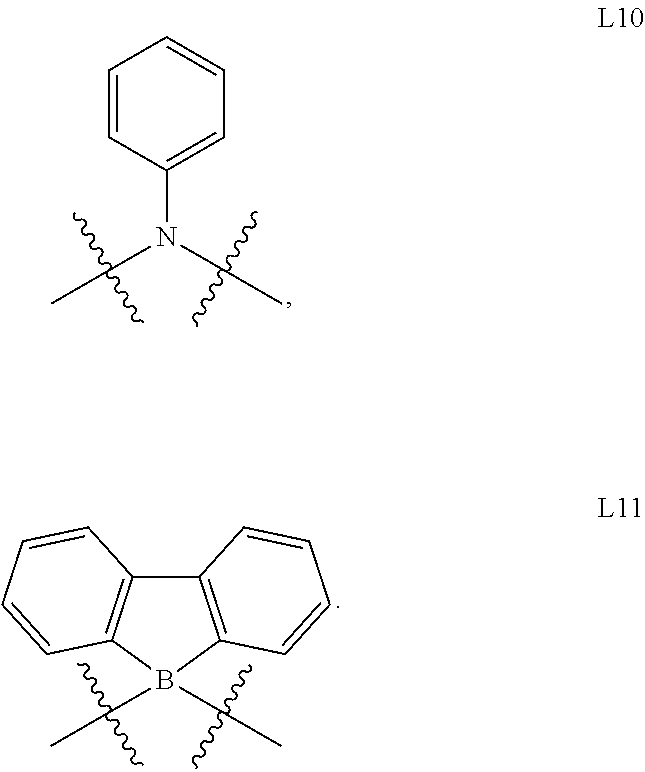
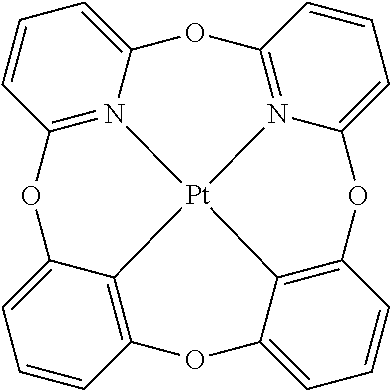

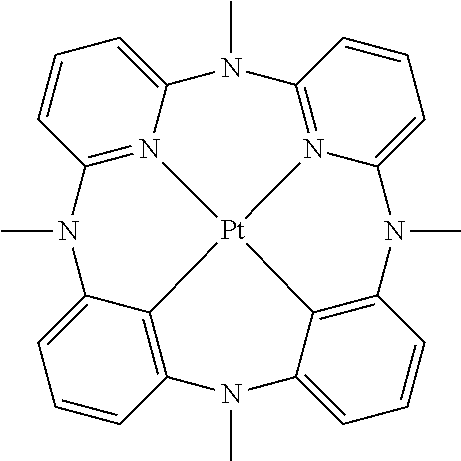
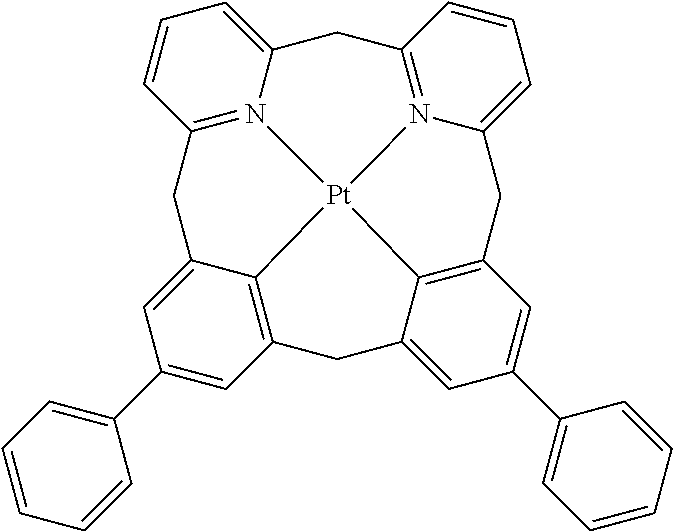
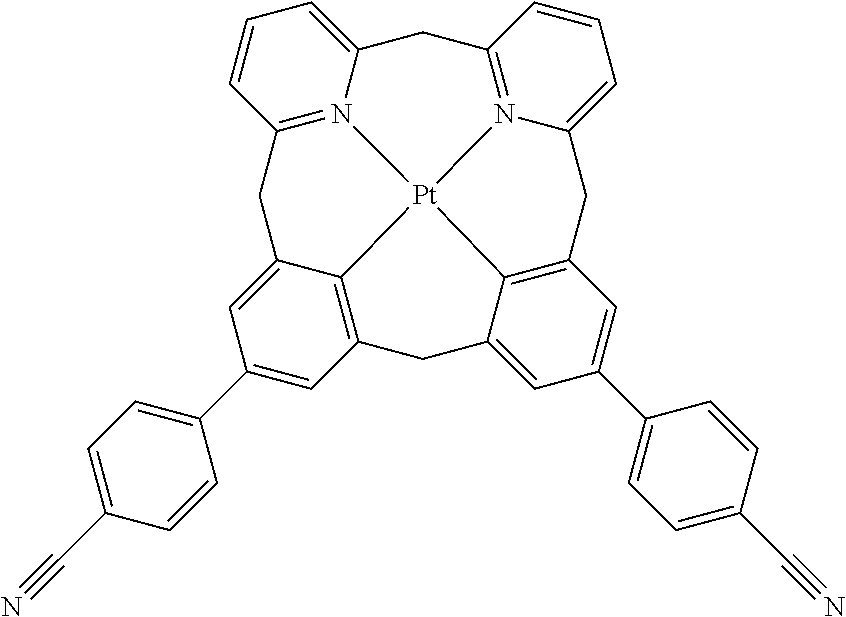

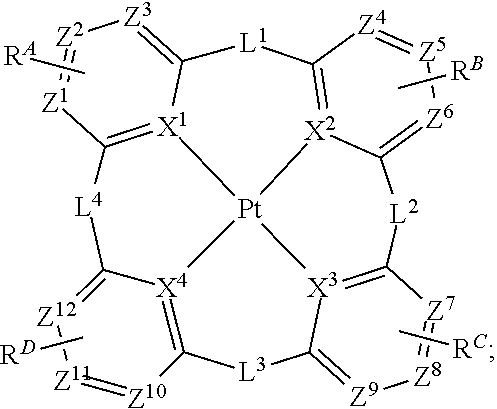


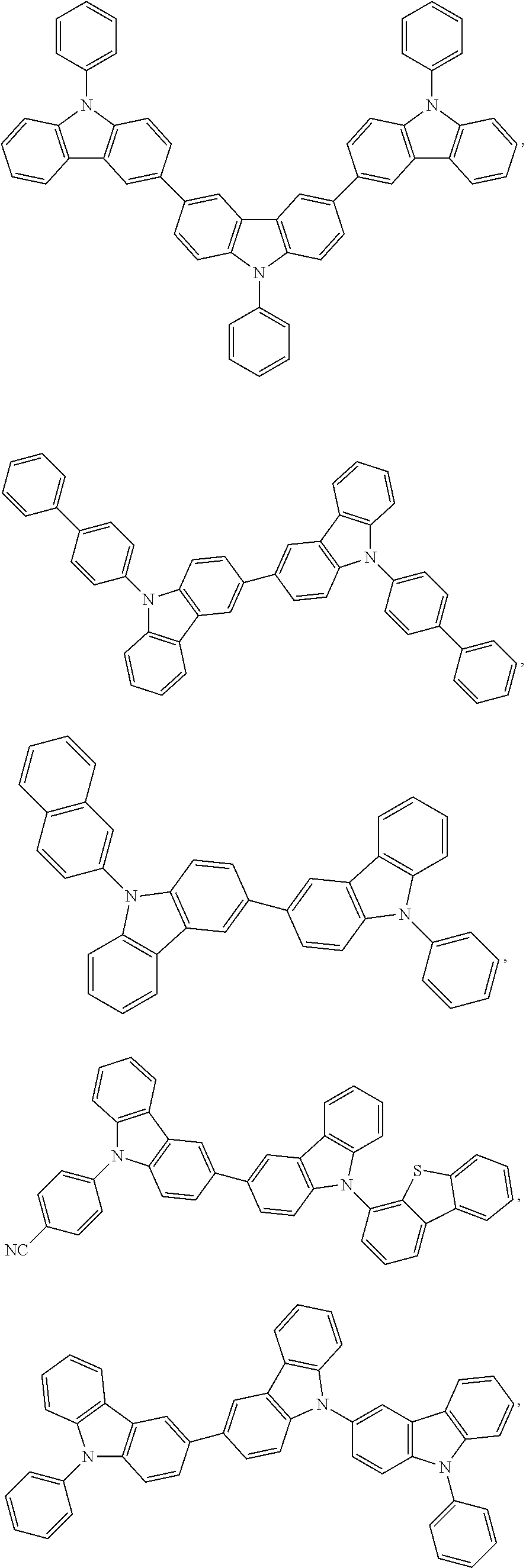
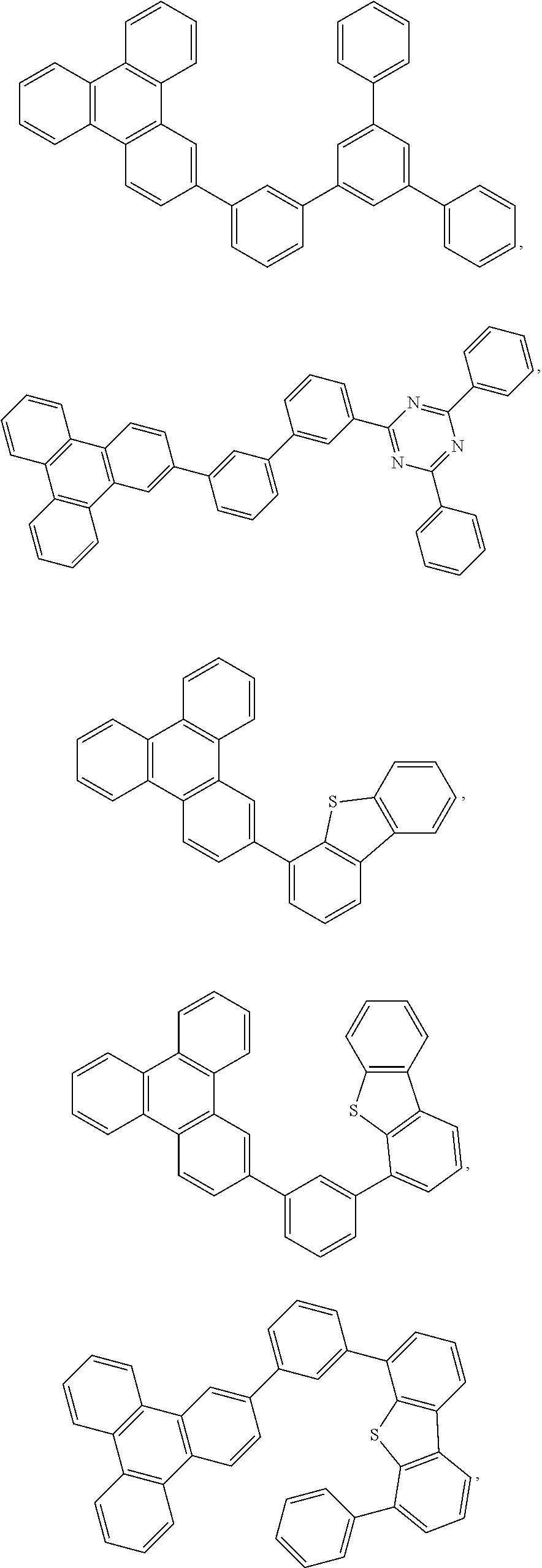




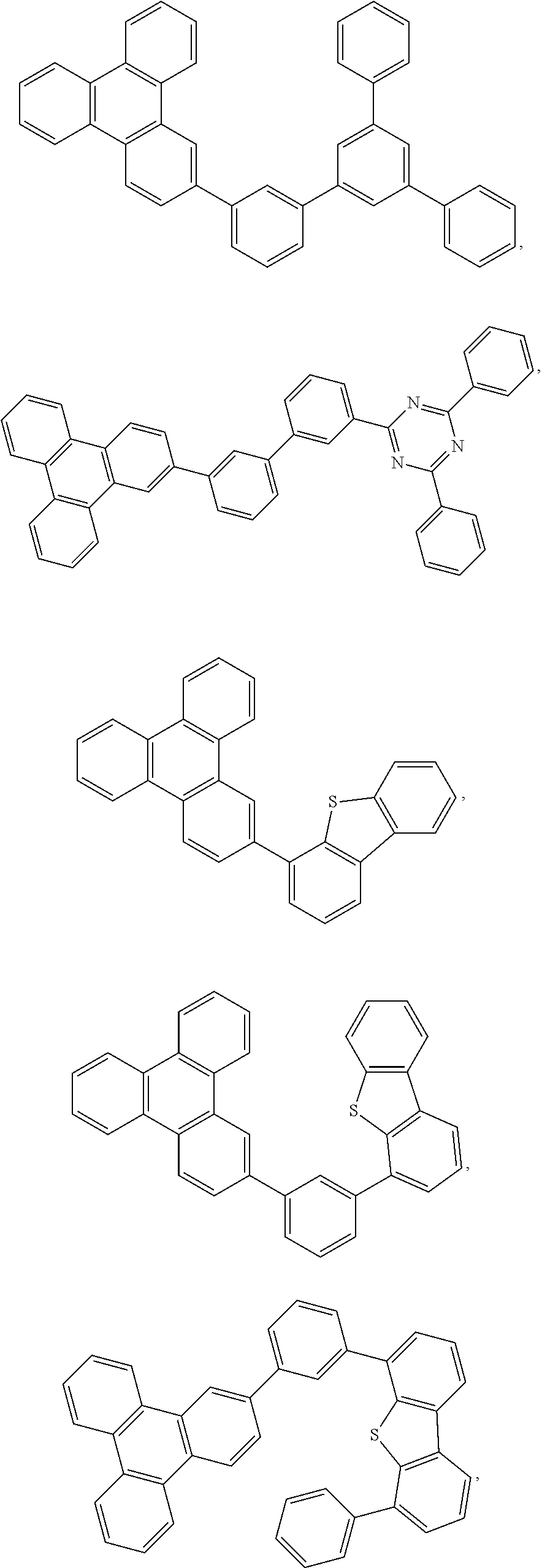
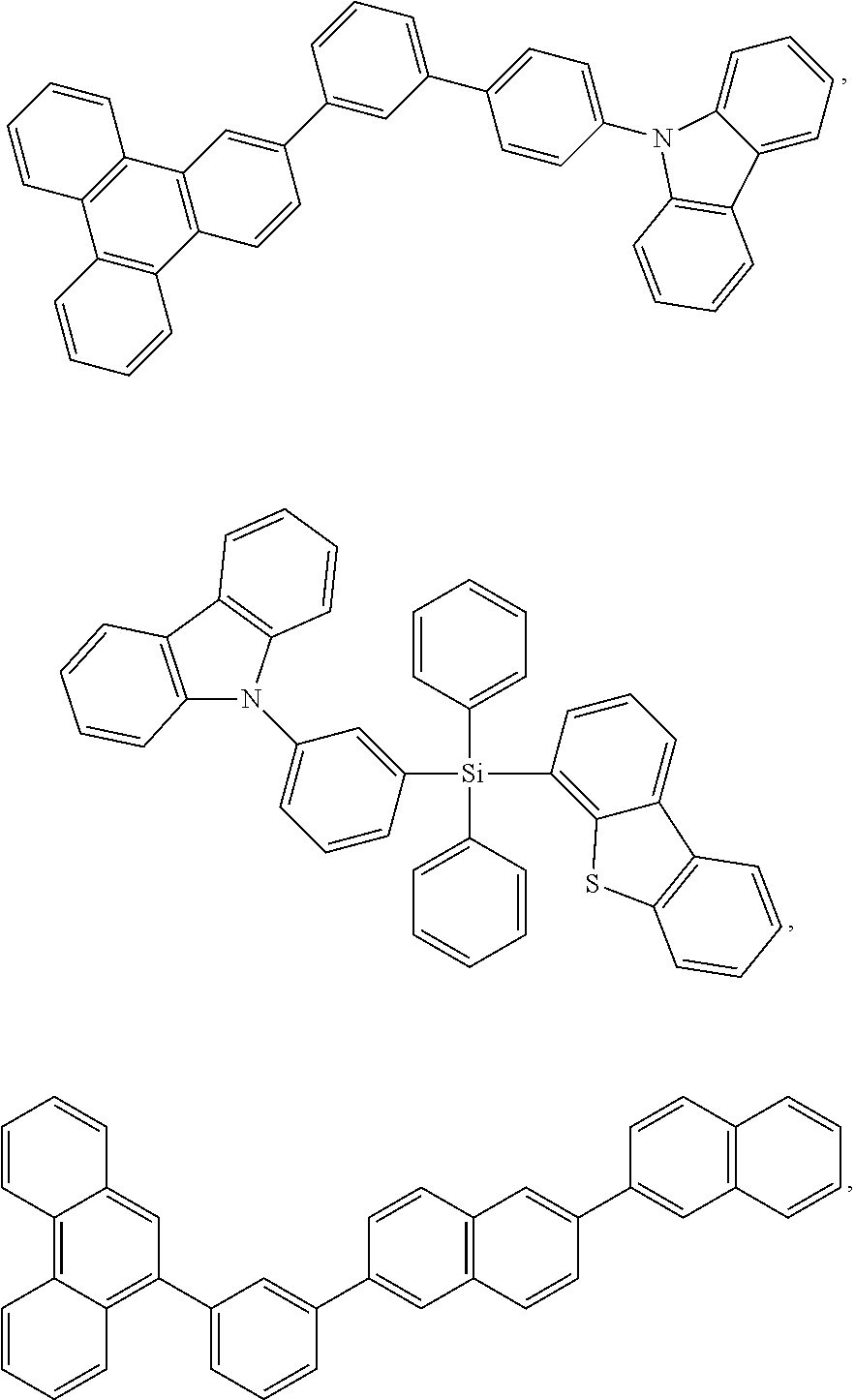

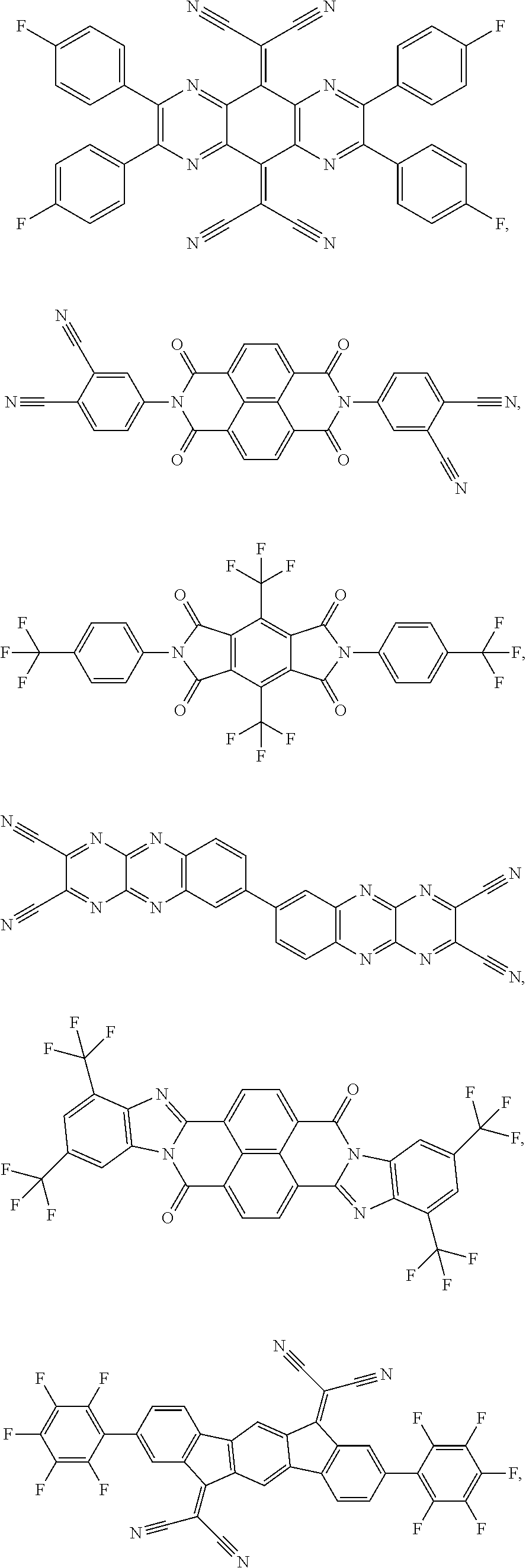

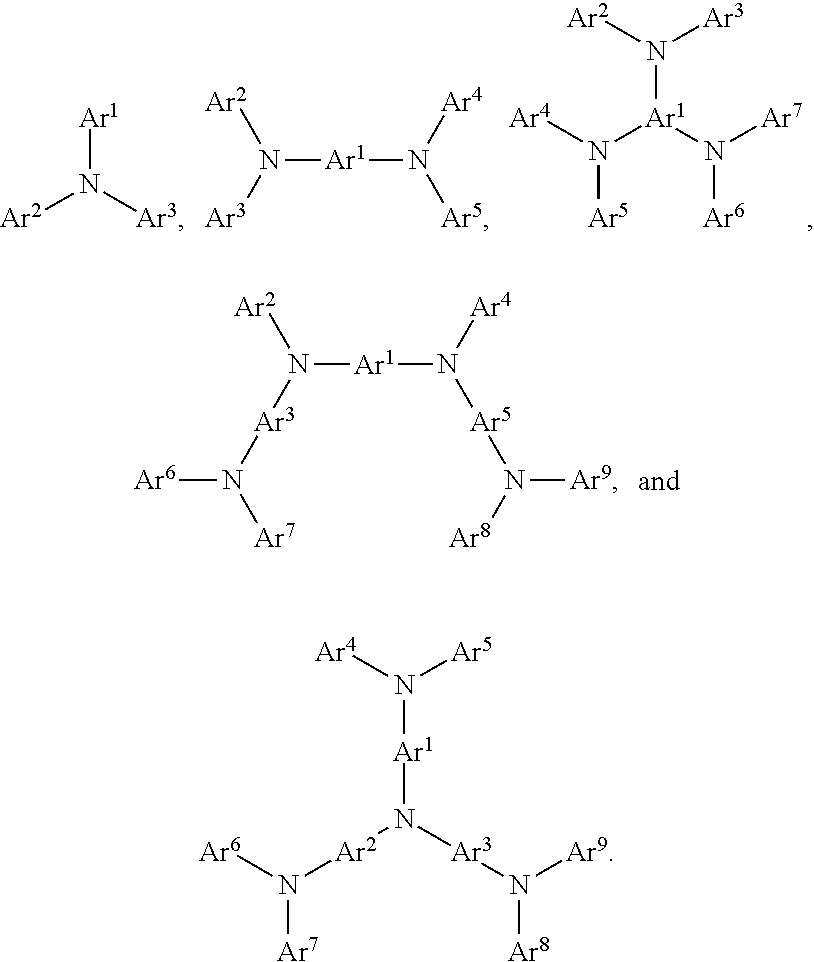
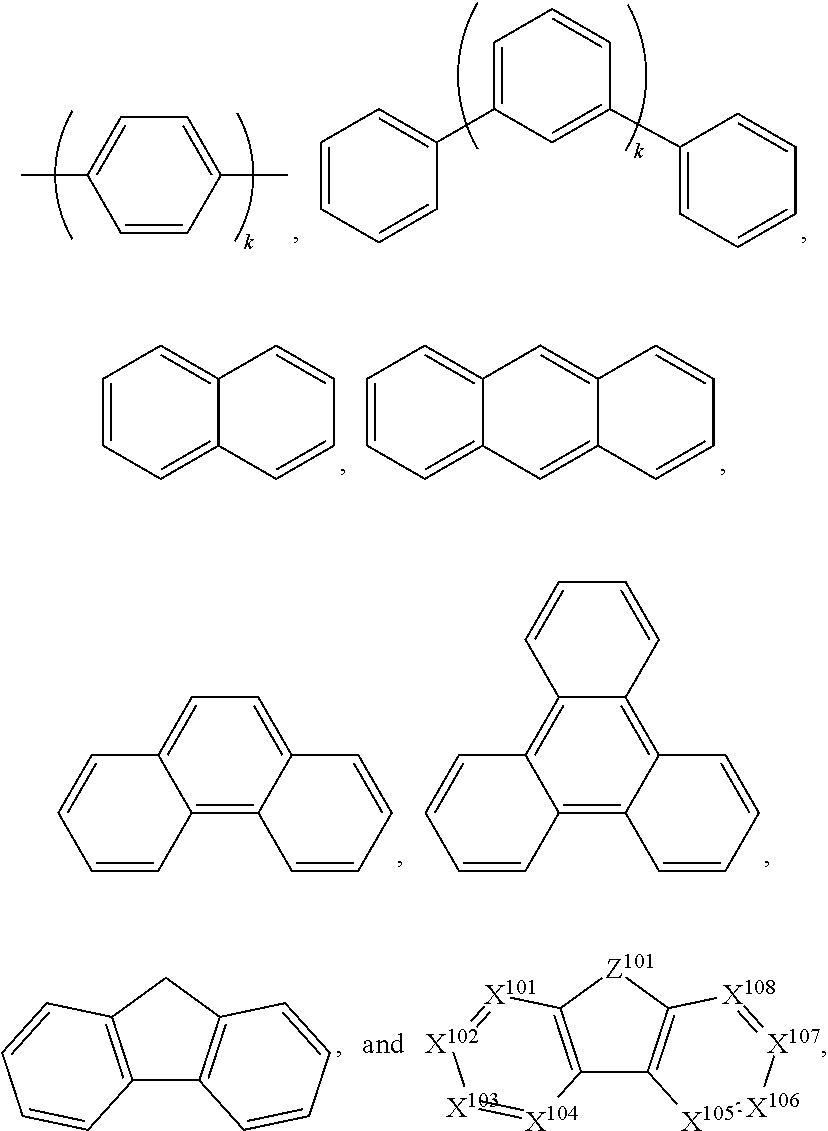
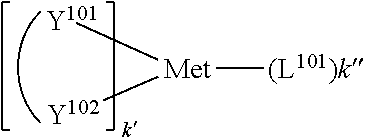
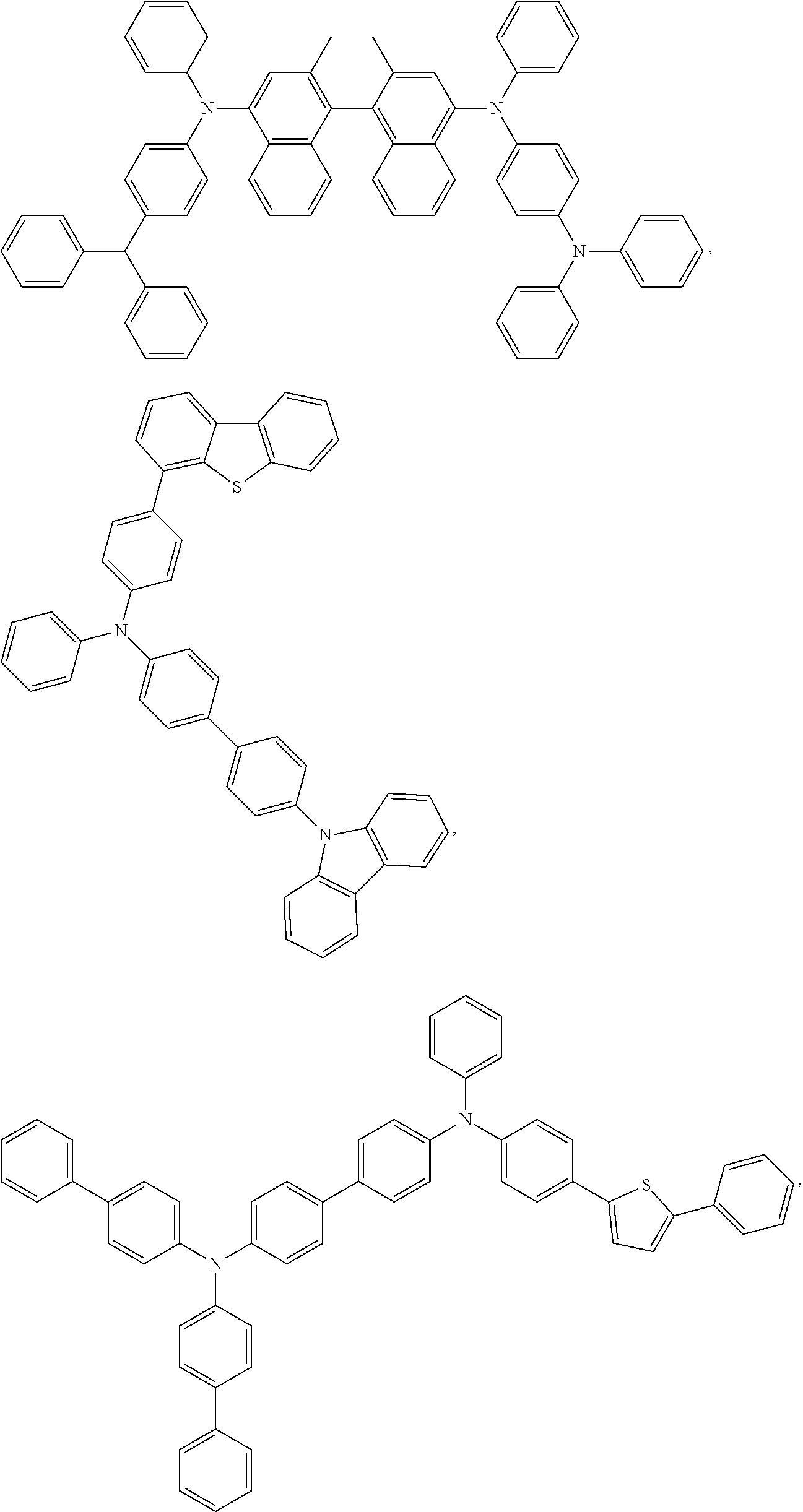
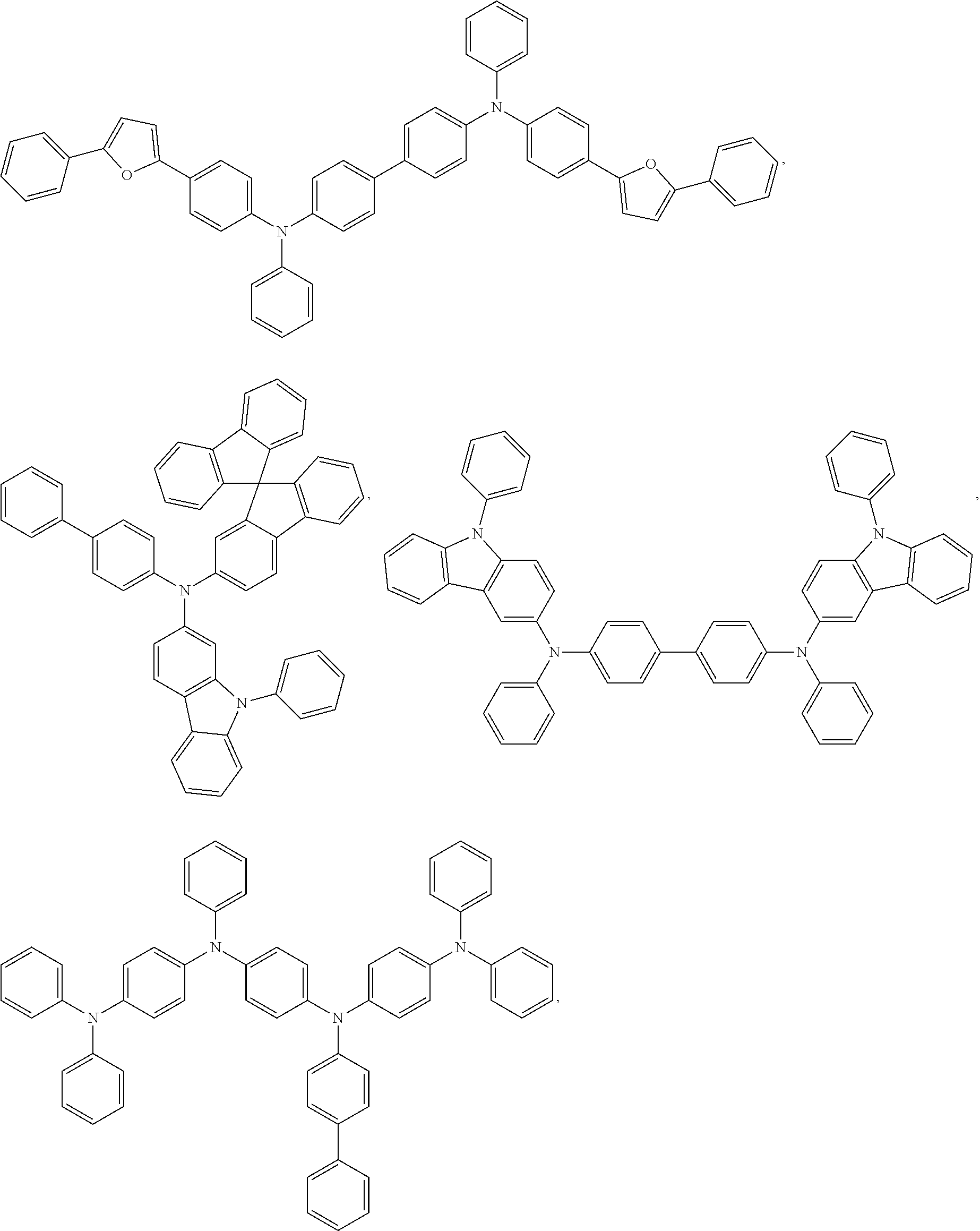
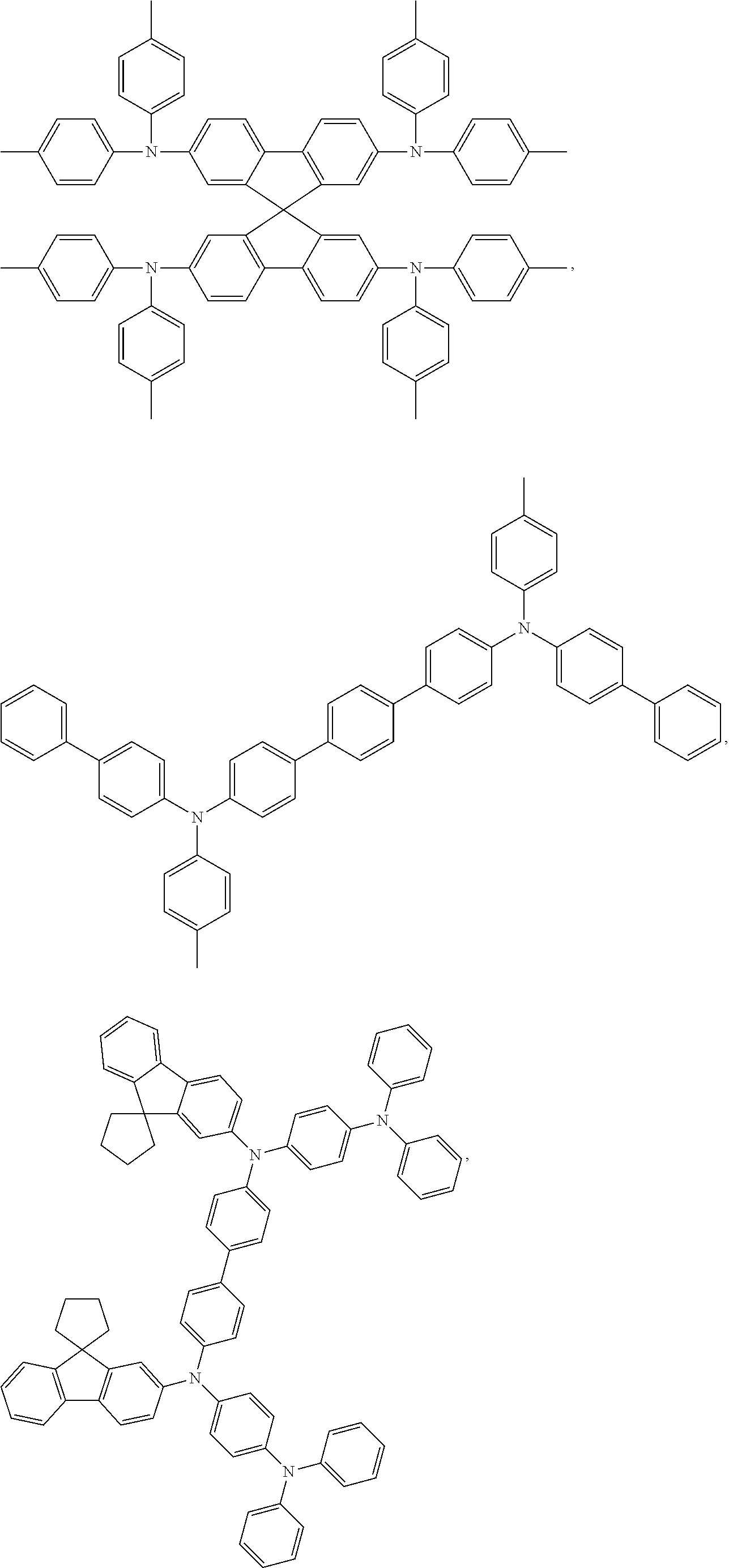
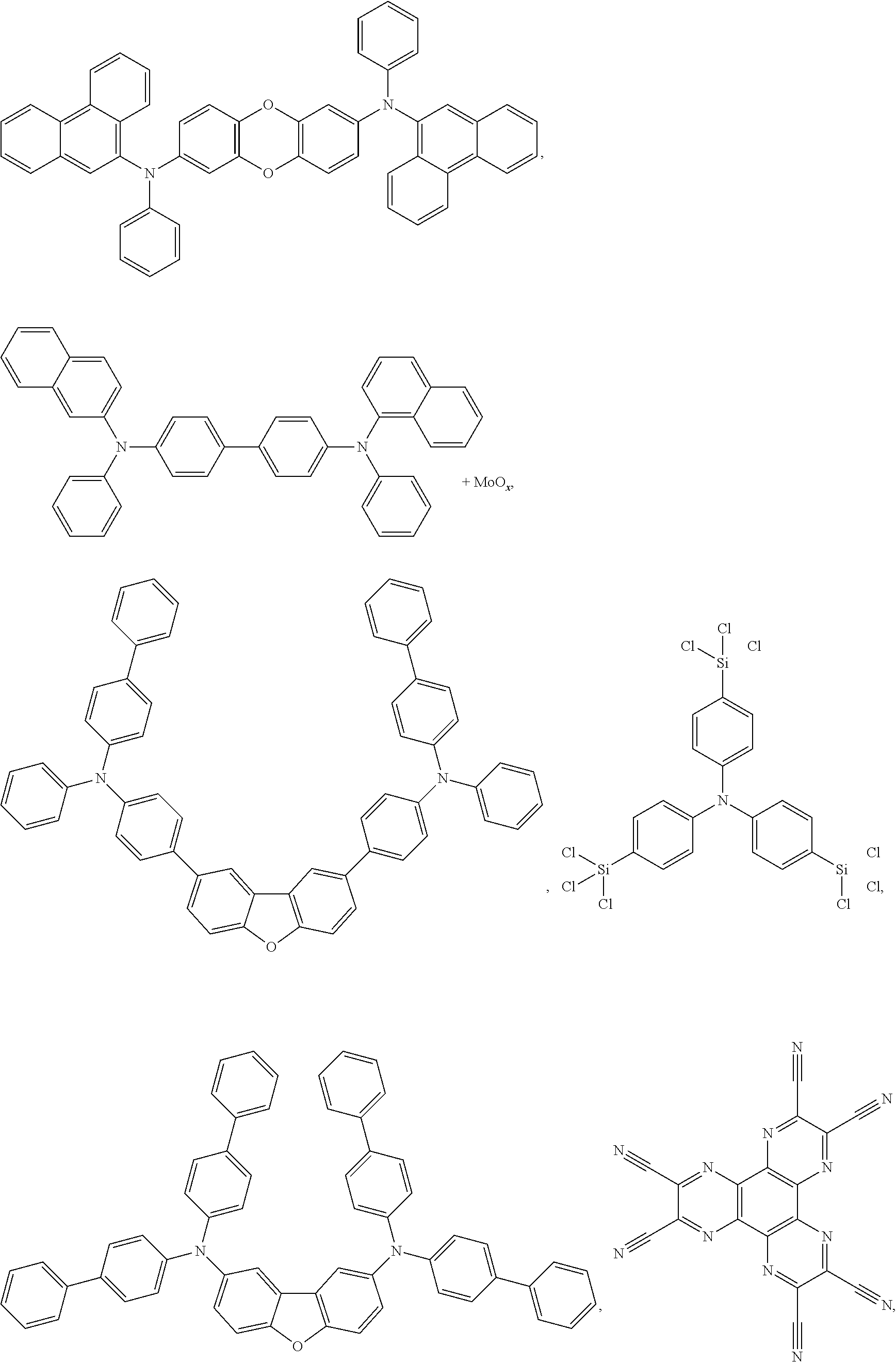
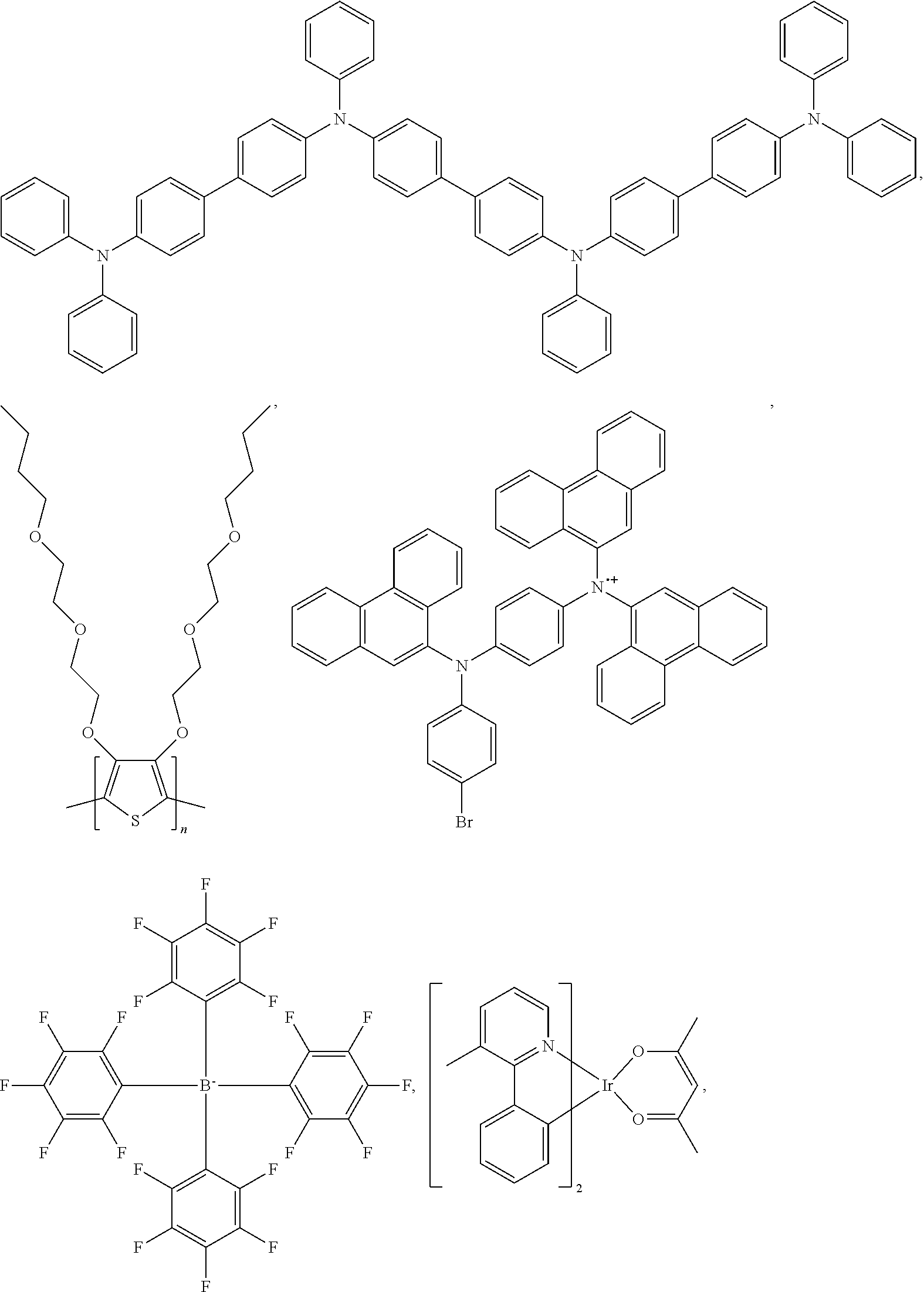

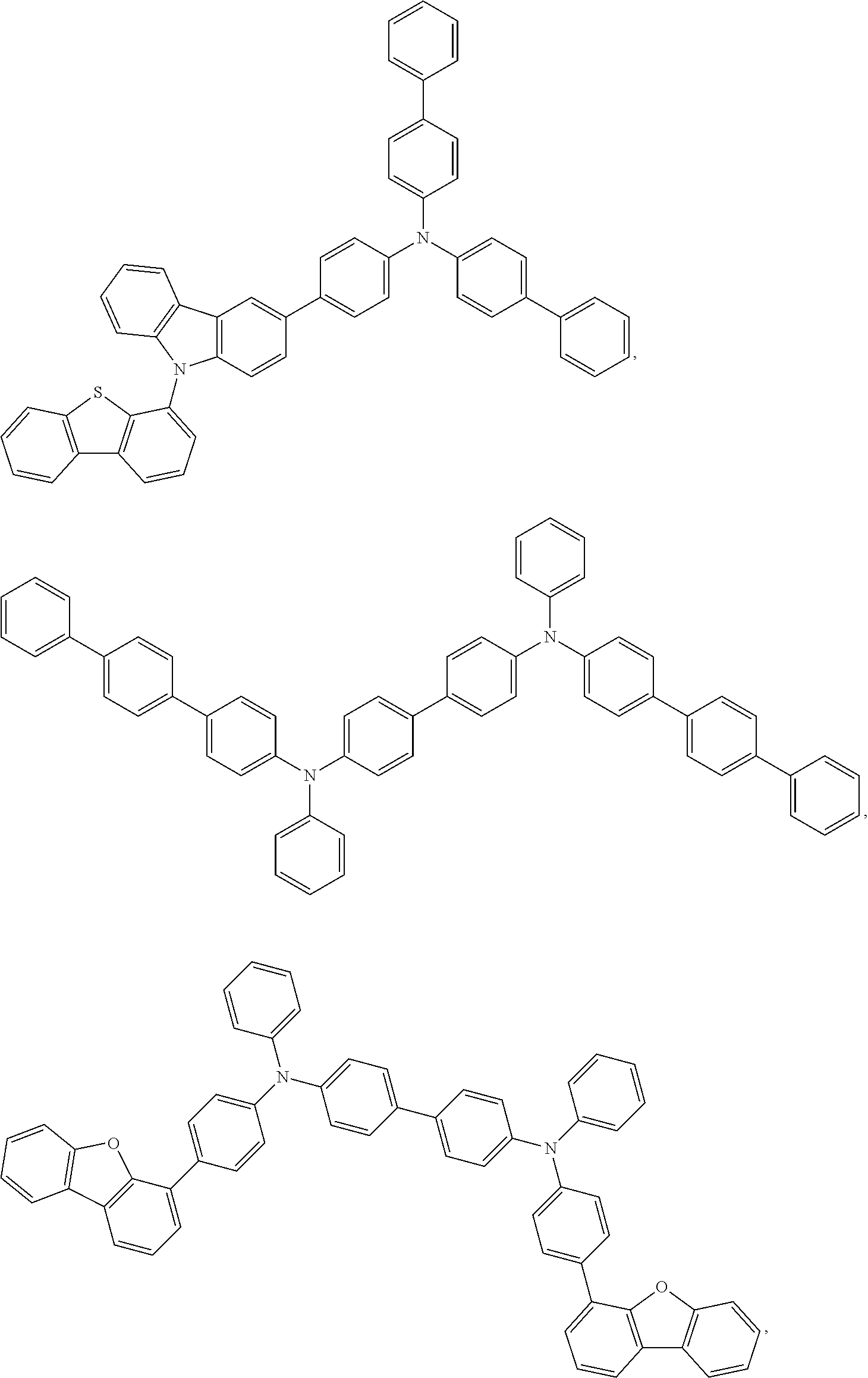
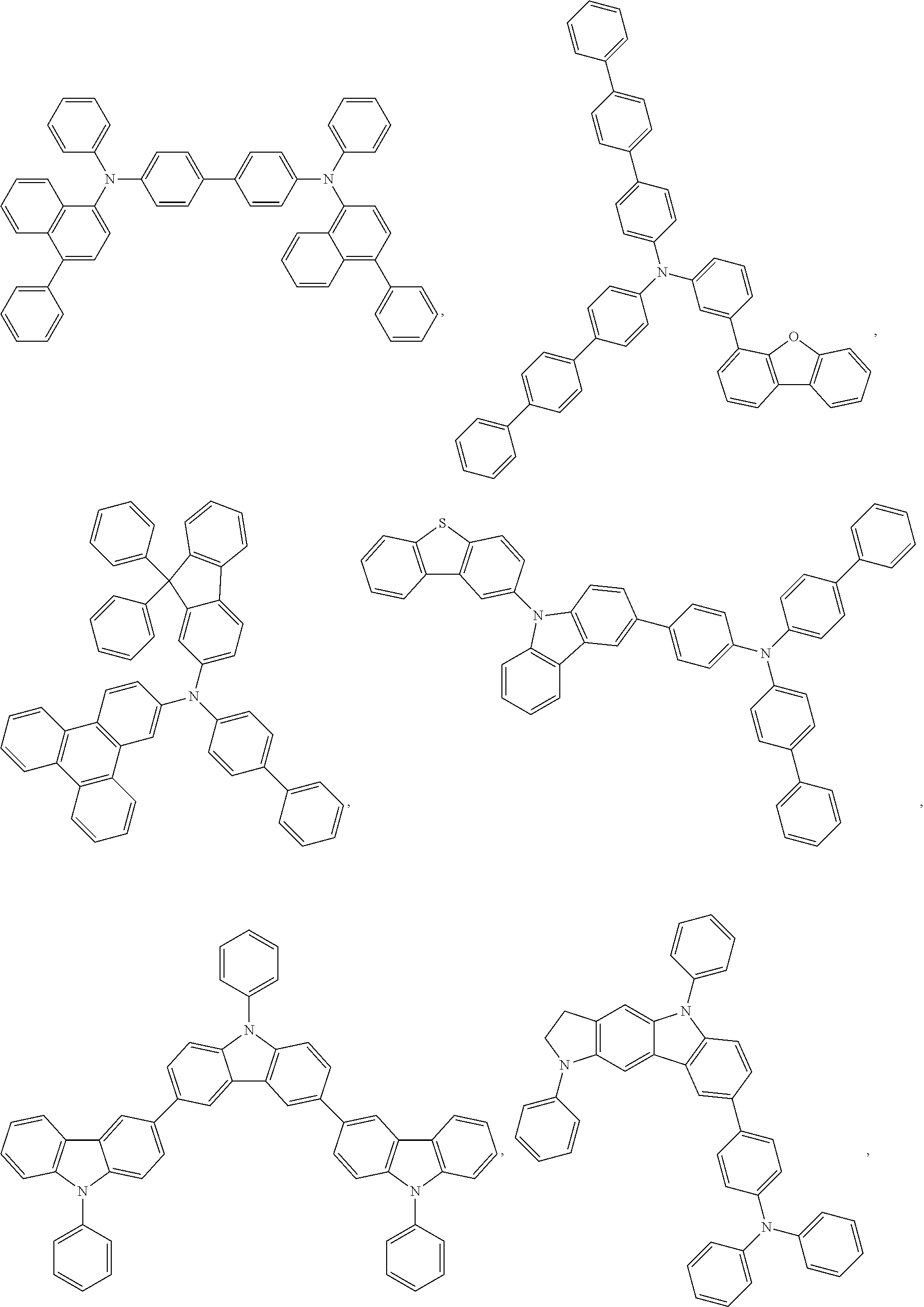
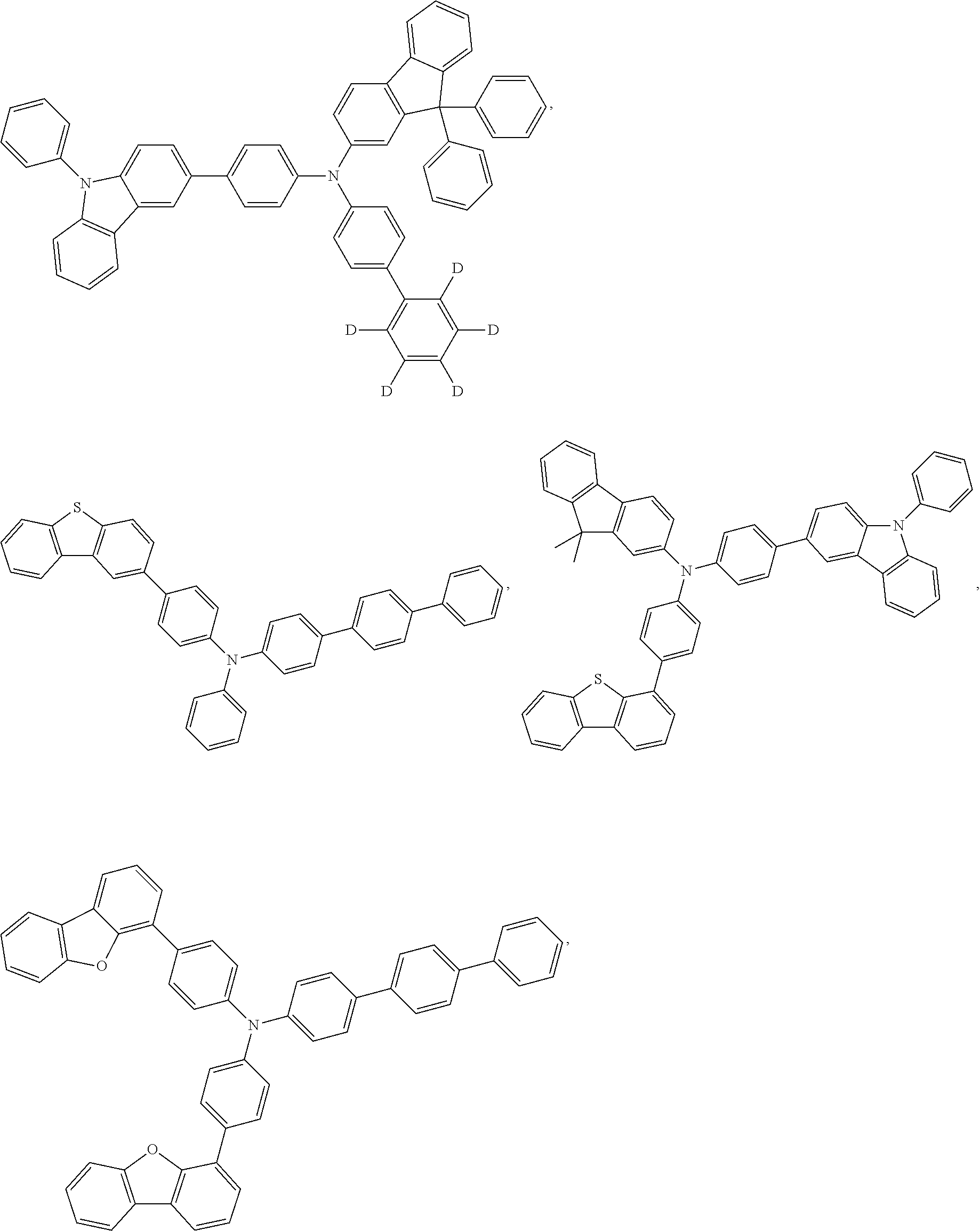
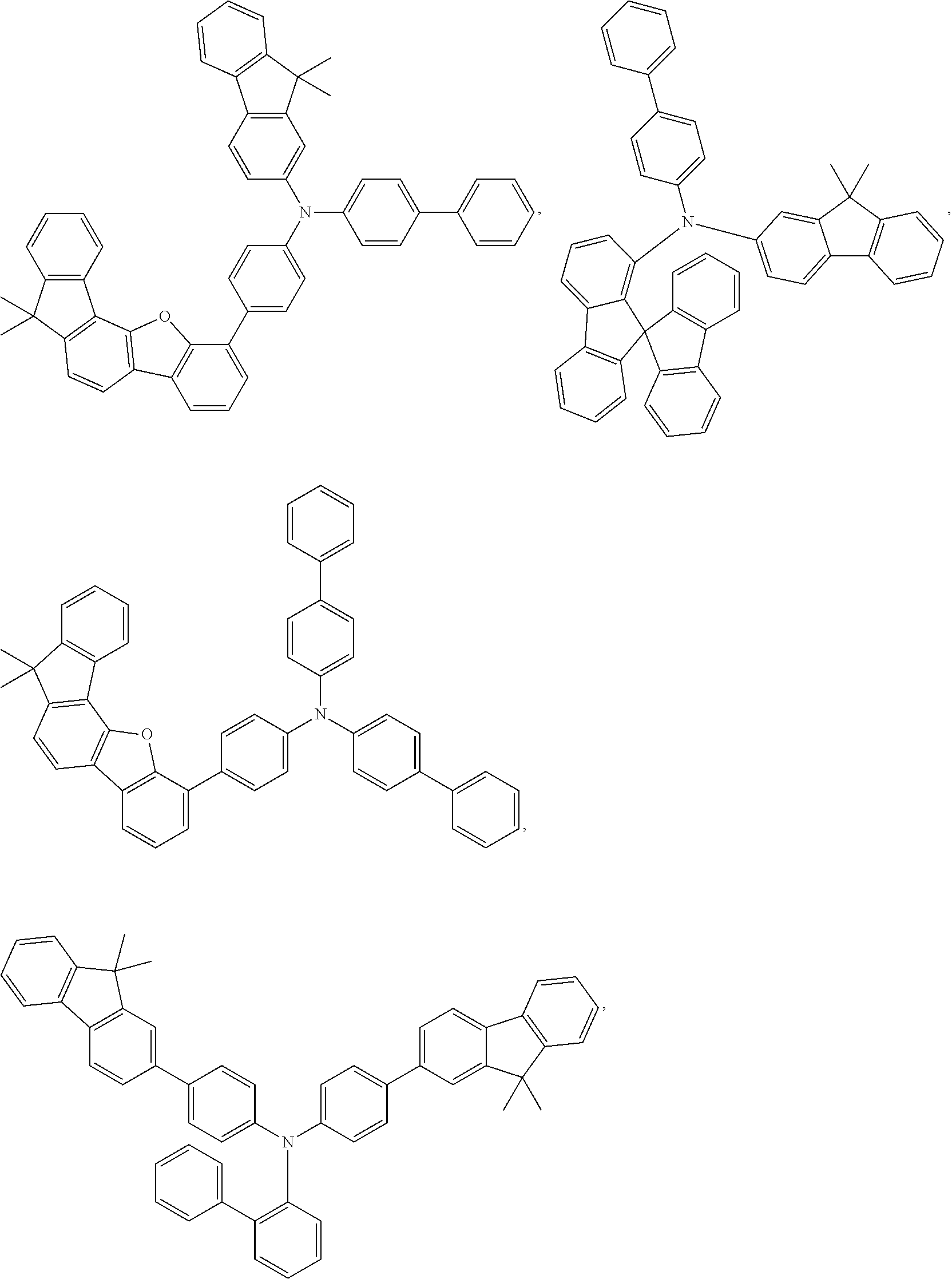

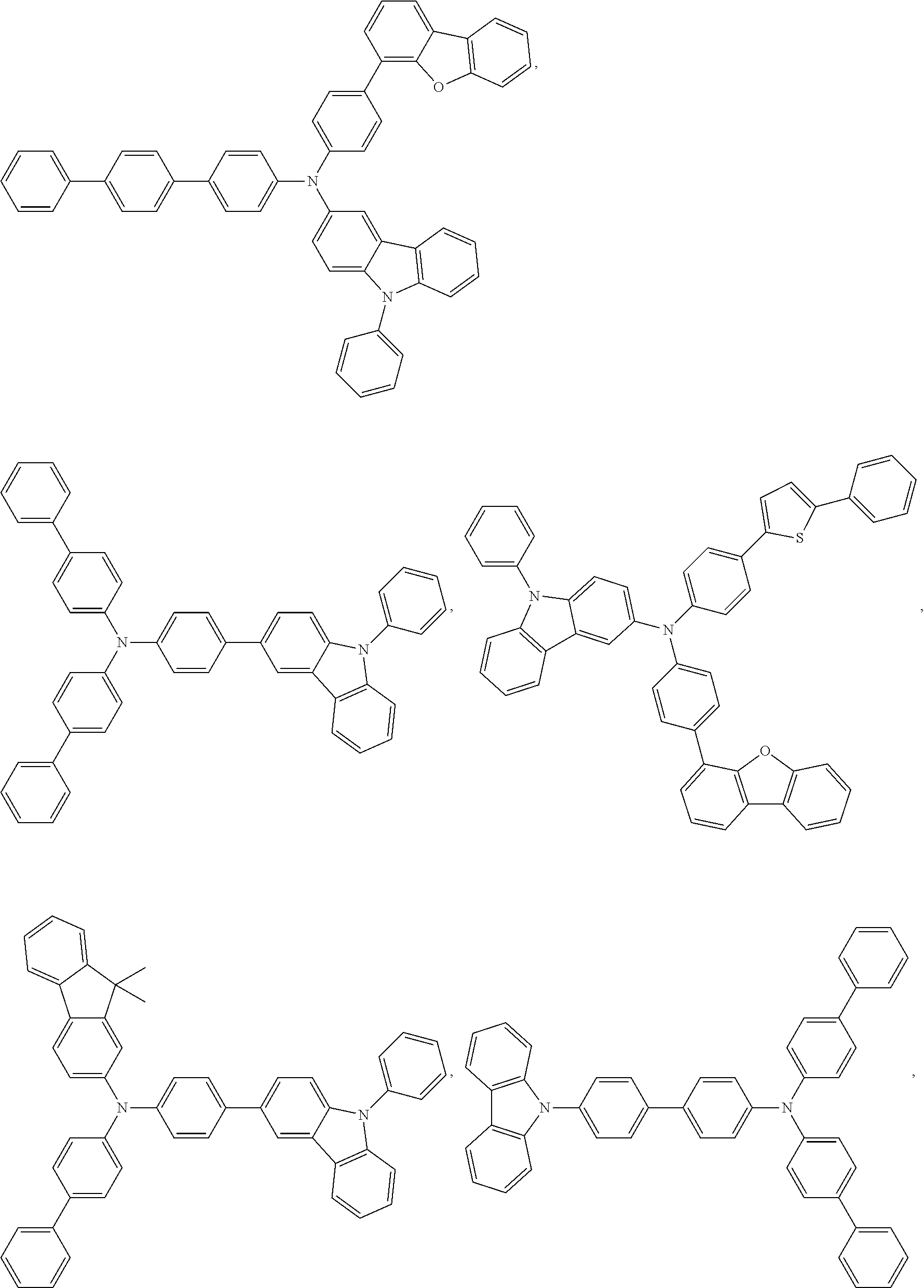
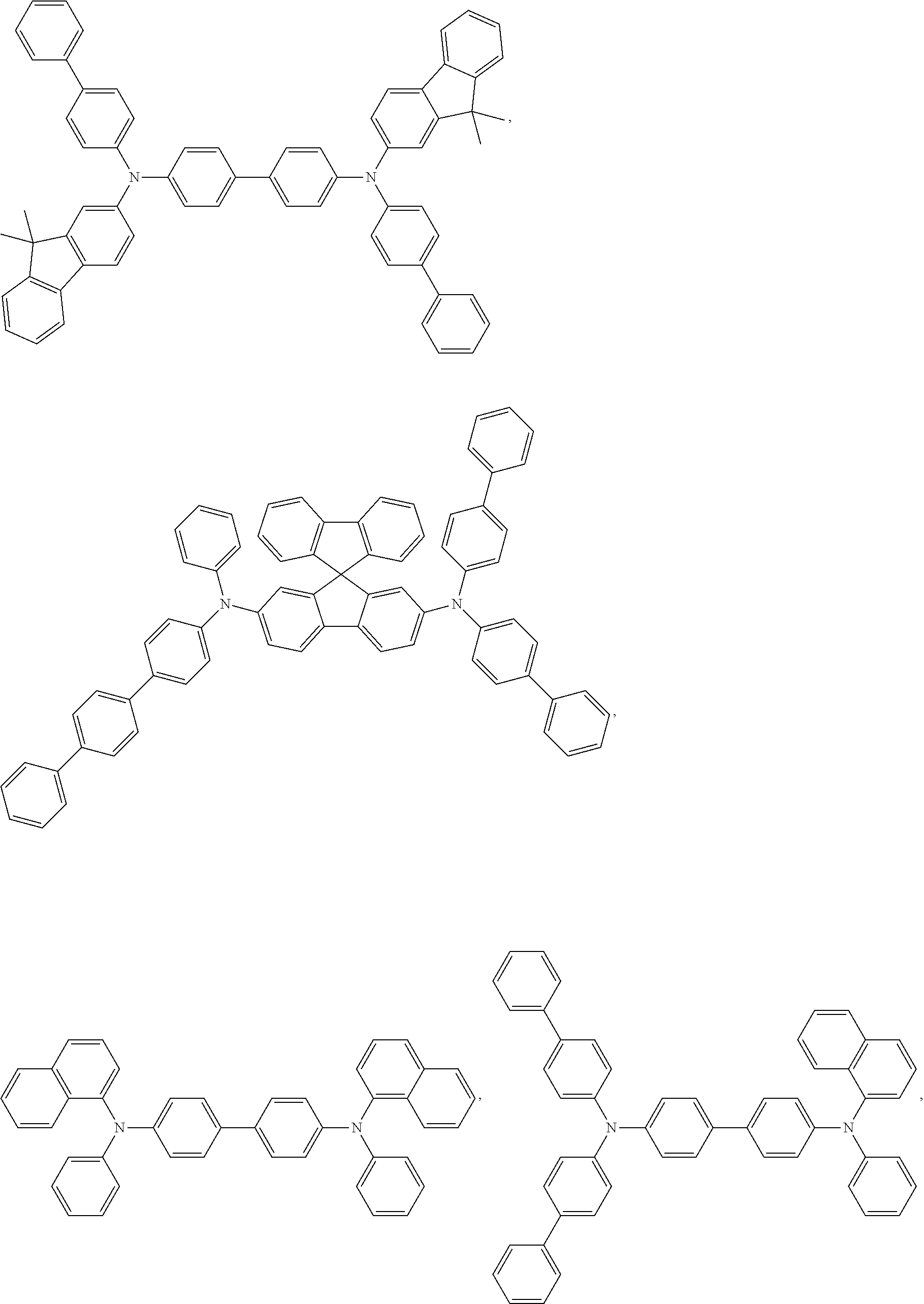

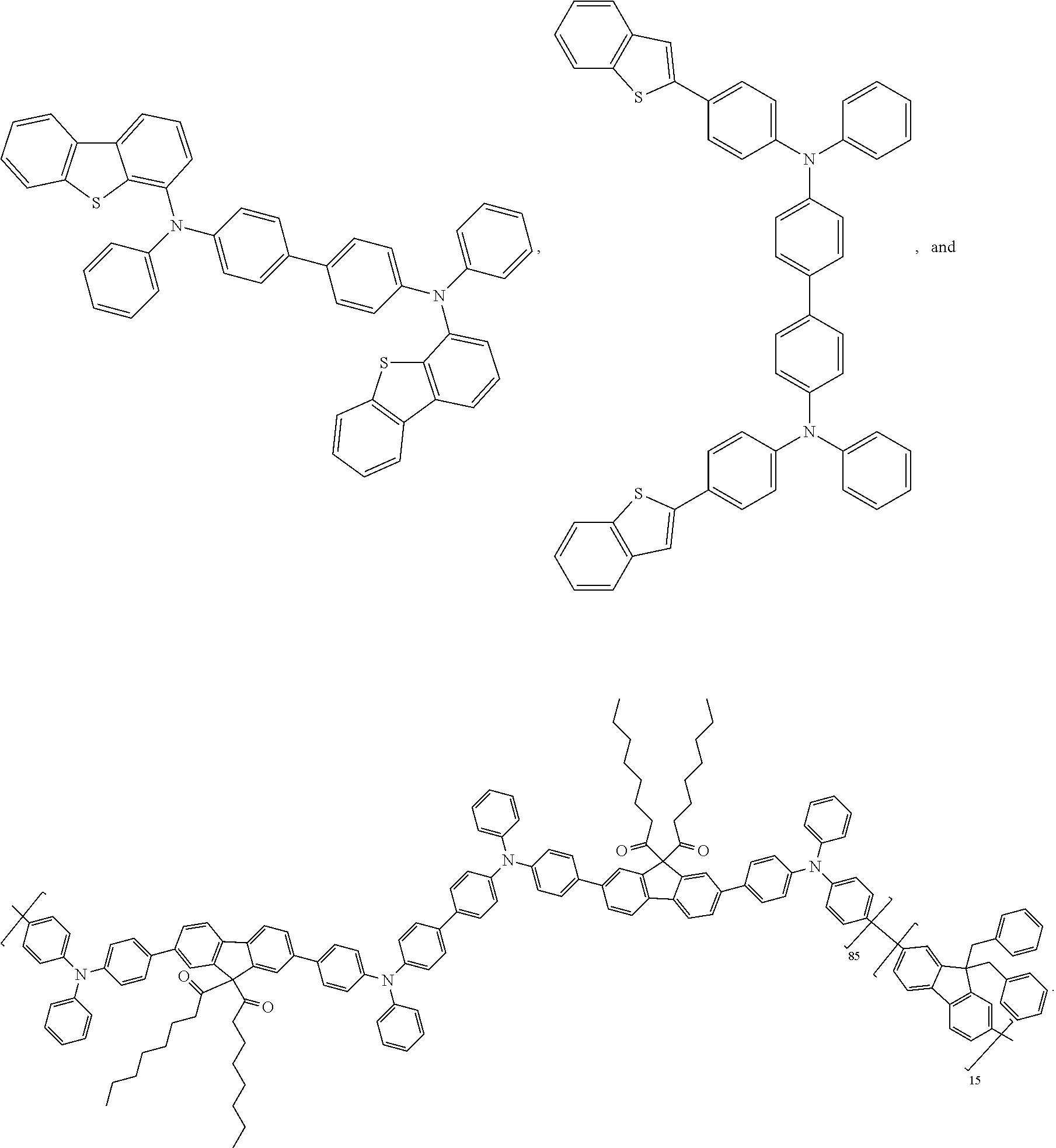

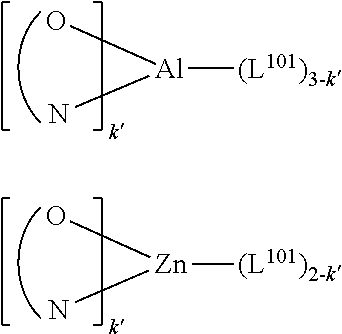


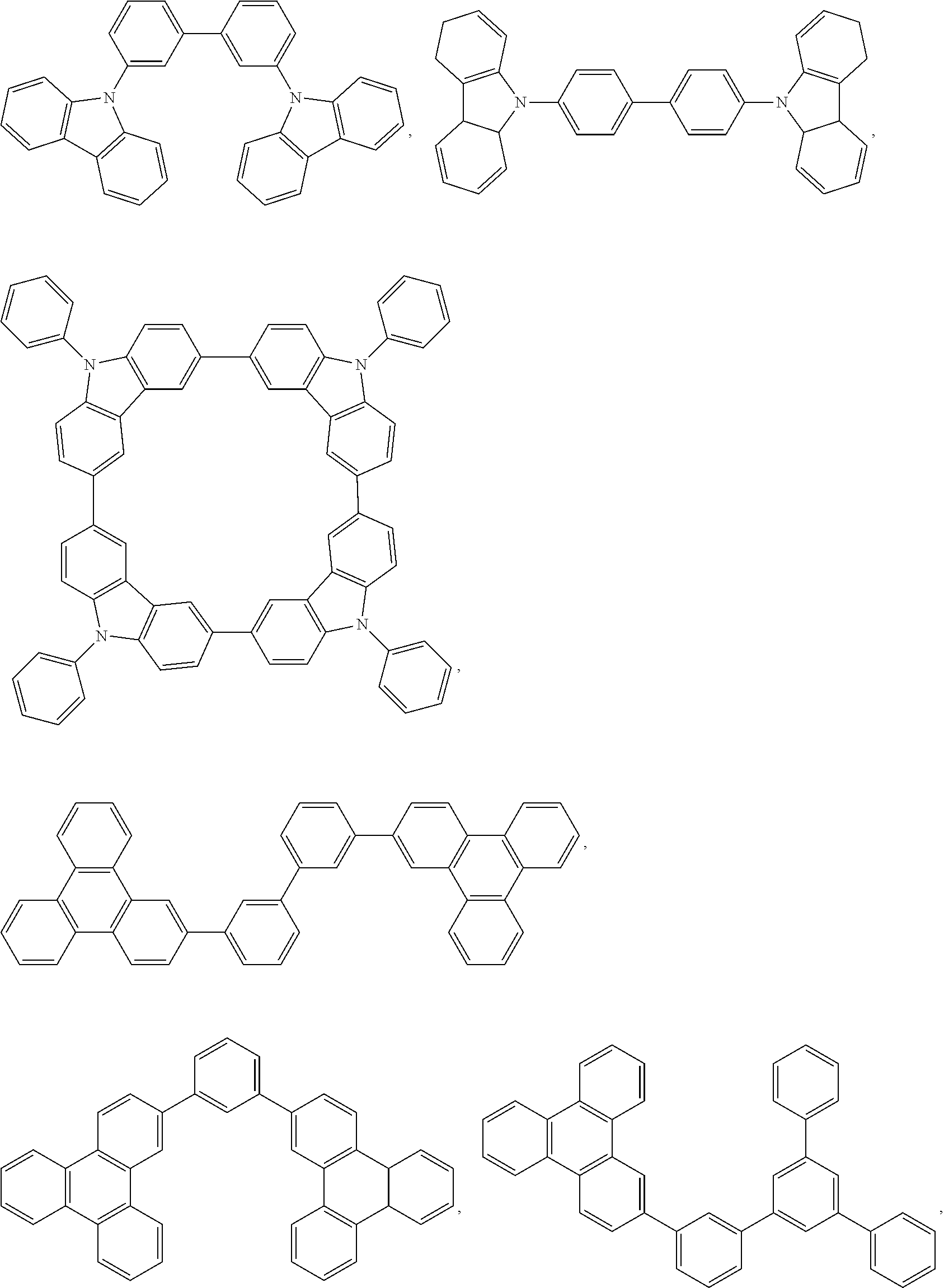
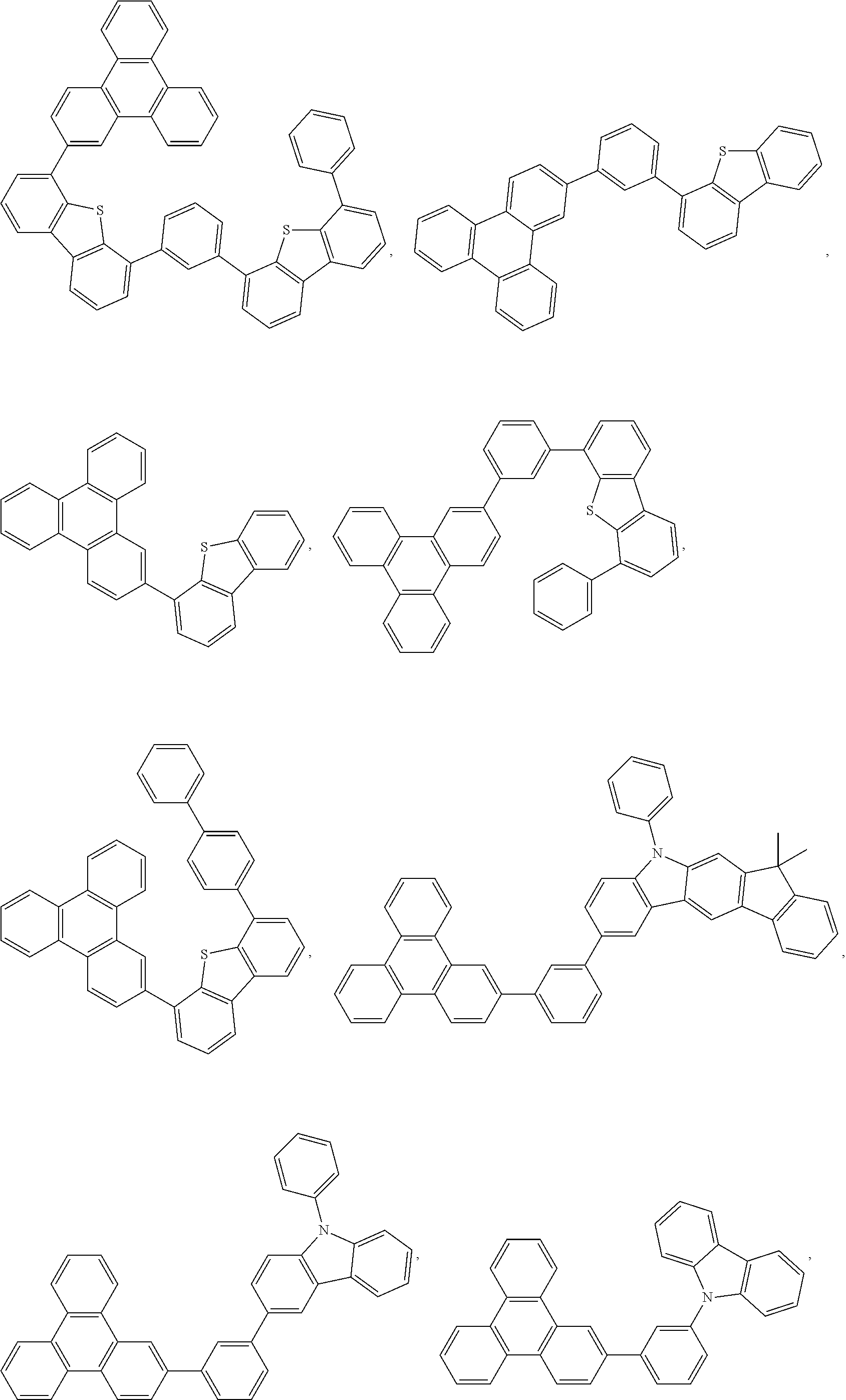
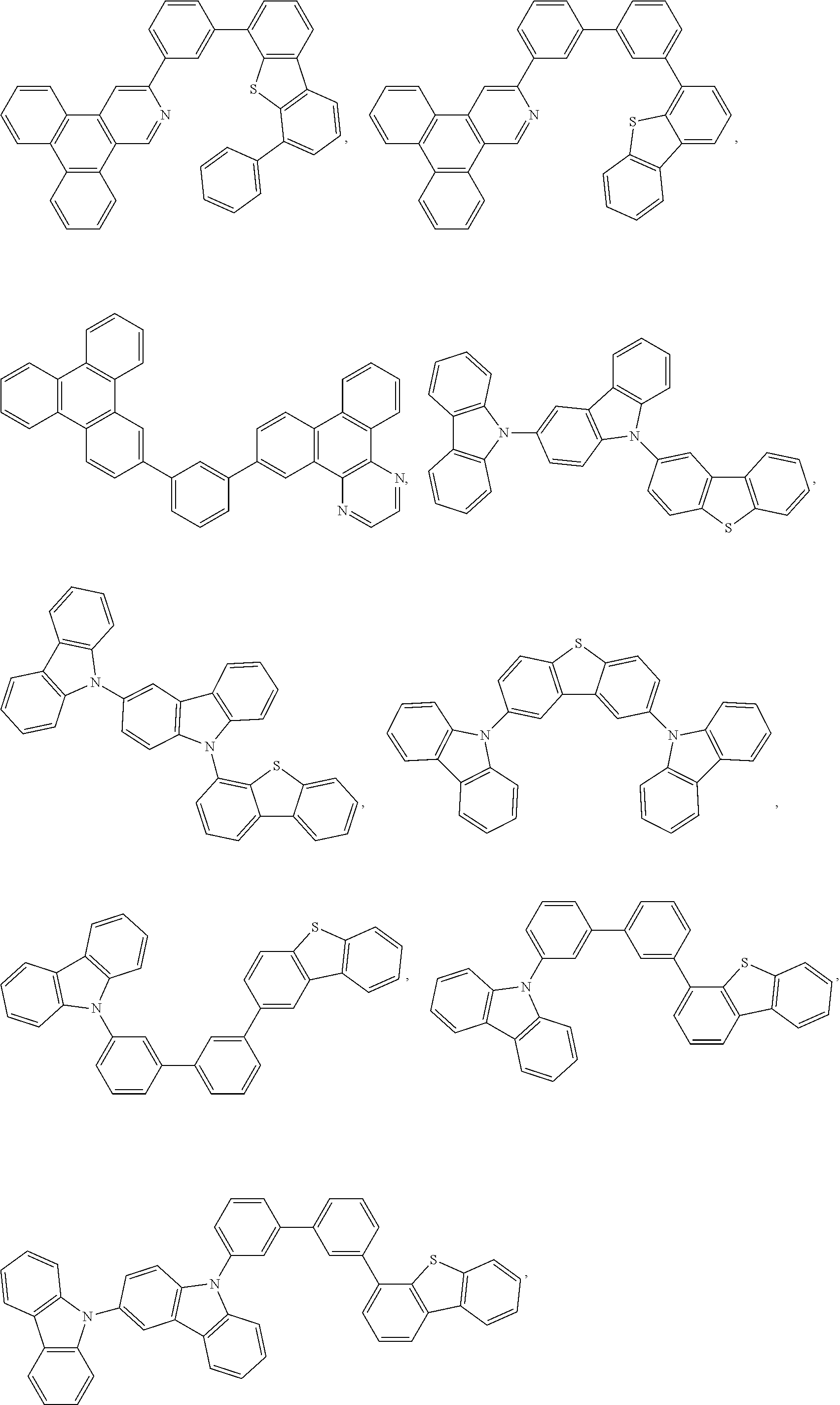
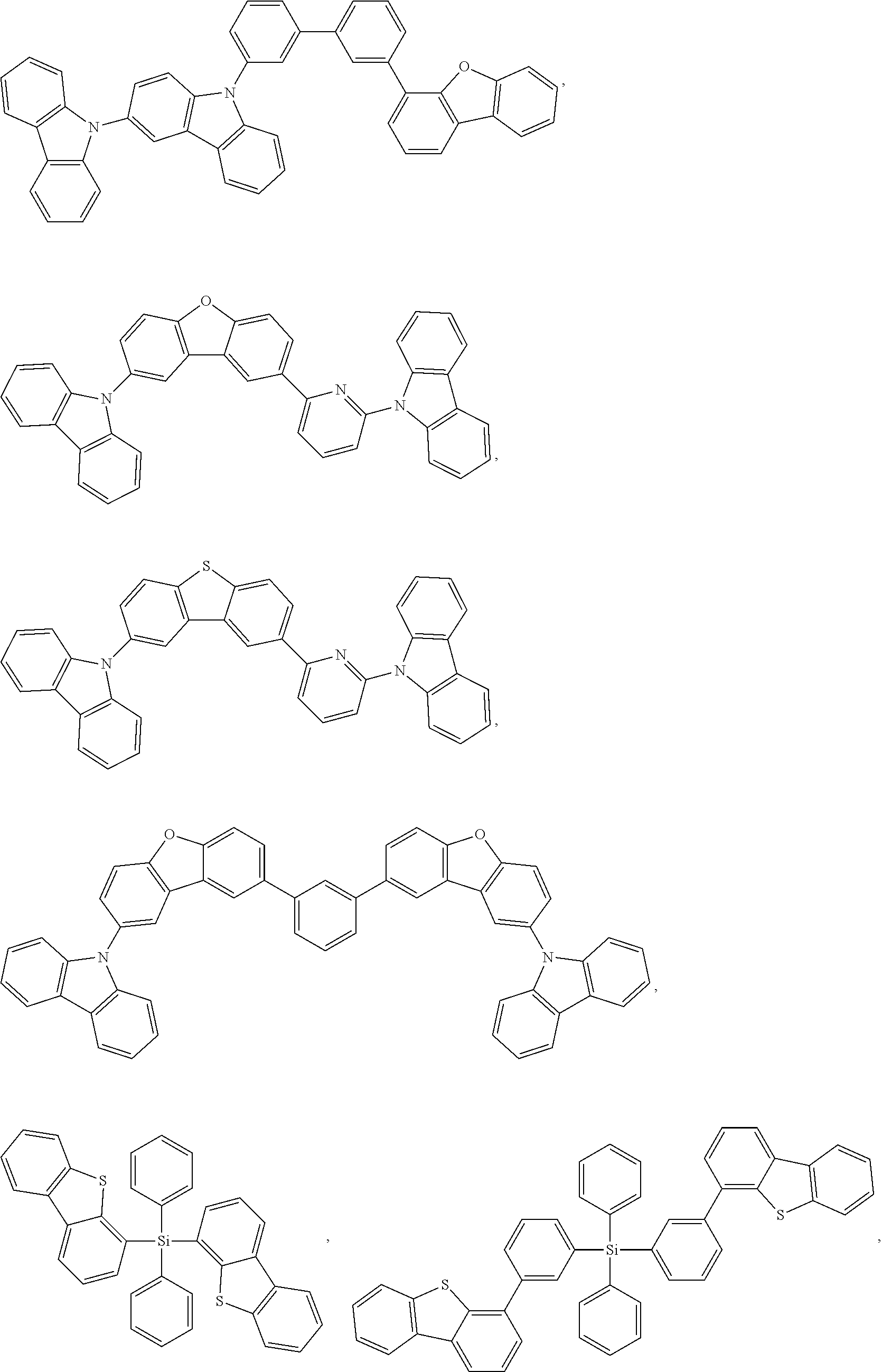
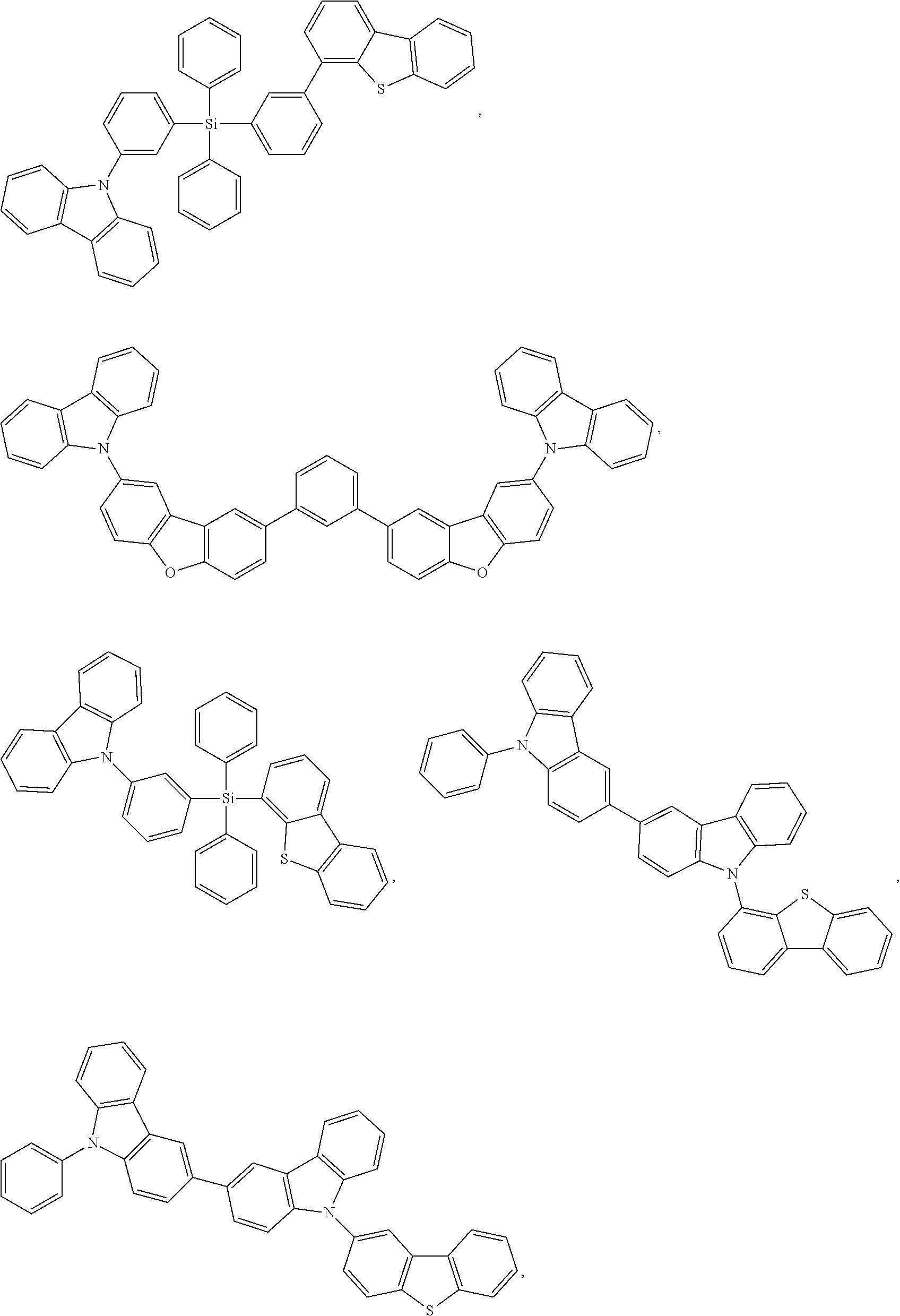
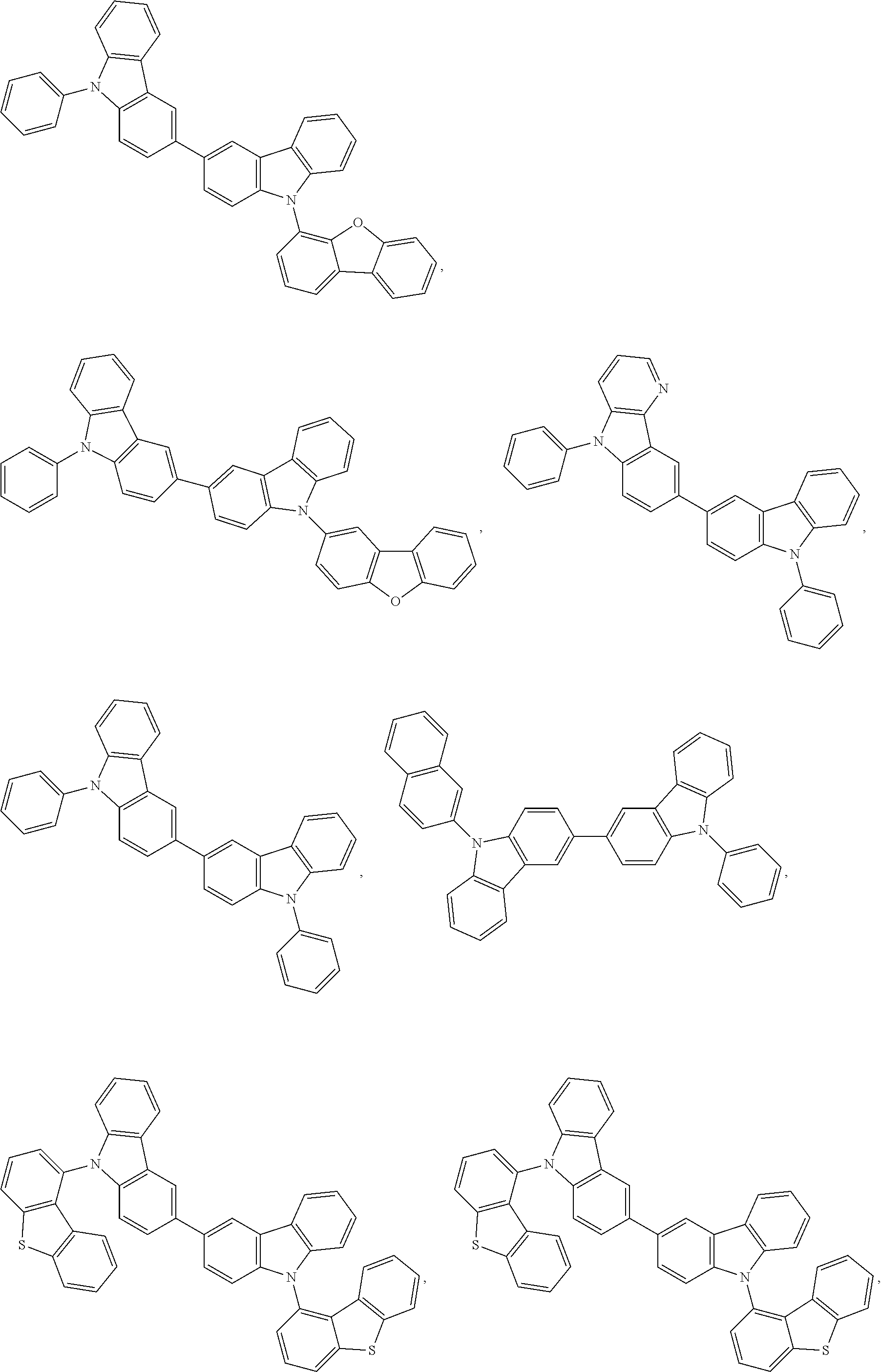
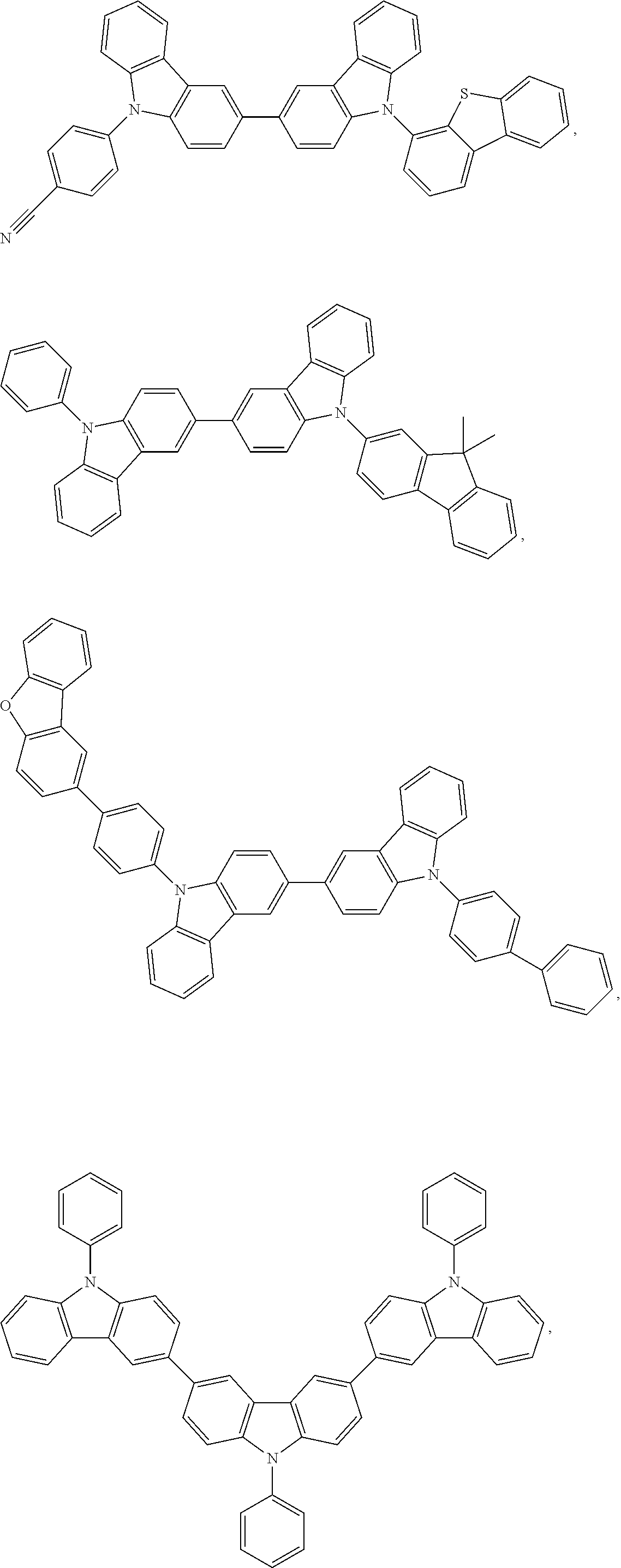

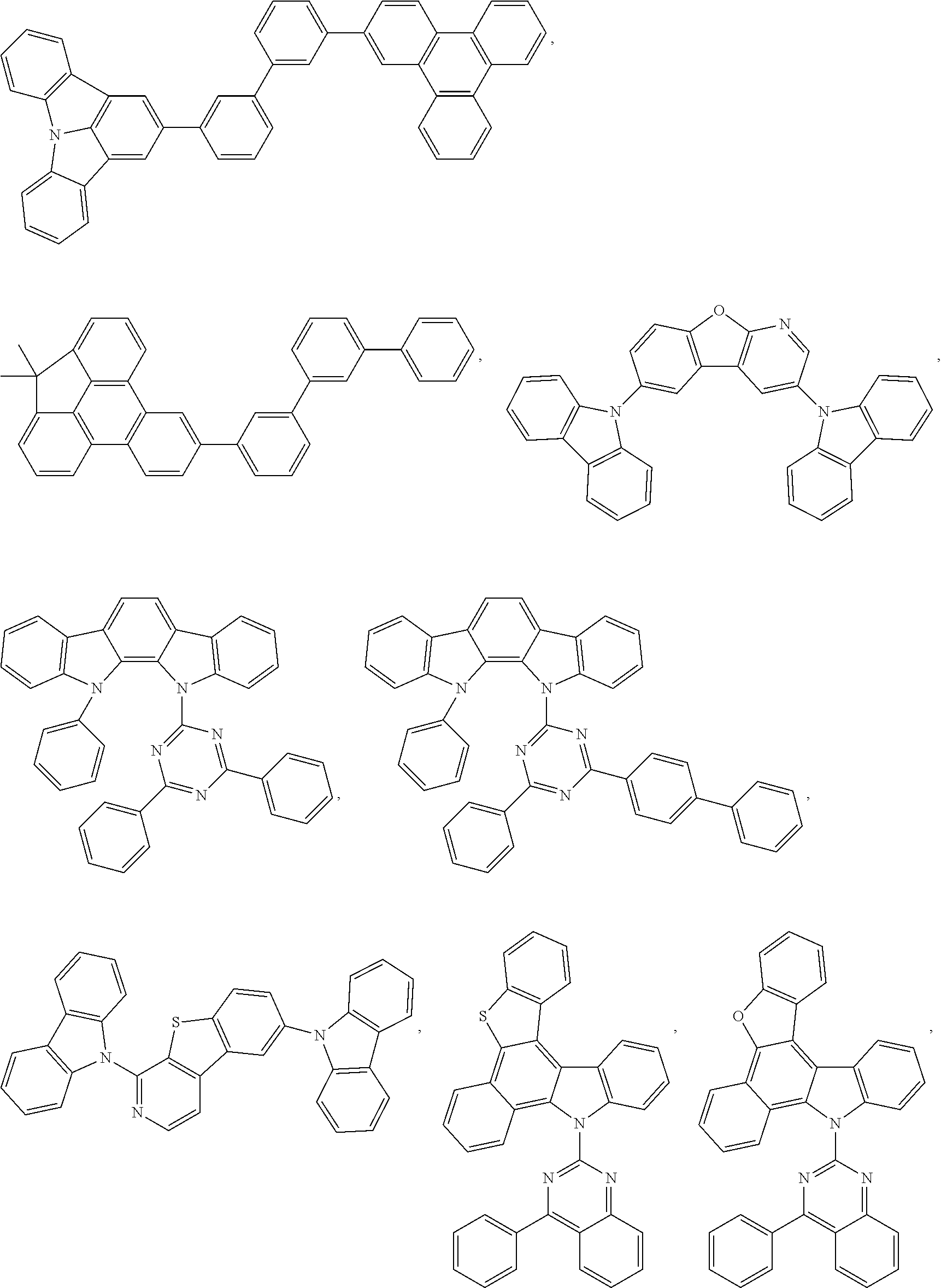
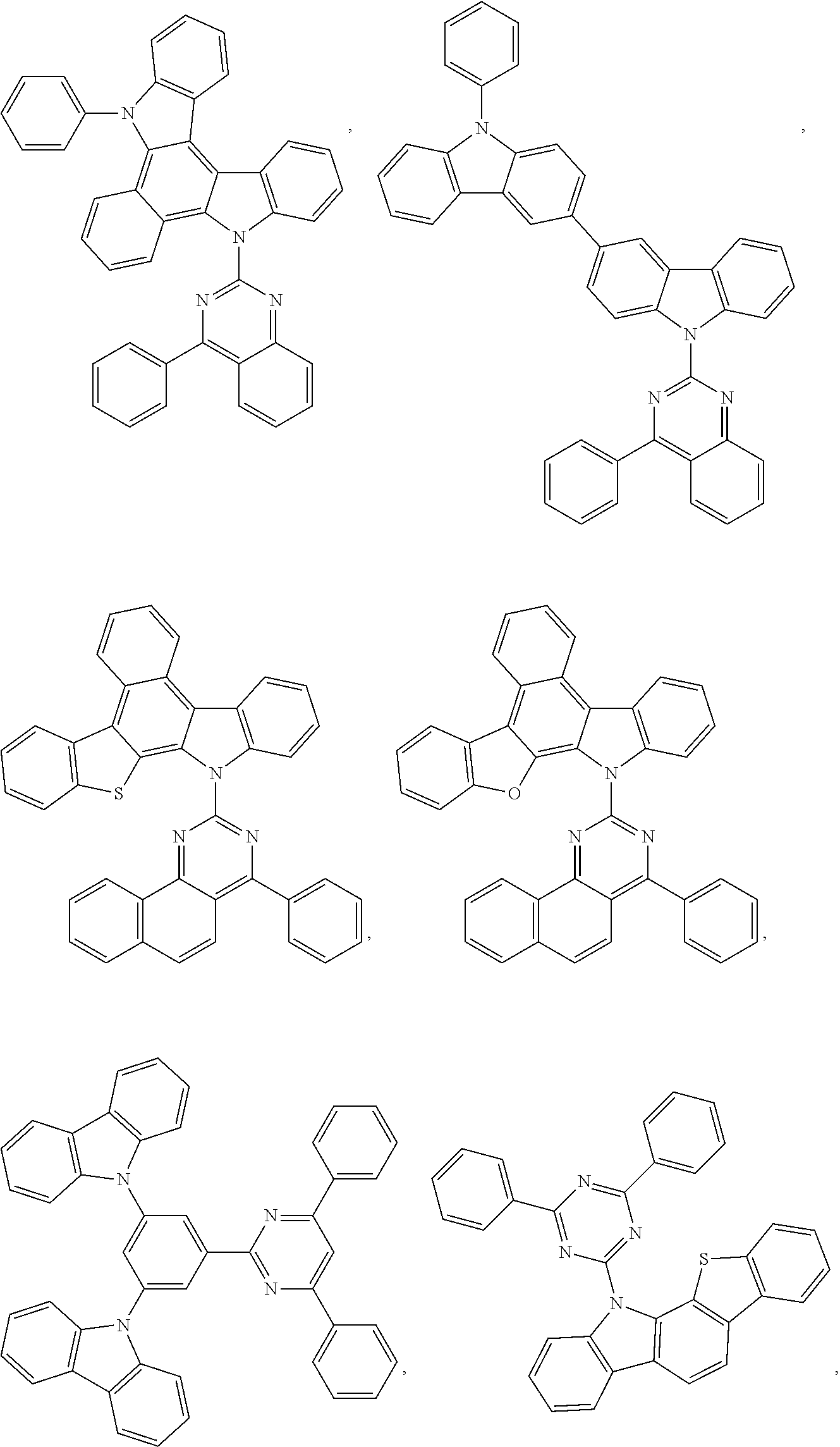
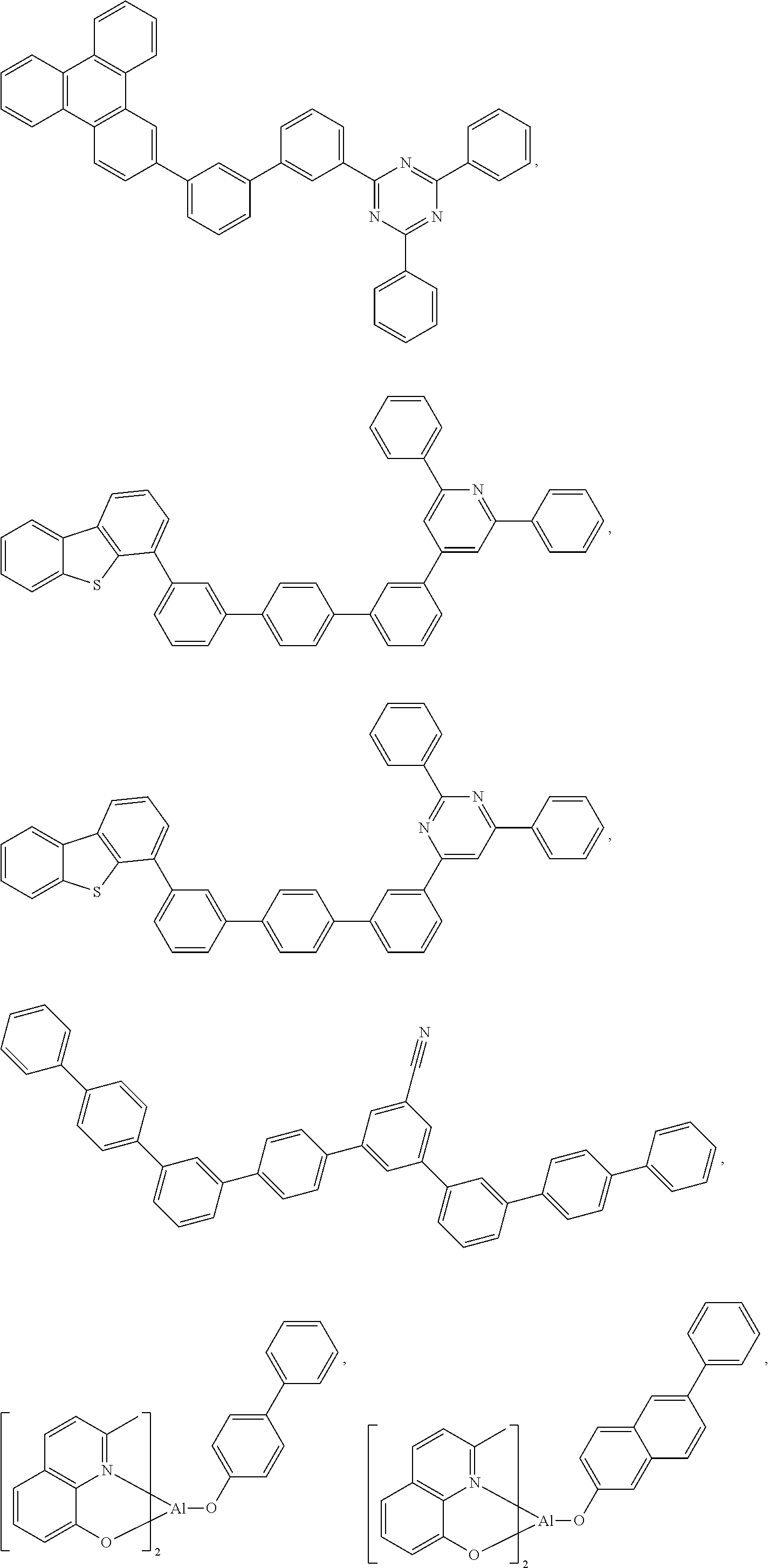
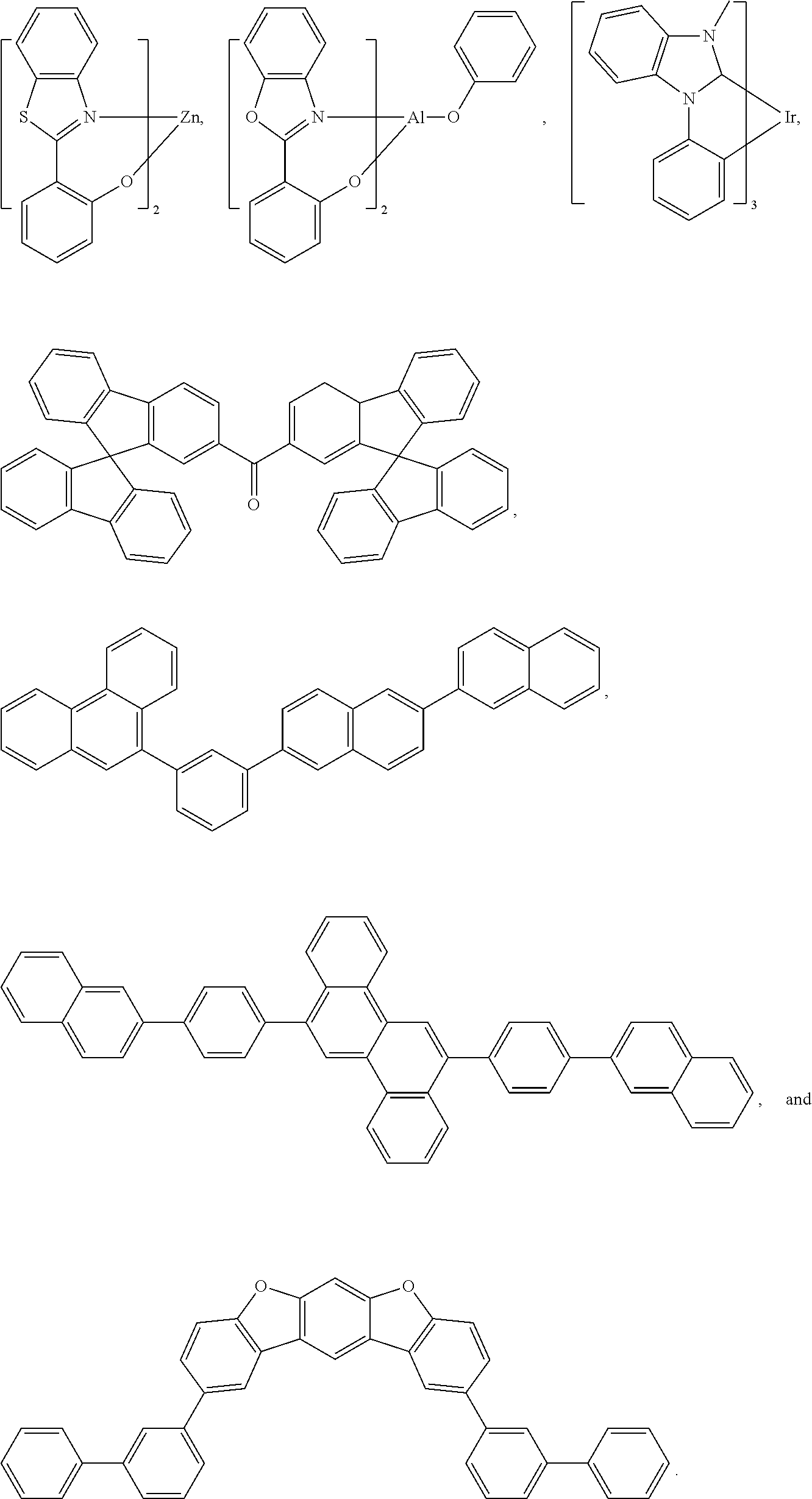















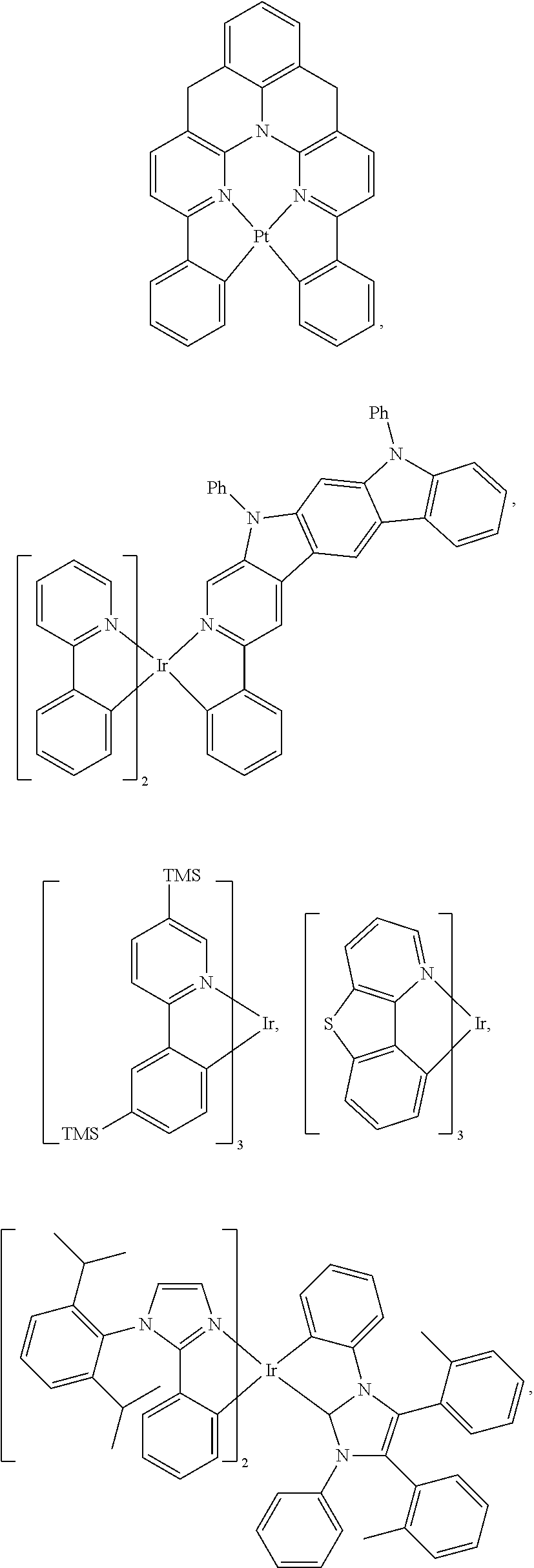


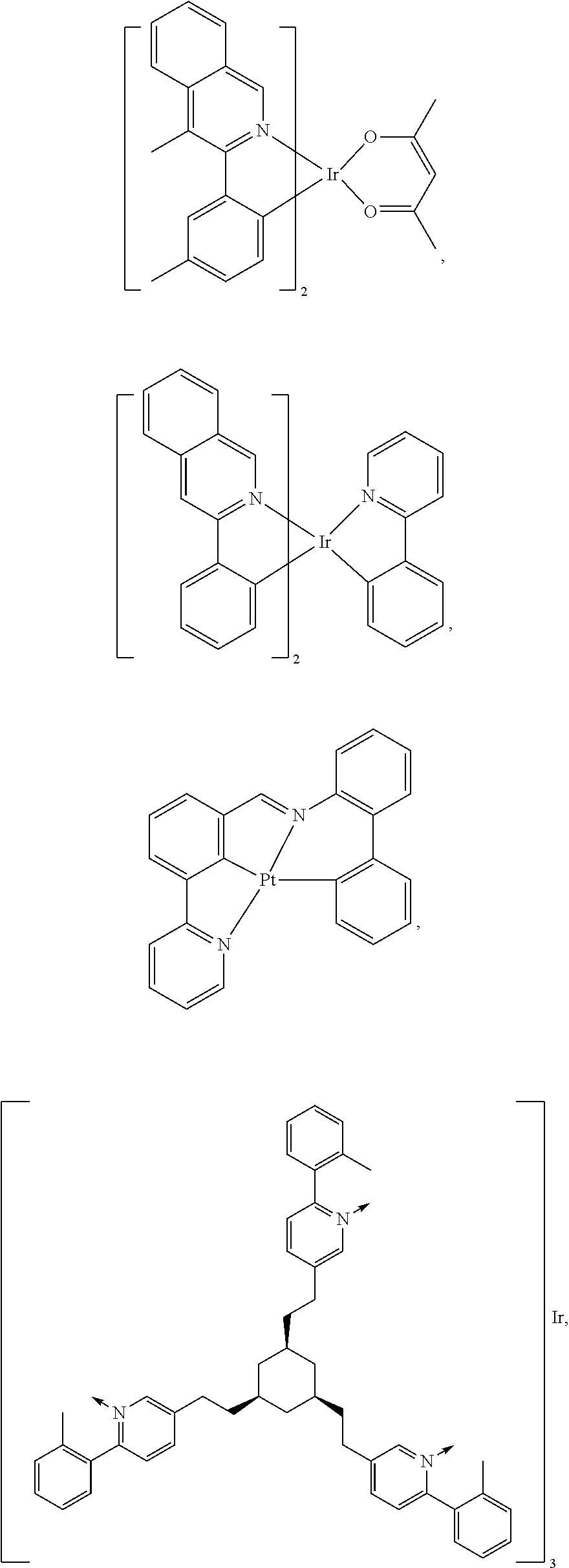



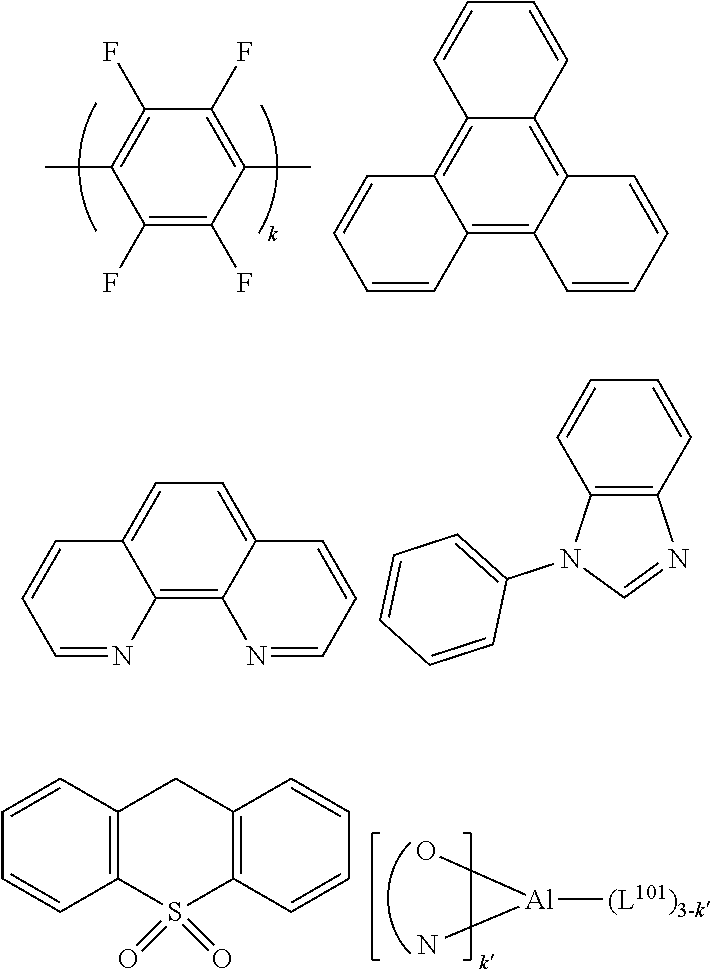

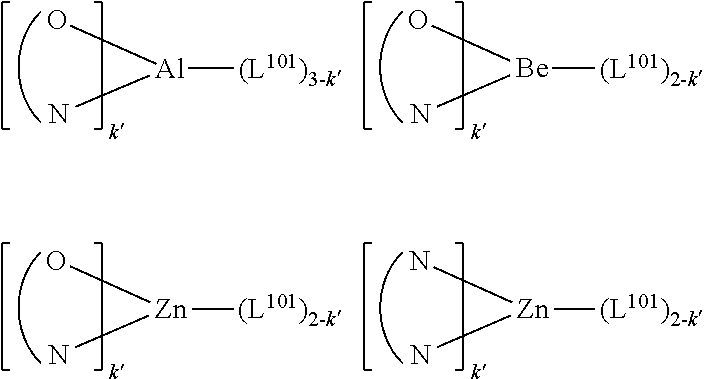
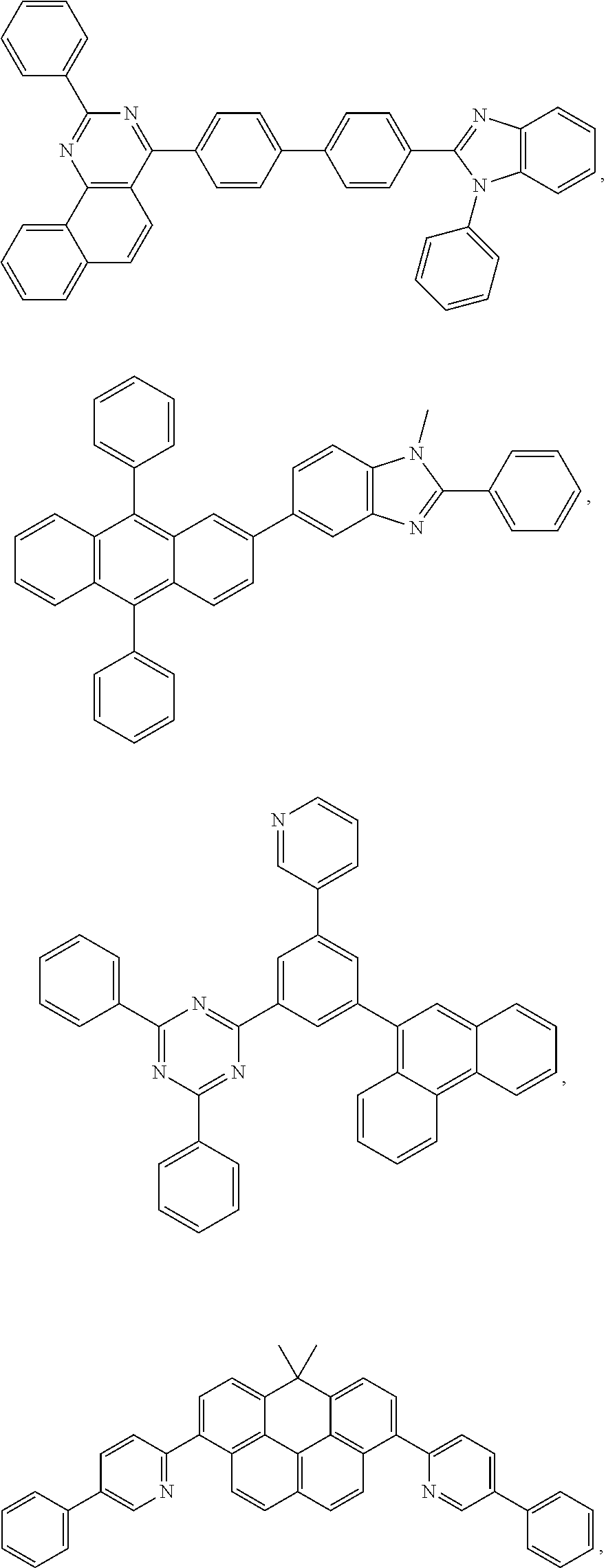


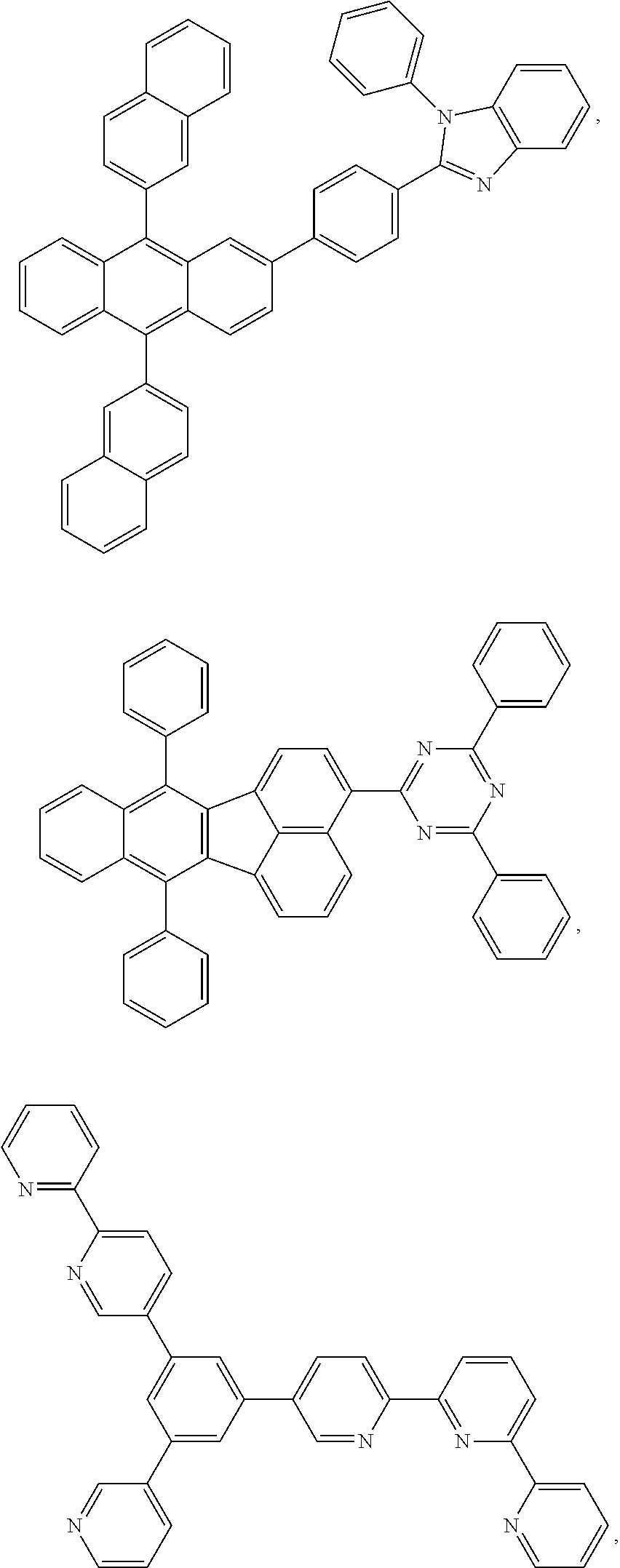



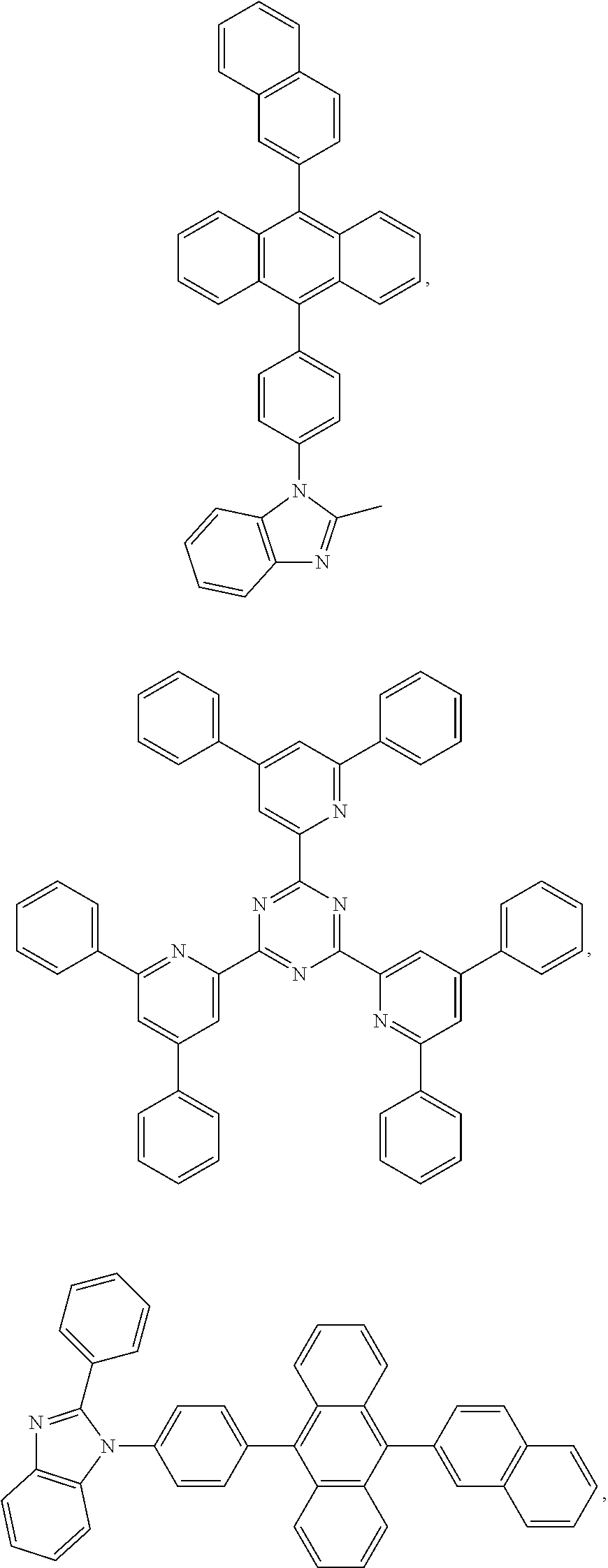

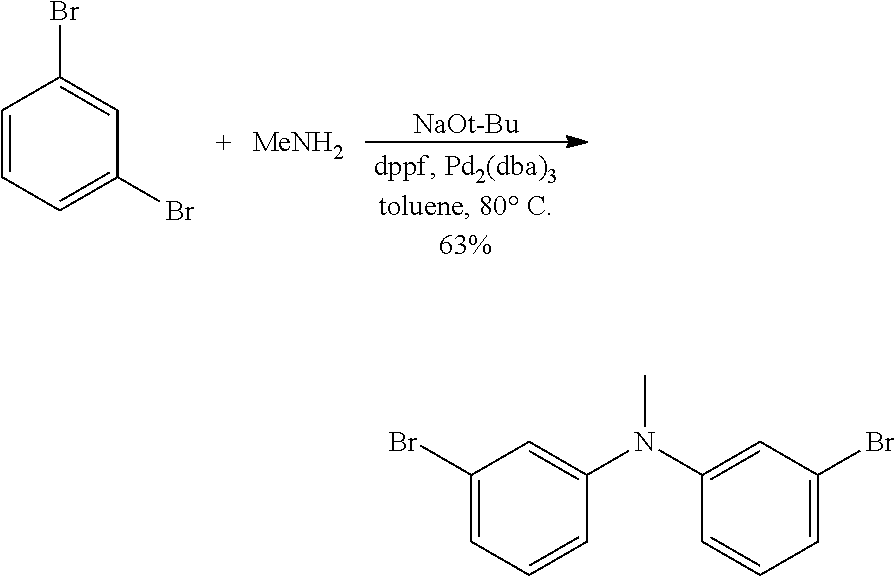


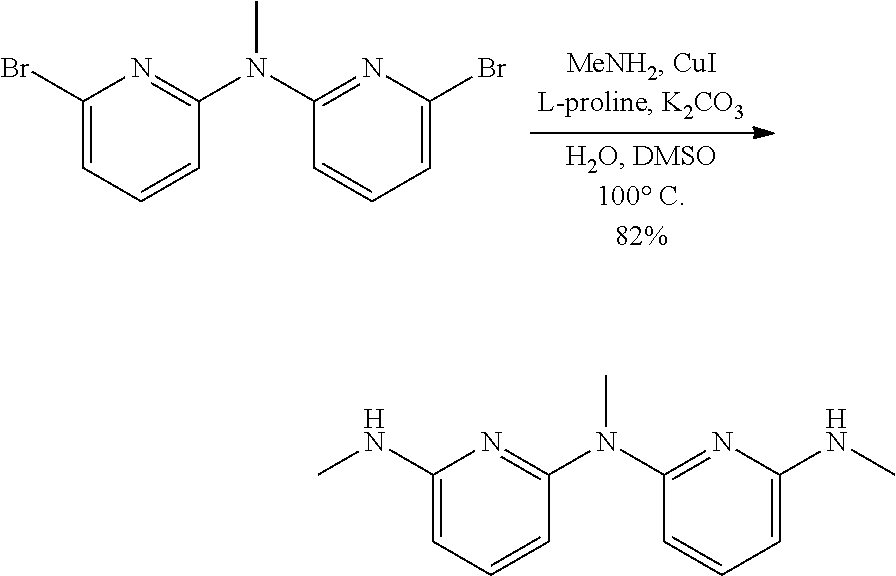

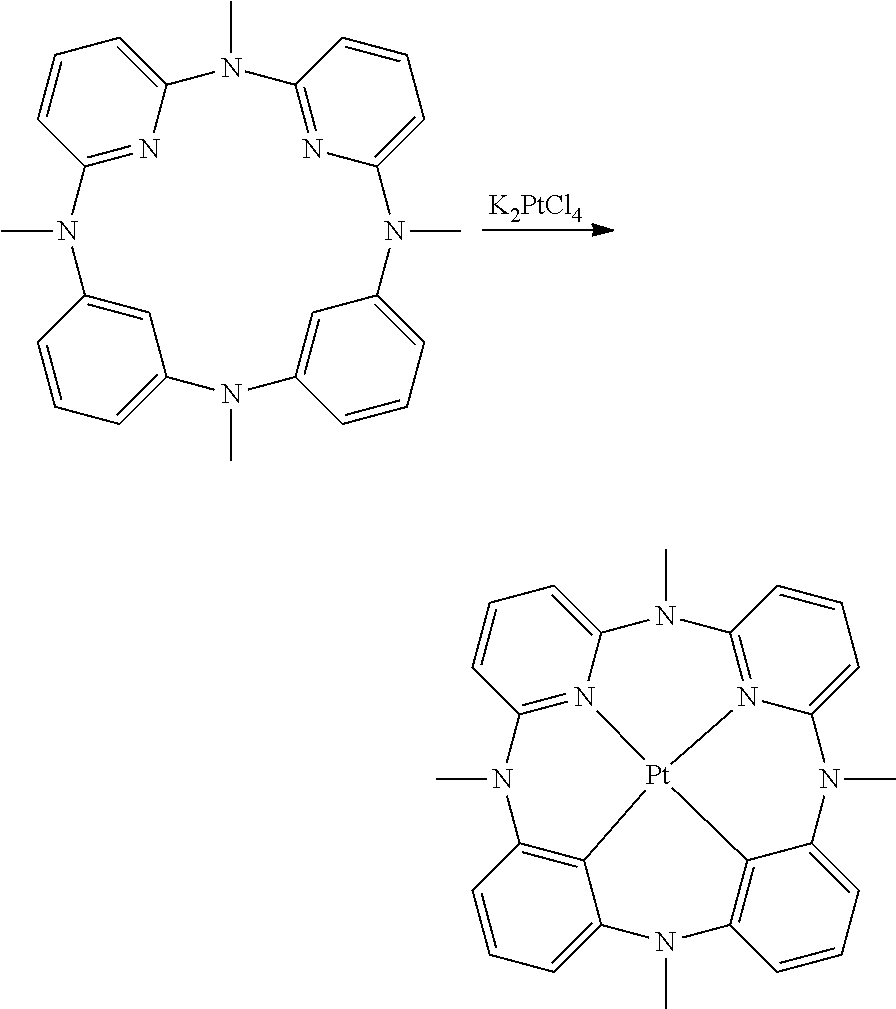
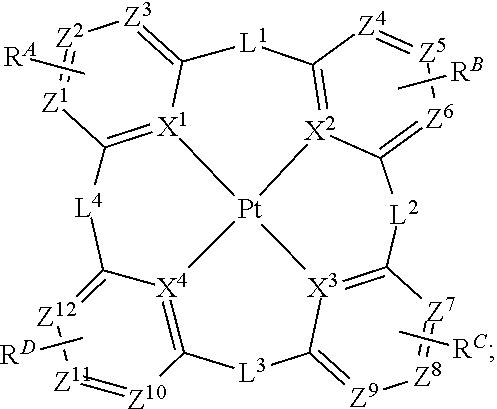

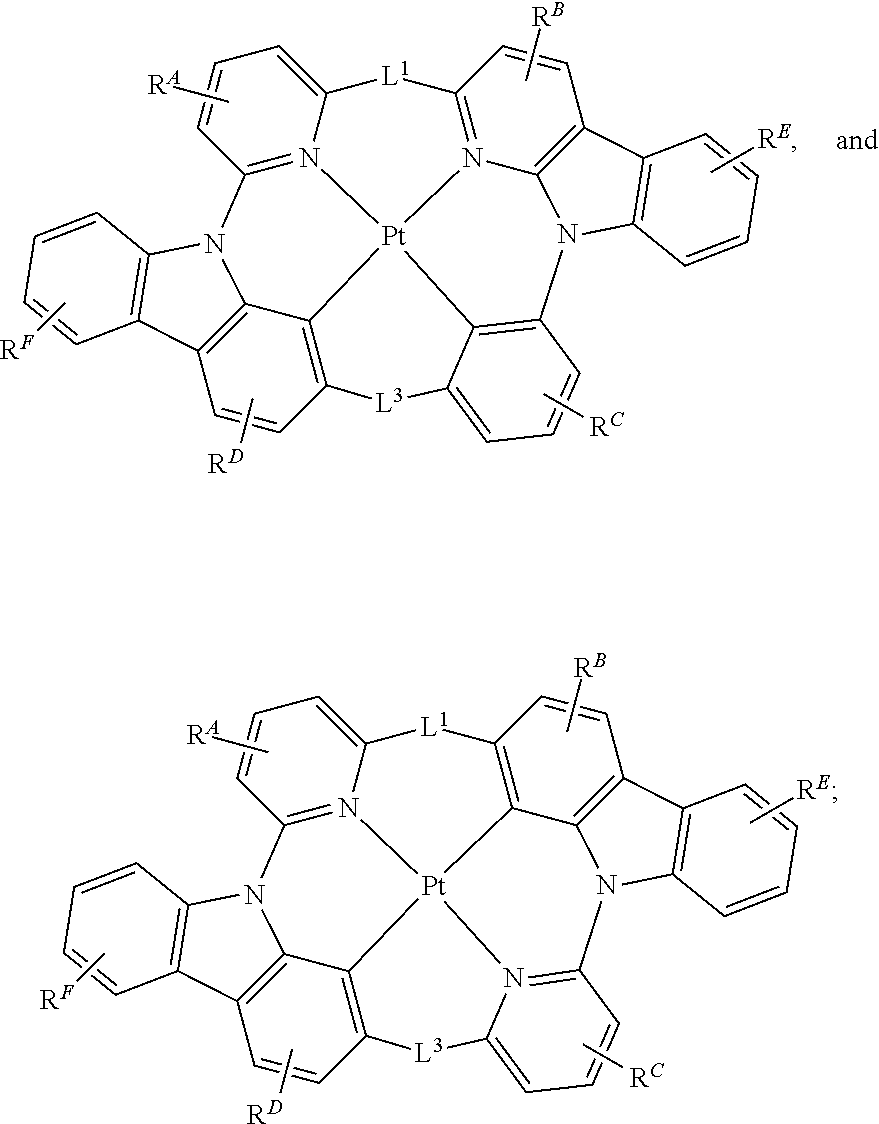
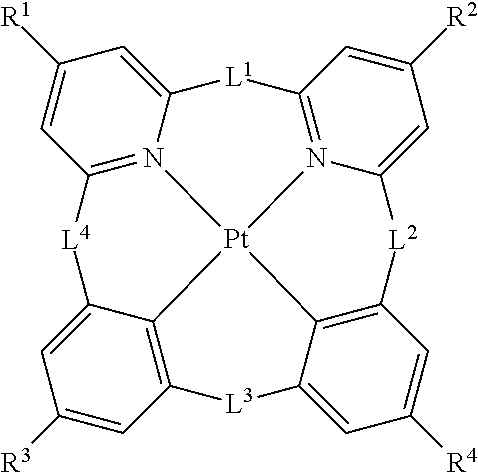
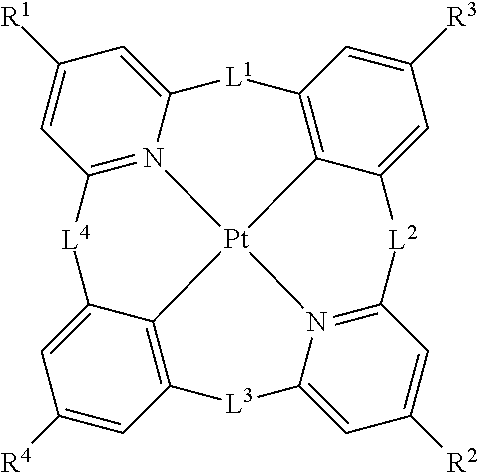


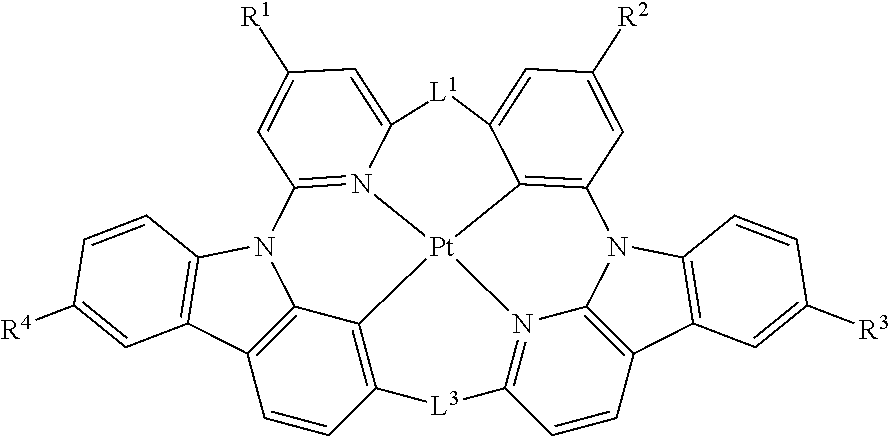
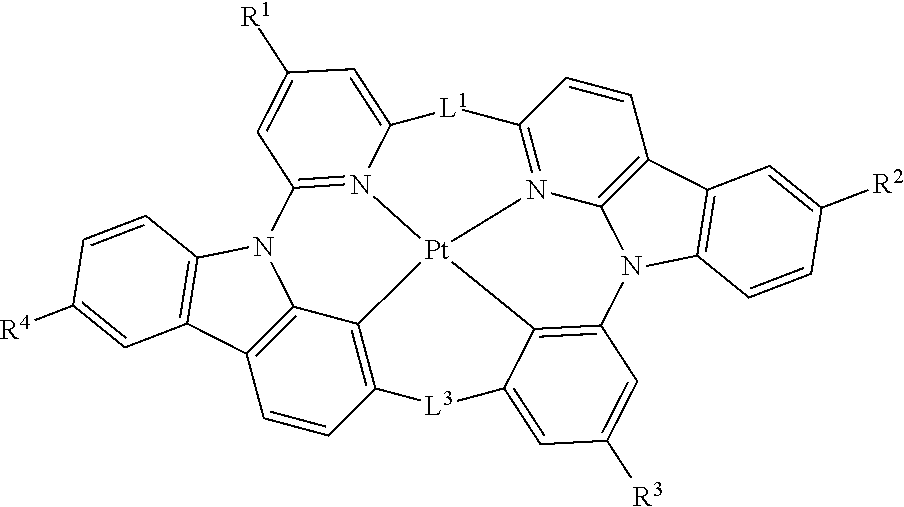
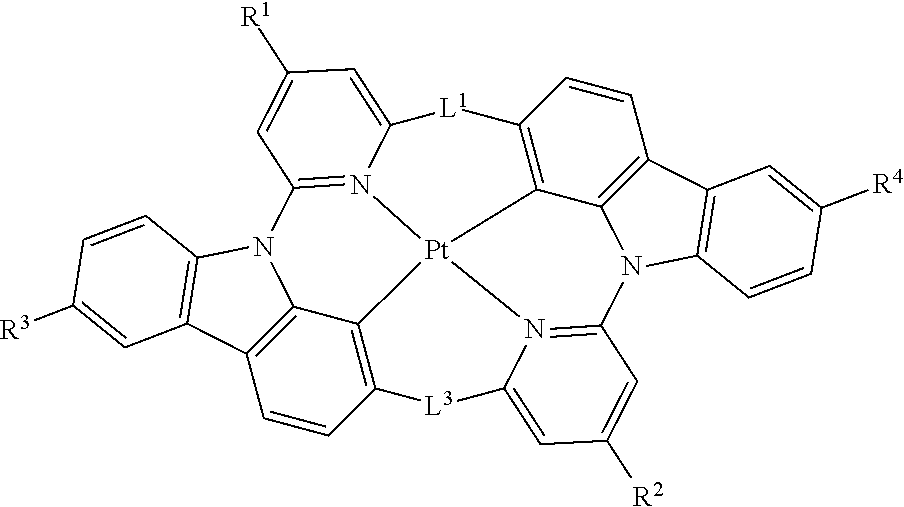

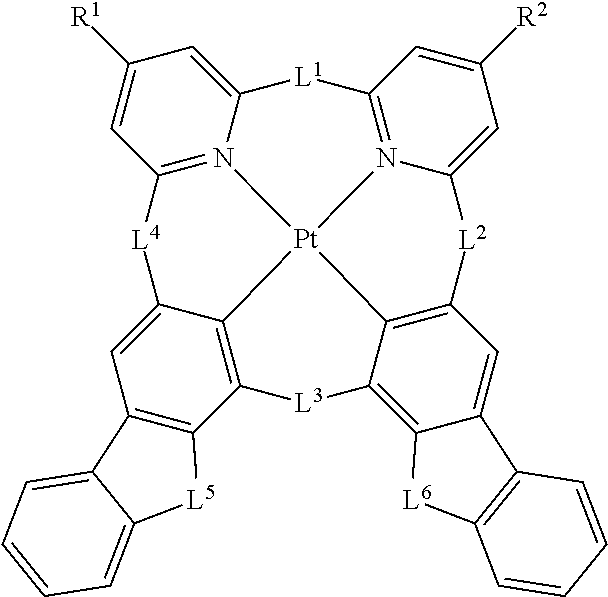
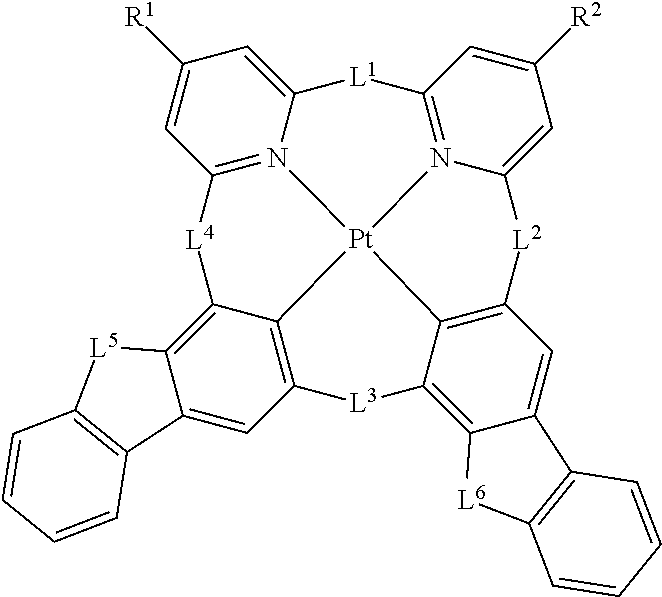
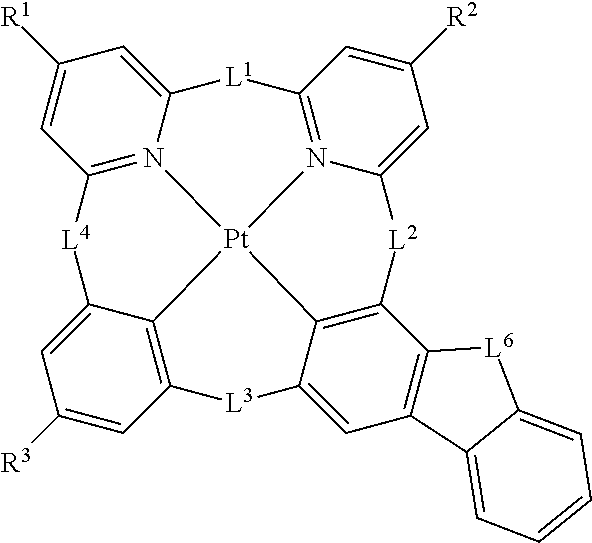
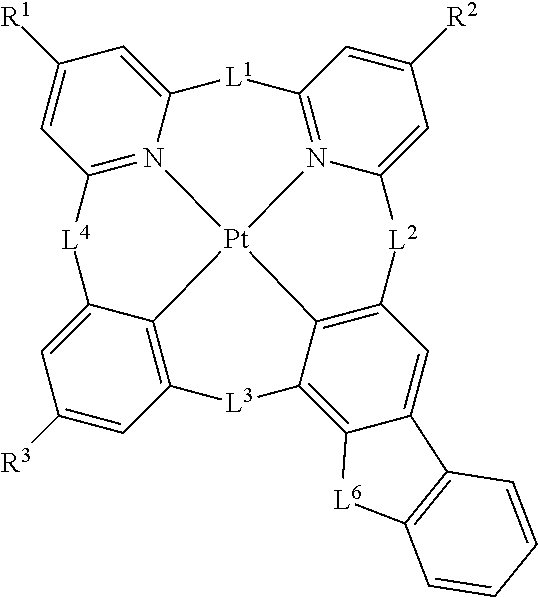

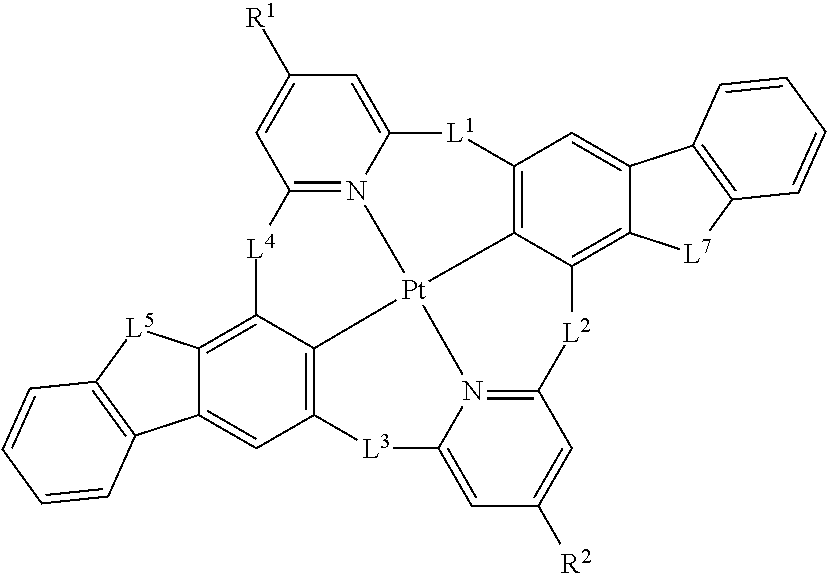
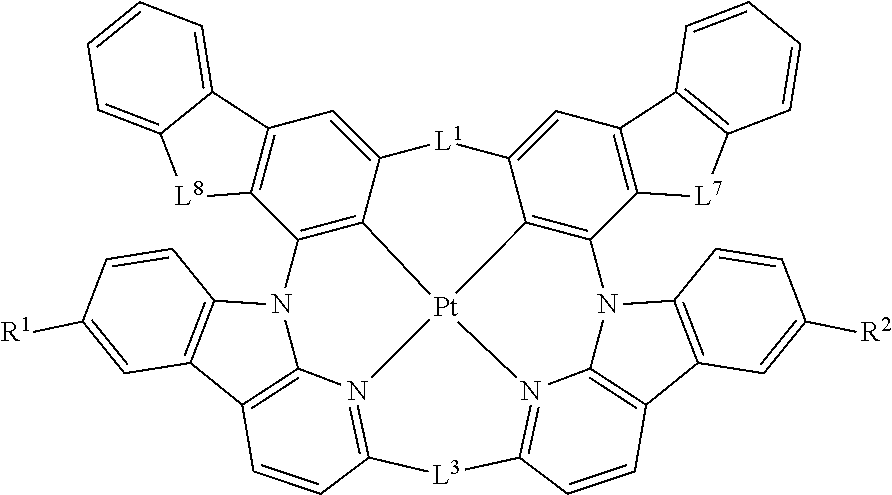

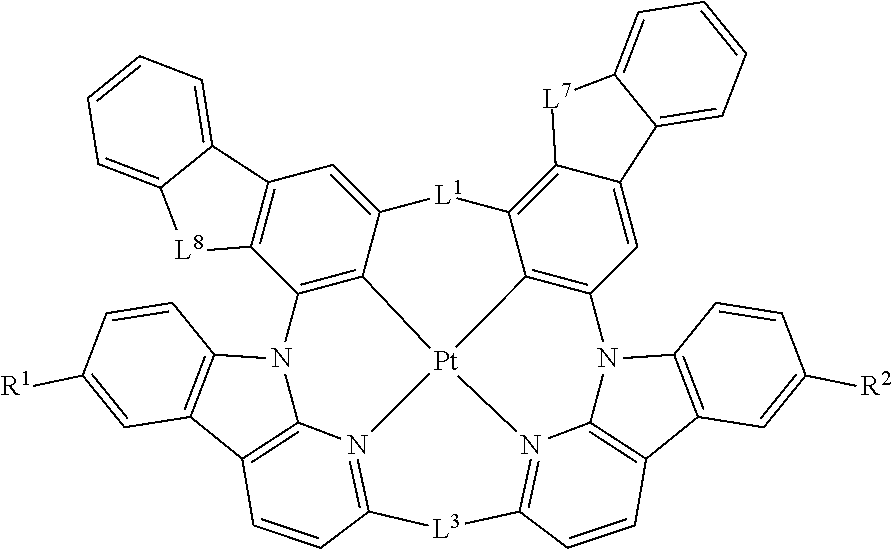
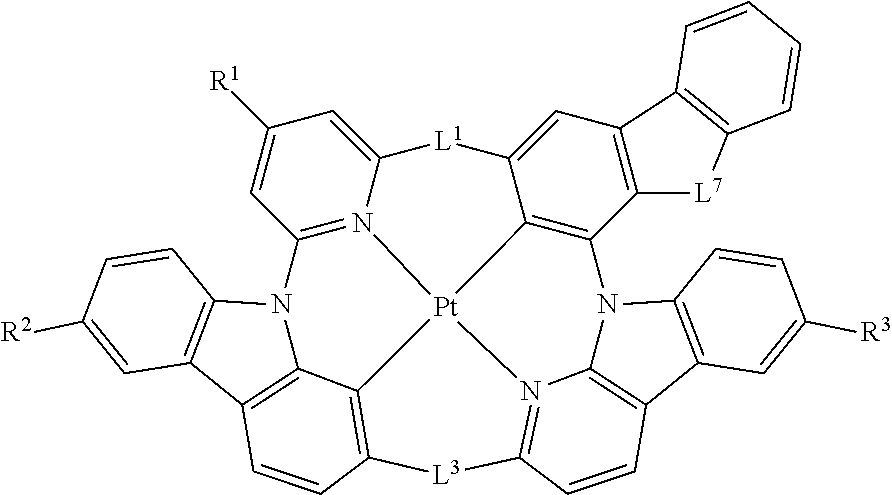
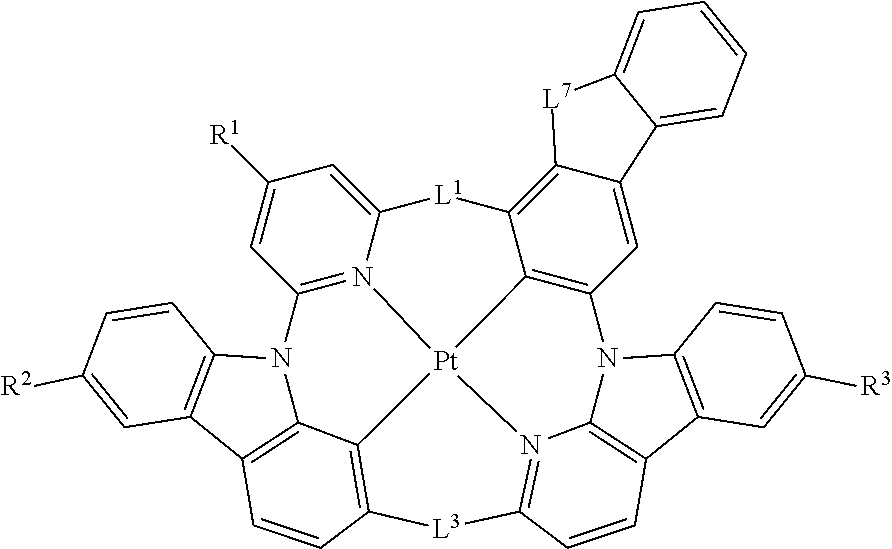
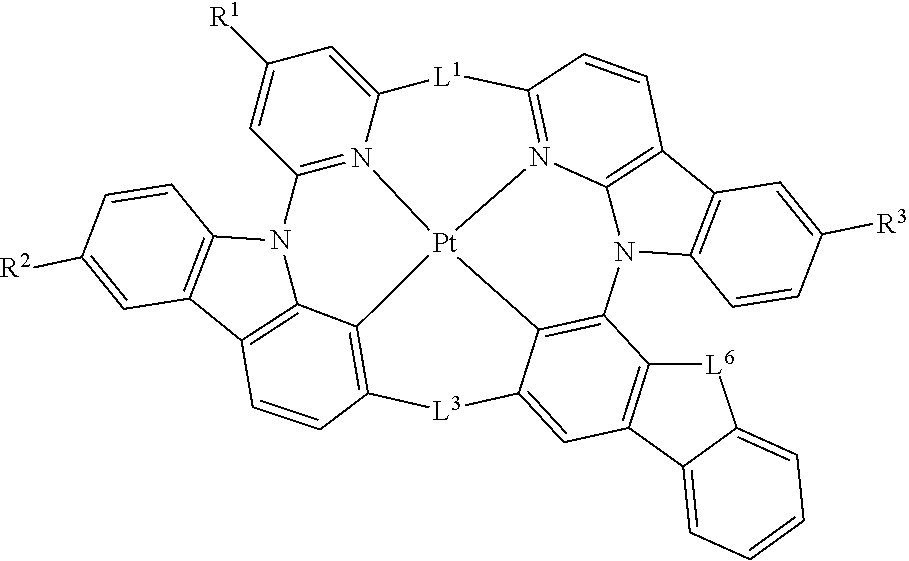





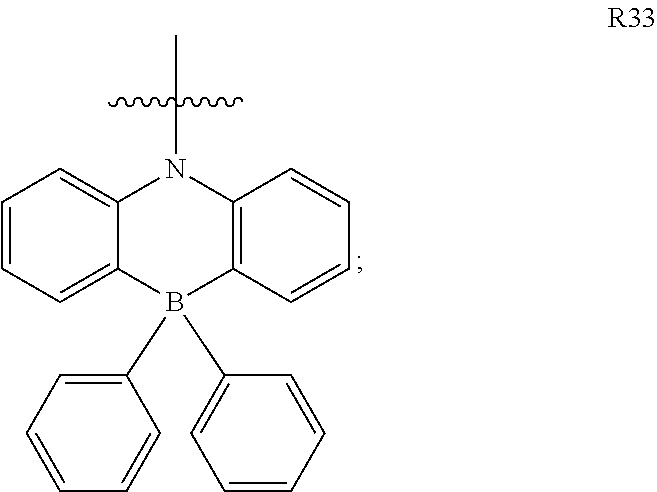


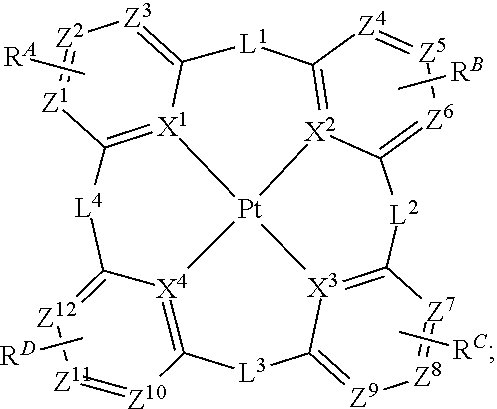






D00000

D00001
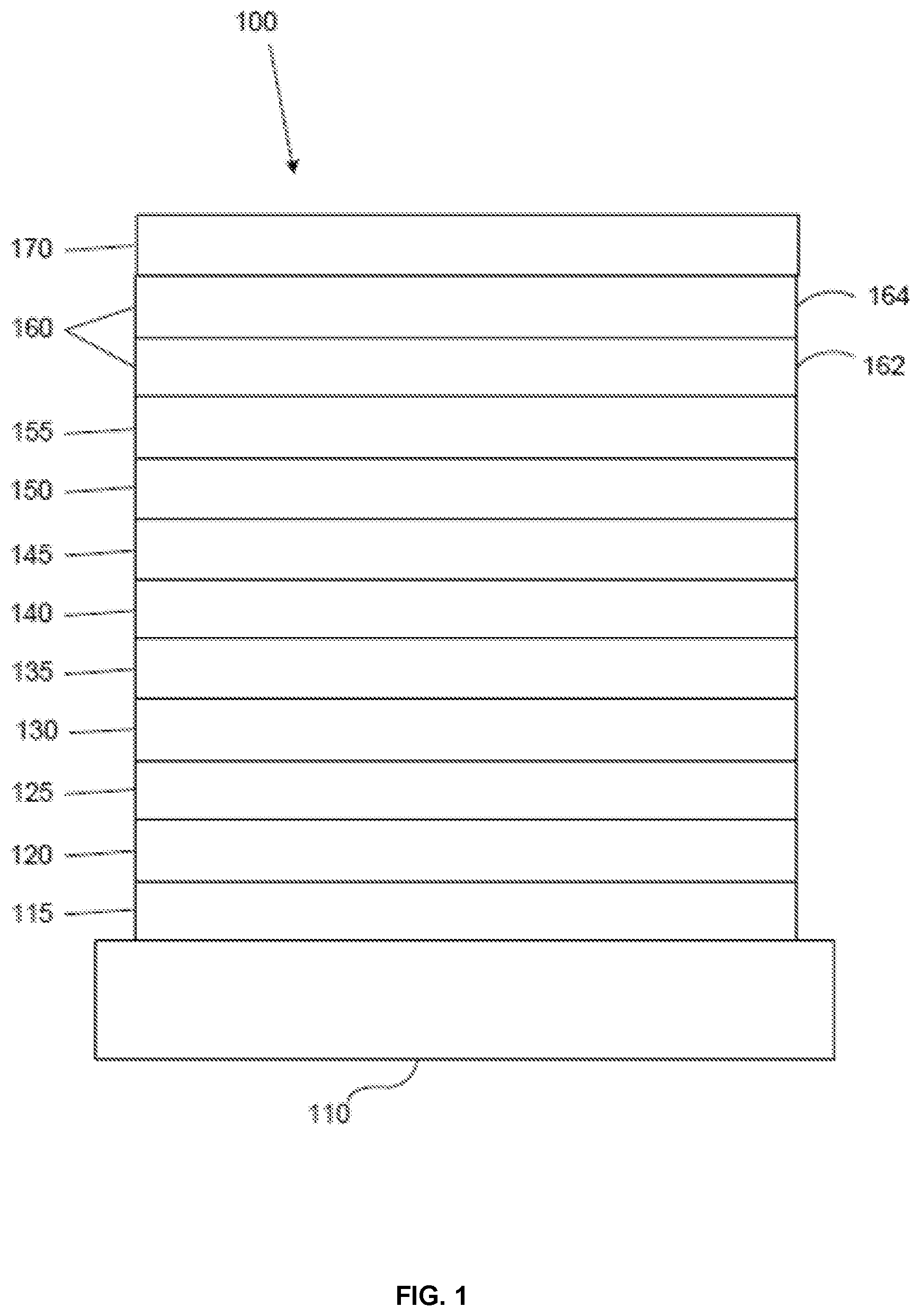
D00002
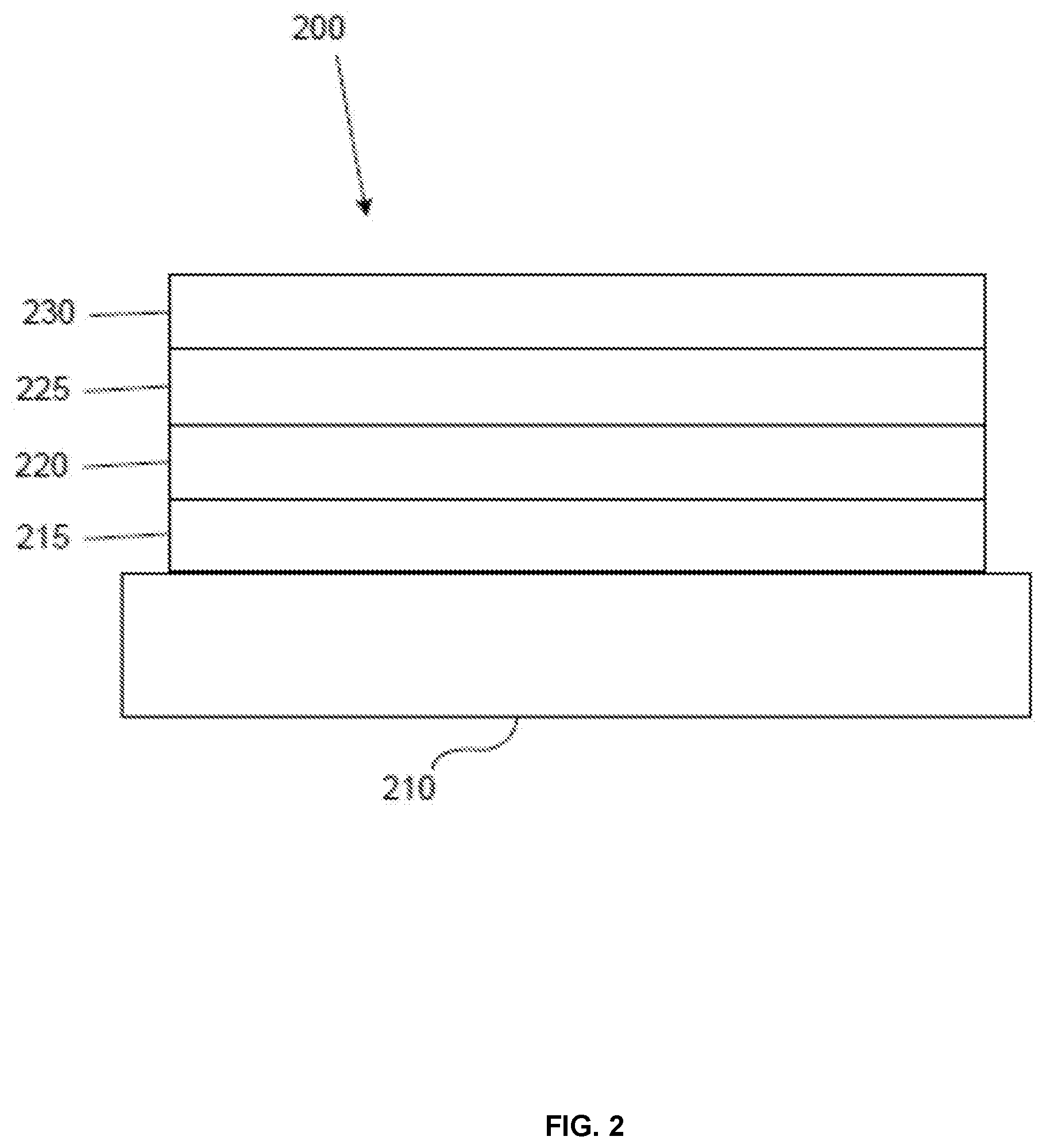
D00003
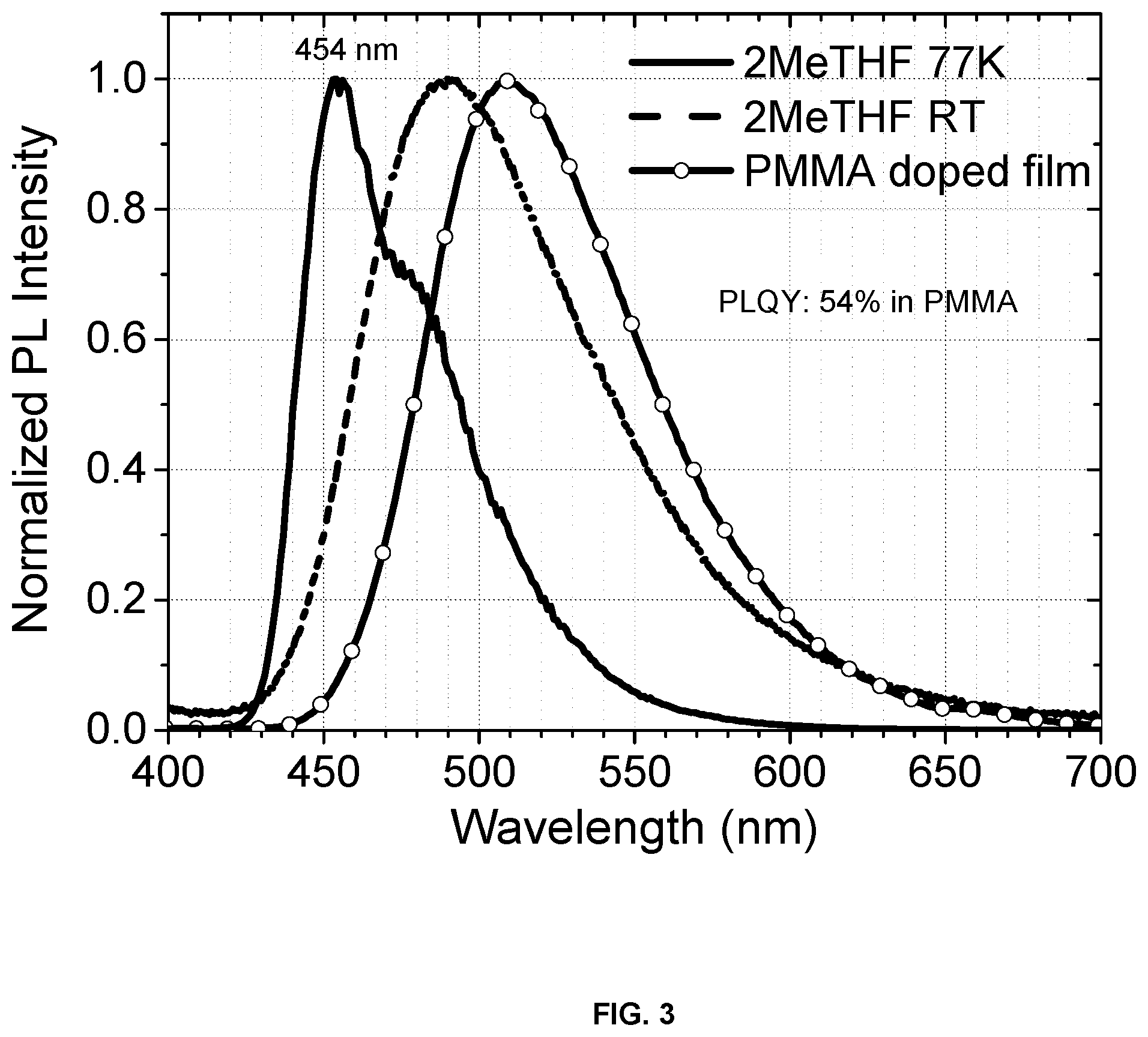
D00004
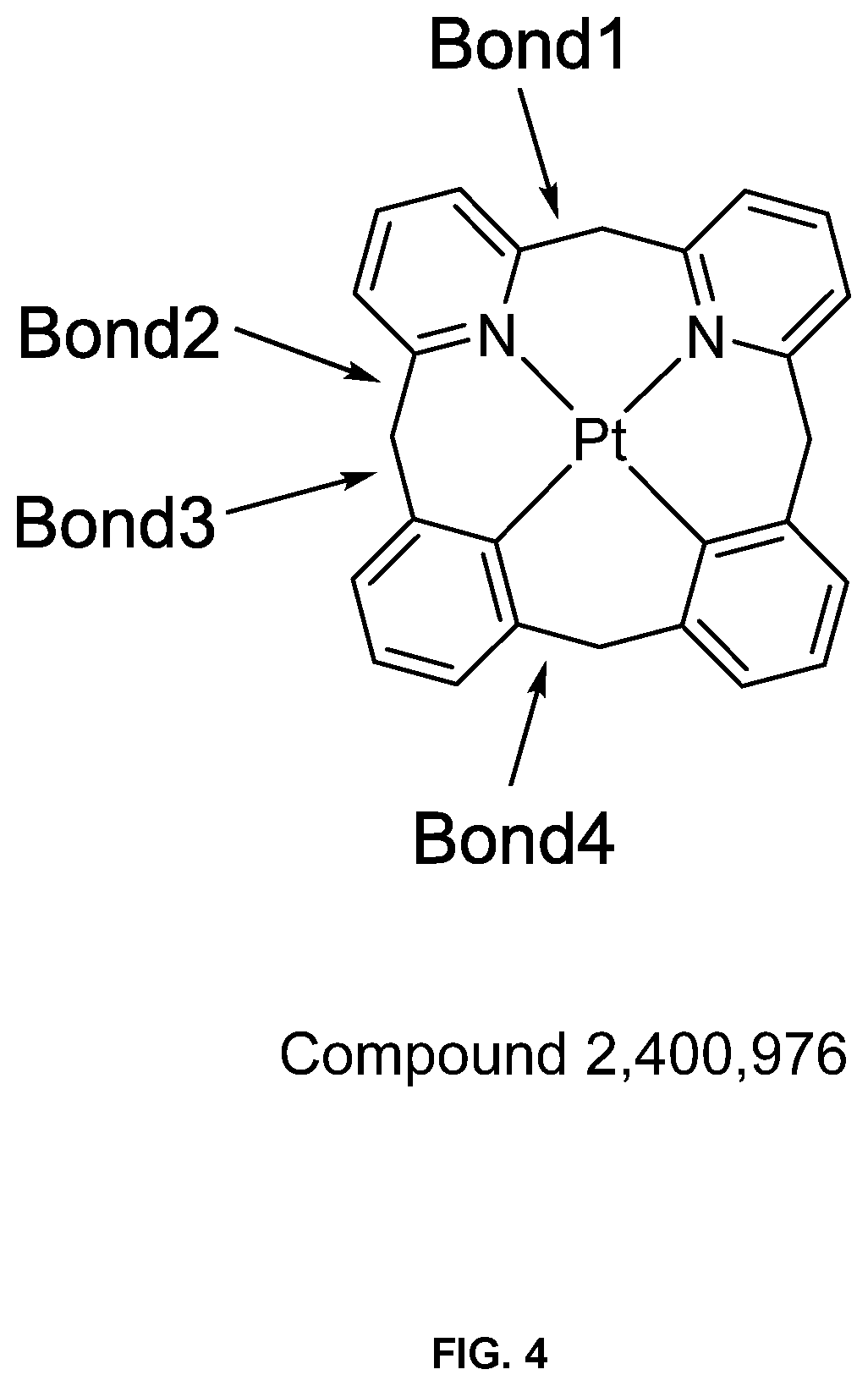
XML
uspto.report is an independent third-party trademark research tool that is not affiliated, endorsed, or sponsored by the United States Patent and Trademark Office (USPTO) or any other governmental organization. The information provided by uspto.report is based on publicly available data at the time of writing and is intended for informational purposes only.
While we strive to provide accurate and up-to-date information, we do not guarantee the accuracy, completeness, reliability, or suitability of the information displayed on this site. The use of this site is at your own risk. Any reliance you place on such information is therefore strictly at your own risk.
All official trademark data, including owner information, should be verified by visiting the official USPTO website at www.uspto.gov. This site is not intended to replace professional legal advice and should not be used as a substitute for consulting with a legal professional who is knowledgeable about trademark law.